- Skip to right header navigation
- Skip to main content
- Skip to secondary navigation
- Skip to primary sidebar
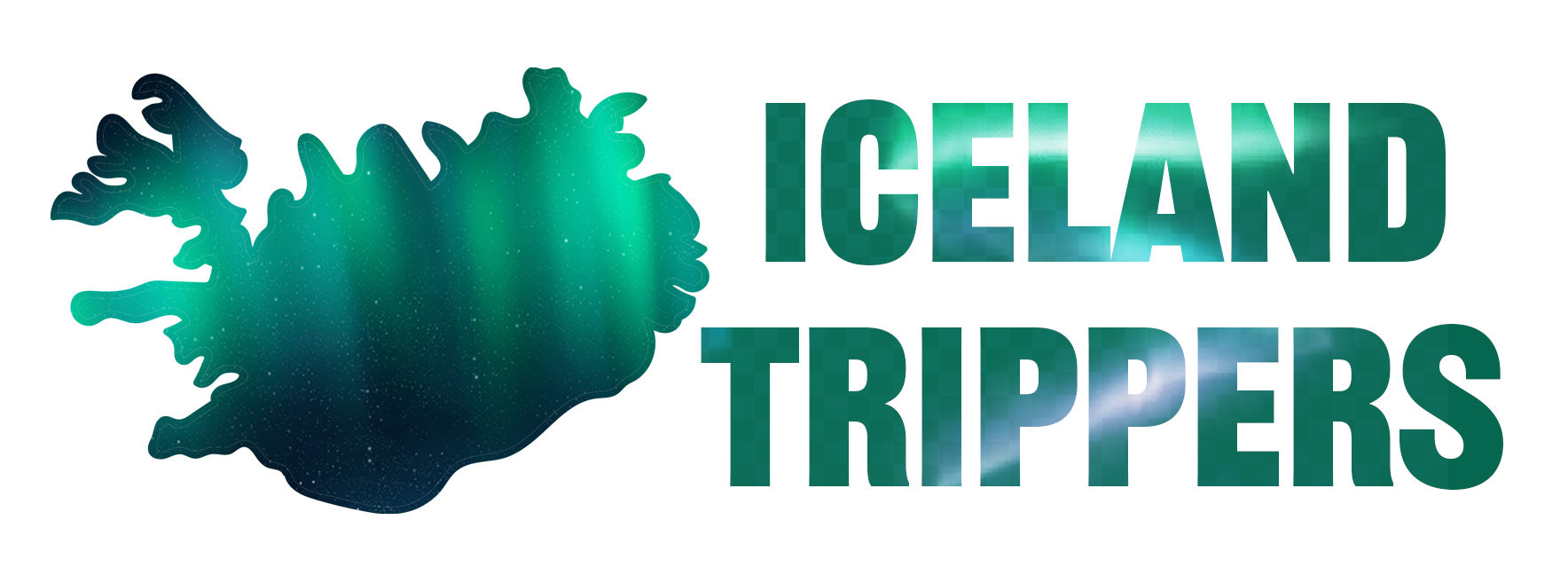
Learn how to easily plan your dream trip to Iceland with helpful guides and tips!
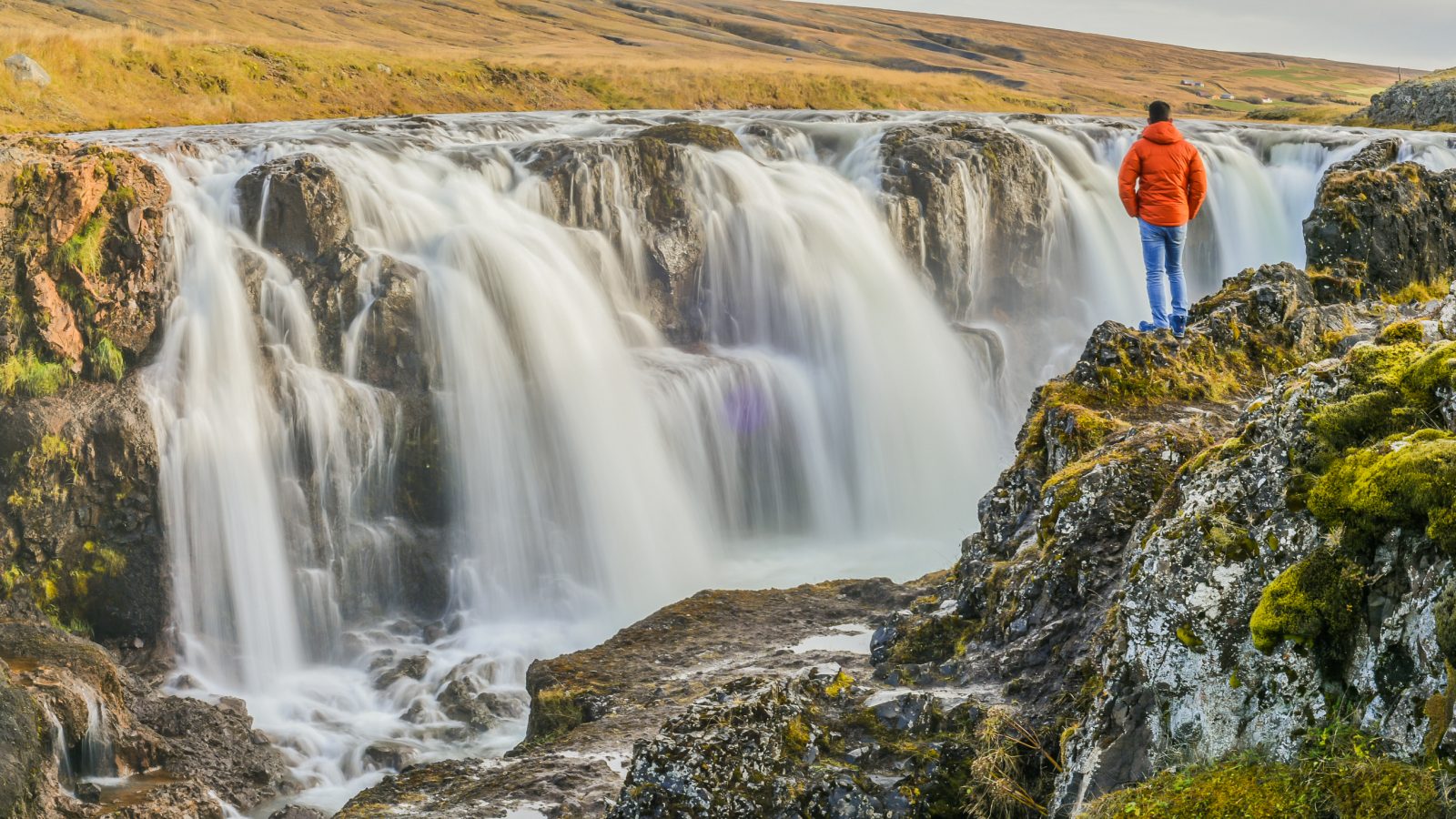

18 Best Places To See in North Iceland
June 28, 2020 // by Iceland Trippers // Leave a Comment
North Iceland has no shortage of stunning and breathtaking landscapes to take in! If you are driving the whole Ring Road In Iceland , you are in for a real treat.
The scenery is vast and ever-changing. From craters of bright blue water to powerfully thundering waterfalls to towns that revert you to the beginnings of civilization.
North Iceland has endless adventure and is steeped in rich cultural history that permeates in almost every structure and attraction you will visit!
Some of the attractions may be far apart, or a relatively long hike, but if you are interested in seeing some unforgettable landscapes, or the panoramic view from the Island of Birds it is worth adding to your Iceland Itinerary! Get a FREE printable “Hidden Gems In Iceland” E-book by joining our private Iceland Facebook Group and share your photos and ask for tips and tricks.
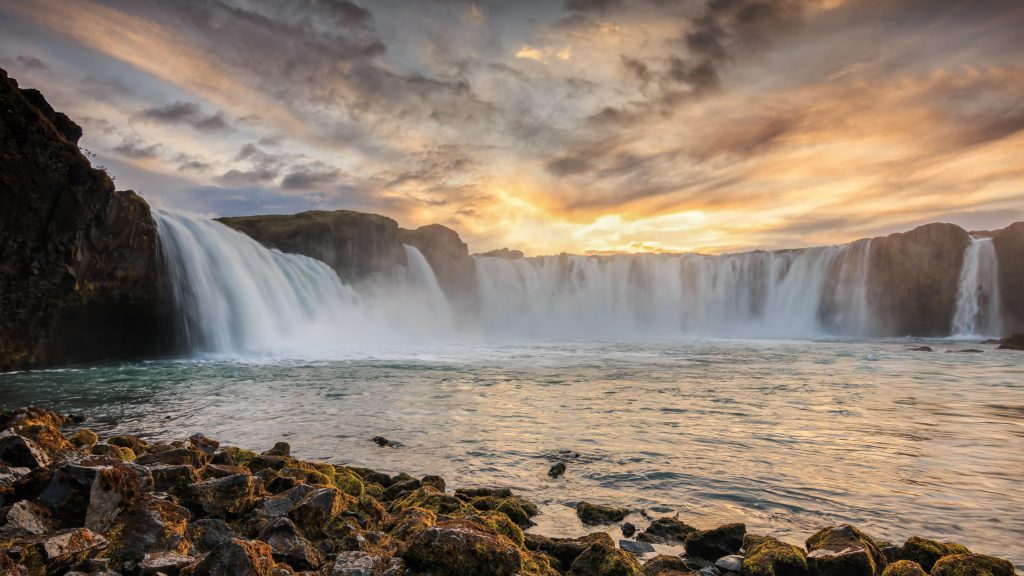
Detifoss and Selfoss
Detifoss and Selfoss are two stunningly impressive waterfalls in North Iceland. Fed by the Jökulsá á Fjöllum River, these waterfalls are two you do not want to skip on your next trip. They are located in one of the more remote National Parks in Iceland!
The power and majesty of Detifoss is unmatched. The thundering of this magnificent natural force will captivate you. It is said to be the most powerful waterfall in iceland and you will undertamd why once you are standing near its raging waters.
Selfoss is just s short half mile walk from Detifoss. When it comes to power, there is no comparison between the two, however, Selfoss is a beatufil majestic waterfall that deserves to been seen.
It’s peaceful to see the horse shoe shaped waterfall plunge from both sides into the canyon.
When visiting Detifoss you will find that there are two parking lots to choose from, East and West. Each has its on distinct view of the waterfall.
With Detifoss being such a large and powerful waterfall, it makes sense that the parking lots are relatively far from each other. They are about an hour apart, so sticking to one before you start out will save a lot of time.
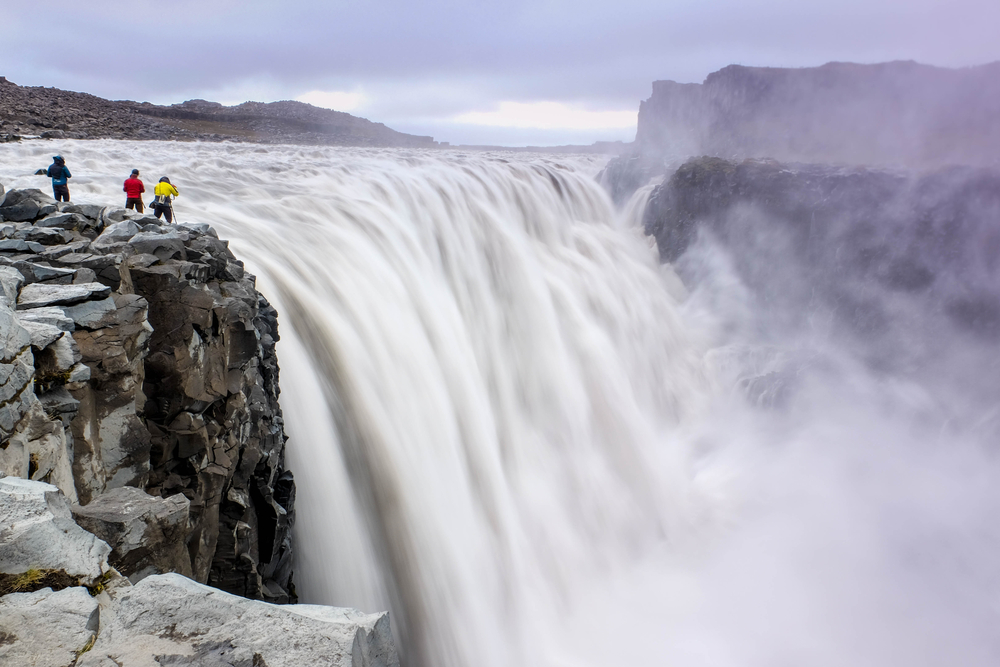
Rim of Viti Crater
Viti Crater is one of those stops in North Iceland that don’t seem real. This is the site of an ancient crater that is filled with brilliantly blue water that is in beautiful contrast of the landscape around it.
This crater was formed by the volcanic eruption of Krafla.
The best views of Viti Crater are by walking the rim of the crater. This is a nice light walk that will take about 20 minutes to make it around the whole crater. Keep and eye out though, because there is often construction on the path to fortify the walkway. When the walkways are partially closed there is still a good chance of seeing the great views this crater has to offer.
When visiting this site, you’ll see that there are some smaller lakes near by. Some of the small lakes are geothermal and you can even see some lava fields nearby as well!
Be sure to add Viti Crater and its astounding surroundings to your next itinerary.
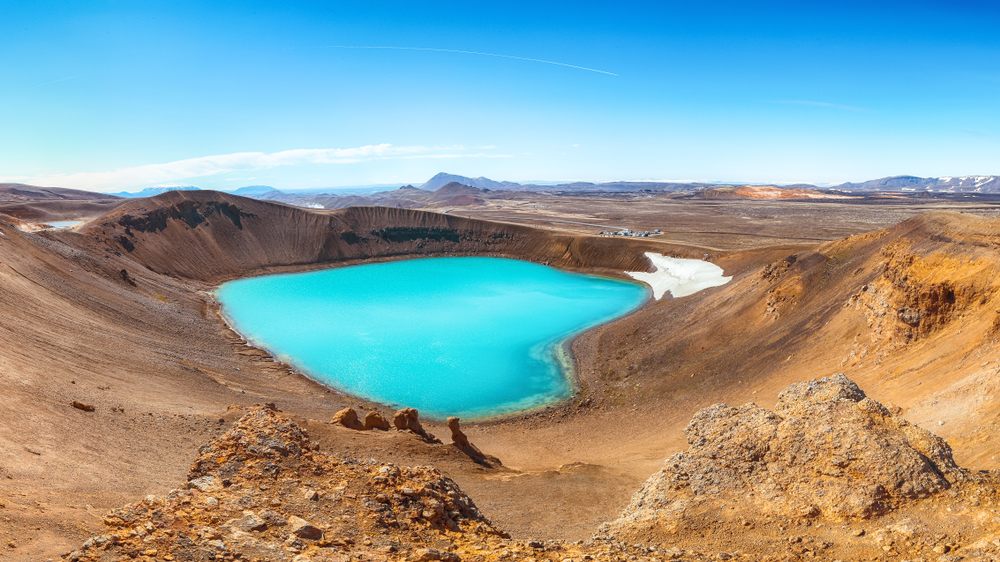
Myvatn Nature Baths
Essentially, the Myvatn Nature baths are the Blue Lagoon of the North. These geothermal springs make for the perfect place to relax and take in the beauty of Iceland all year round. It is truly one of the best things to do in Iceland!
These springs sit around 36ºC to 40º C making the steamy warmth of the water perfect for gazing out at the northern lights if you are there at the right time.
While the Myvatn Nature Baths are not as pricey as the blue lagoon, they are becoming more of a tourists attraction and are not inexpensive. The views and the esthetic are worth it, though. It’s also a bonus that there are steam rooms on the premisis.
One thing to keep in mind is the water does attribute some of its warmth to sulfer so be wary of bringin jewlery in the water with you.
The cold Iceland days can definetly take a toll during your visit. So why not warm up and catch some beauitful views at the blue lagoon of the North?
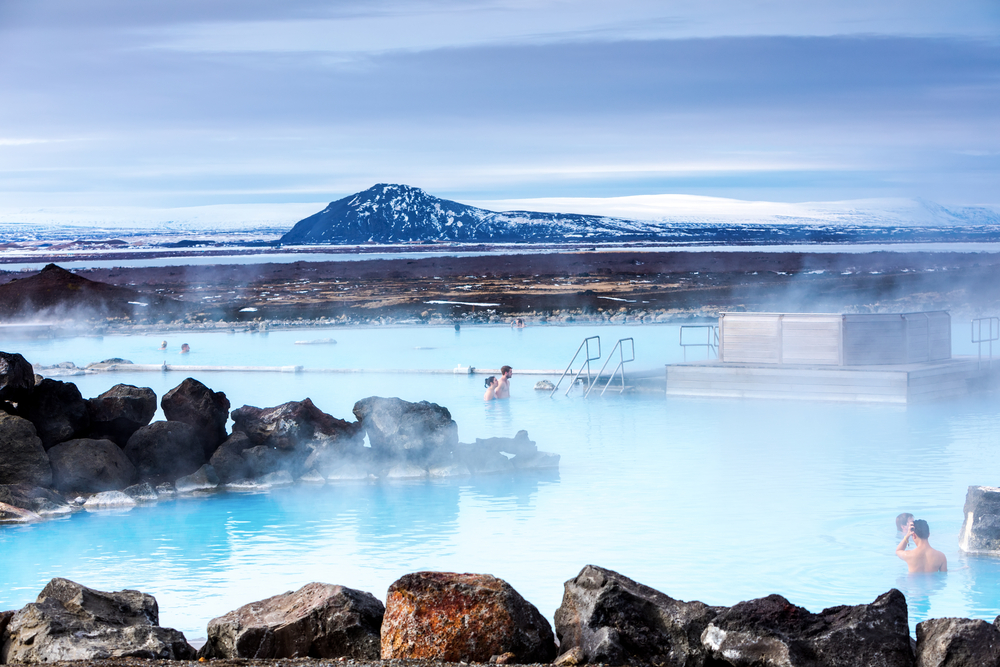
Grjotagja Cave
Underground cave filled with a beautiful pool of water? Count me in! Grjotahja Cave is a specitcal to see and it can be a nice short stop on your journey around Iceland!
As you enter the cave through the narrow passageway and see the underground lake canopied by stunning rock formations, you may be tempted to stick your hand in the water. Please don’t.
While the water used to be safe to swin in, due to volcanic activity the temperature has a tendency to fluctuate so it’s been deemed unsafe.
If you just want to visit this cave for the sole reason that it was used in Game of Thrones Season 3, we don’t blame you. But you also won’t be disappointed in the natural beauty this underground cave has to offer.
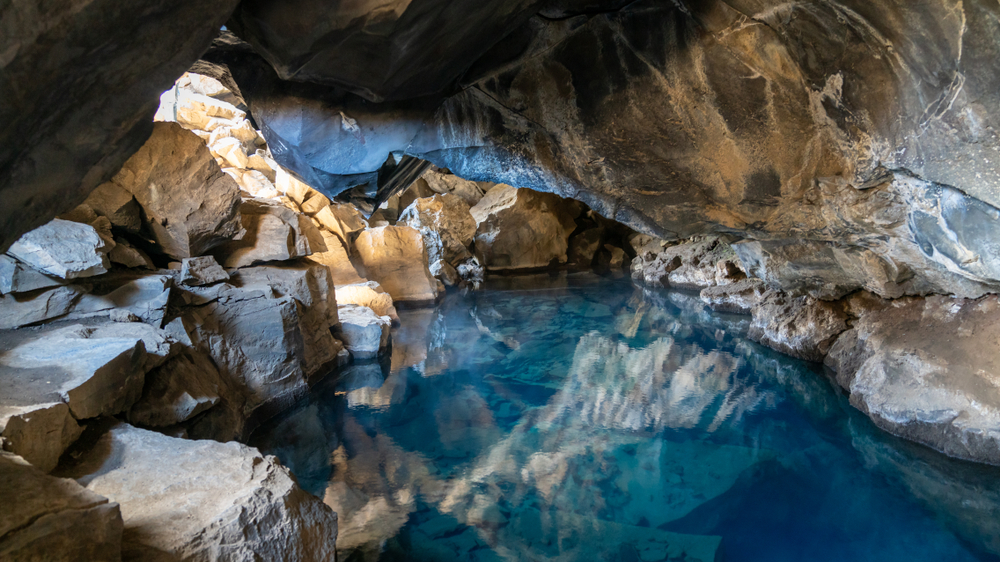
Godafoss Waterfall
Godafoss Waterfall is another stunning waterfall the merges beauty and power effortlessly. It is one of the best waterfalls in Iceland and the most popular in the north.
This waterfall is a near perfect half circle that is split down the center by a rock formation. This formation has a smaller thinner waterfall that runs down its rockface creating a truly amazing view.
It is truly amazing to witness natures beauty at Godafoss waterfall. You are able to decend to the bottom and stand near the green-blue pool of water that forms beneath the falls.
If you don’t want to venture to the bottom of the falls, staying up top offers great views and gift shop at the East entrance. Pick a nice dry spot on the edge and spend time soaking up some North Iceland beauty at Godafoss
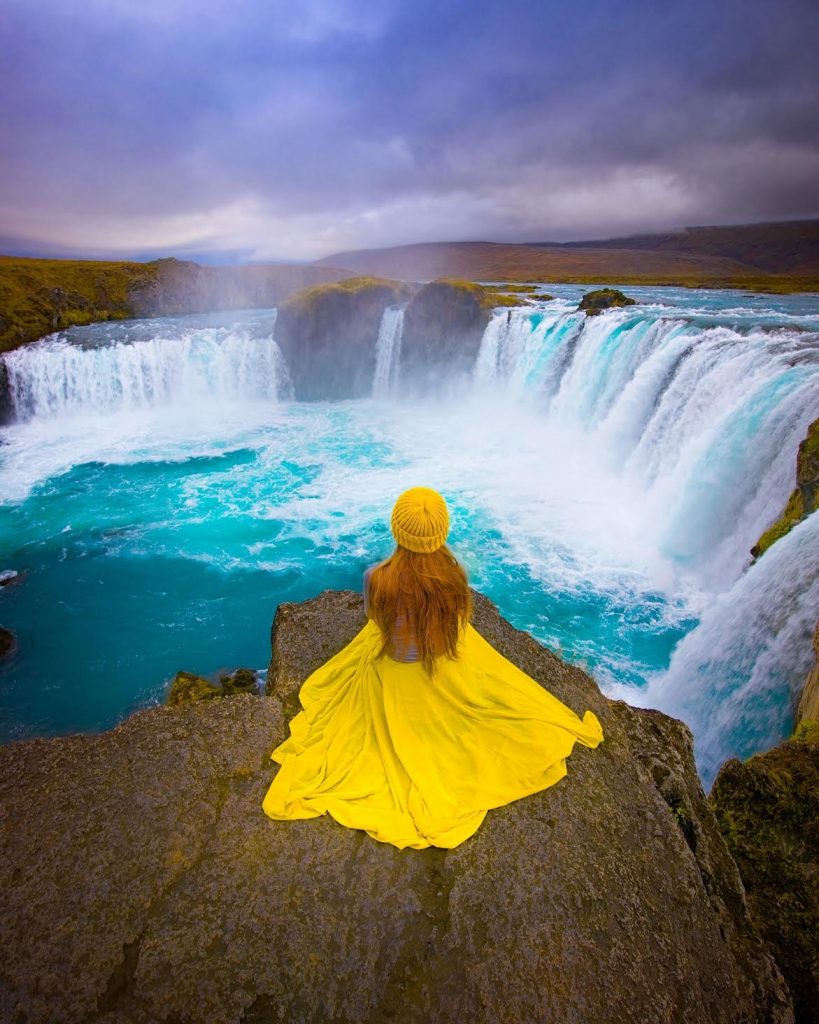
Aldeyjarfoss
When it comes to strake and memorable imagery, Aldeyjarfoss does not disappoint.
Iceland is known for is basalt rock faces and waterfalls, and Aldeyjarfoss is one of the many ways to see these natural wonders. What makes this waterfall unique is that it looks like the falls have burst through the walls making for an unforgettable sight.
It is not one of the tallest waterfalls, measuring in at just about 65 meters, but it’s power and majesty are captivating.
Unfortunately, none of the pools surrounding Aldeyjarfoss are not geothermal. The waterfall’s roots come from the Vatnajokull Glacier, the largest glacier in Europe.
These falls are accessible all year round, but they are easier to access during the summer months.
In Summer you can drive right up to the falls. In winter, however, the parking lot is farther away making it about a 40 minute walk to the falls. It is still very much worth it if you don’t mind a nice brisk walk to a scenic waterfall.
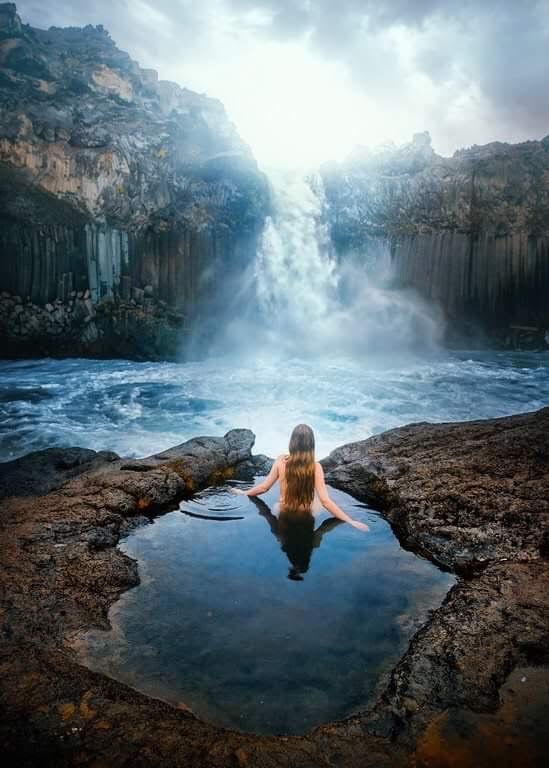
Husavik a charming town in north Iceland that has plenty of attractions in the surrounding areas!
This small town is the whale watching capital of Europe! Even from shore you are more likely to see a whale than anywhere else in the world! There are many amazing Whale Watching Tours you can take to see them up close.
The bay that Husavik sits on is flush with minerals that wash in naturally from the melting ice caps. The whales are provided a flourishing ecosystem in which they thrive!
Take a tour with any of the many whale watching tours in Husavik and get a glimpse of some of nature’s most mesmerizing creatures. Some whale watching companies will even take you to Bird Island where you can hike, and see the adorable Puffins in their natural habitat.
Once back on shore there are plenty of attractions nearby this northern Iceland gem! In town you will find a few muesums including history, exploration, and a spectacular whale museum!
Venturing outside of town you will also find horseback riding and geothermal pools that will have you totally relaxed!

As we mentioned, Husavik has some of the best geothermal pools. Geosea Spa is the perfect way to wind down after a long day on the water.
Geosea spa is a geothermal infinity pool looking over the ocean. With this being such a beautiful spot, the number of visitors continues to increase. It is definitely worth it to make a reservation, then spend however much time you like in the warm, mineral waters at Geosea Spa.
This infinity pool overlooks the same waters where whale watching takes place. So there’s a possibility you may see some whales while you warm up on shore!
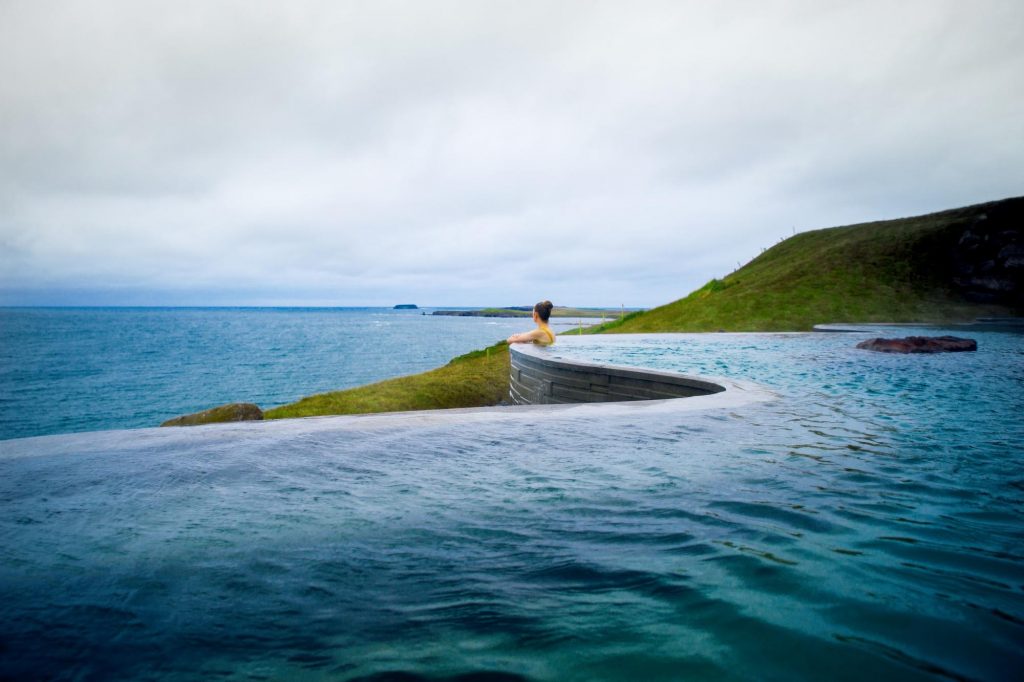
Considered to be the capitol of the North, Akureyri is the biggest city outside of Reykjavik. This town is filled with attractions for the whole family and is filled with history.
One of the main attractions of this town is Akureyrarkirkja Church. It is a beautiful structure that has a sprawling staircase leading to the entrance which is great for photos!
One of the most fun and interesting stops to take is the year-round Christmas house! There’s just something about Iceland that makes the idea of Christmas more magical, and this house delivers 365 days a year!
If you’re visiting in the summer, drop by the intricate Botanical Garden that offers views of the beautiful foliage. Another great summer itinerary place holder can be the city swimming pools, or stopping by an ice cream shop; which we don’t discourage from any time of year.
This is also a great place to stock up on goodies and gas before you hit the roads again! If you are interested, check out our list of the Best Hotels And Hostels In Akureyri!
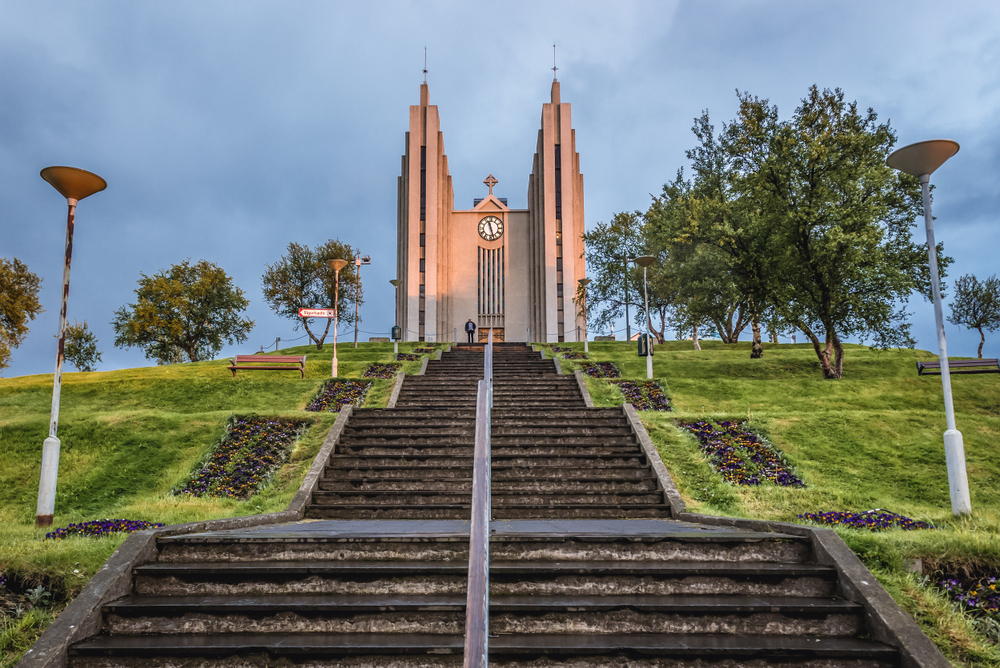
The Infinity Pool In The Town Of Hofsos
There is no shortage of heated swimming pools in Northern Iceland. You can take your pick of locations where you can take a relaxing heated swim.
The infinity pool in Hofsos is one of the prettiest and most scenic infinity pools. Hofsos is a small fishing town which is definitely not bustling. However, the infinity pool looking over the bay gives a great reason to stop by for a bit.
The heated pool is accompanied by a warmer hot tub and has a small museum of emigration nearby!
While basking in the pool, you look over the water and have an impressive view of the island of Drangey. The pool blends effortlessly with the body of water below, making for a great way to take in the beauty of Iceland for a couple of hours.
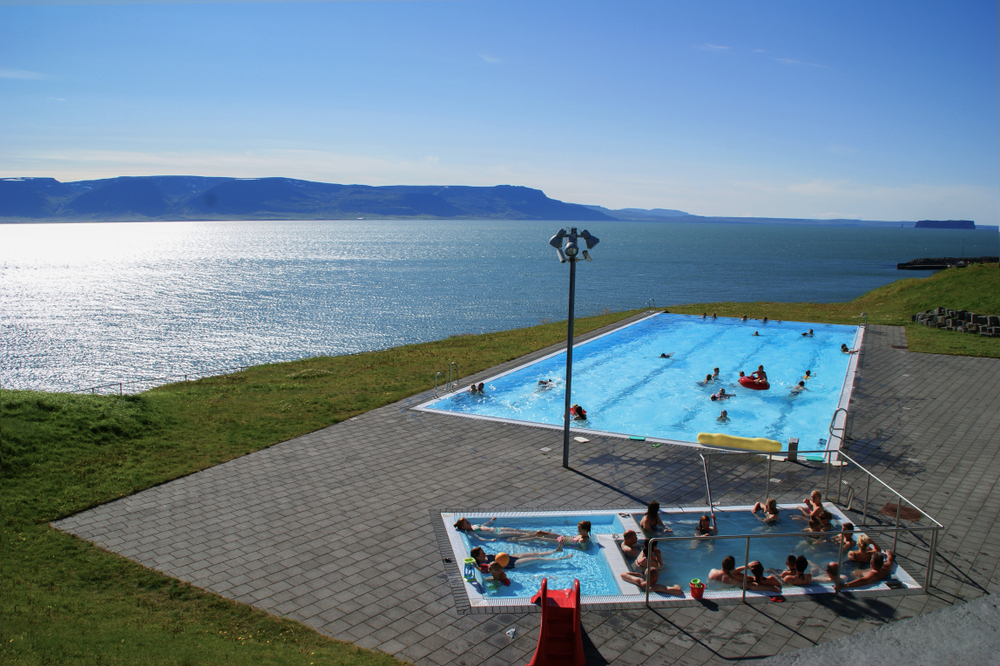
The astonishing rock formation at Hvitserkur is a must see in North Iceland.
The formation appears on the beach and rises from beneath the water, towering above everything in the vicinity.
This stunning formation resembles many creatures Common identifications are an elephant, a rhino, and even a dragon. Local legend says it is actually a troll that was turned to stone as first light rose. However you interpret it, this almost 50 ft formation is beyond impressive.
During low tide, you can walk right up to and feel absolutely dwarfed by this mammoth monolith!
Over time the tide has eroded the rock. It has to be reinforced at the base, but that has just preserved this magnificent structure for years to come.
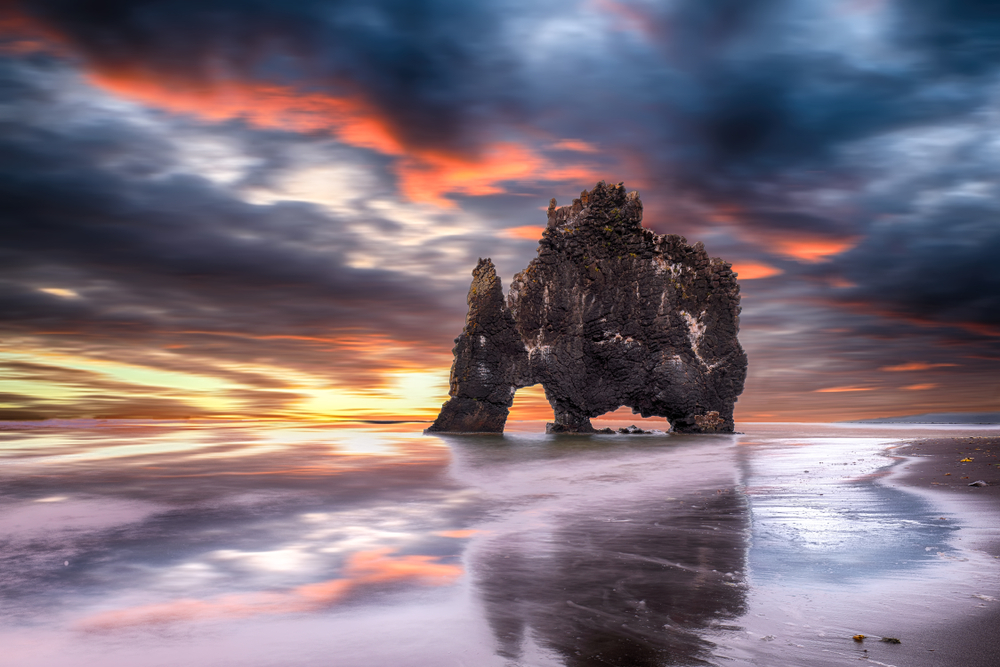
Asbyrgi Canyon
Vatnajokull National Park is full of beautiful sprawling landscapes and Asbyrgi Canyon is one that should be on the list to be explored.
This horseshoe-shaped canyon was believed, by Vikings, to have been formed by a Sleipnir which is a mythical flying horse. It’s easy to see how this myth came about because the shape and size of this canyon are truly magical.
Take a hike through the canyon and you’ll find Eyjan, a phenomenal rock formation that splits the canyon in two. It runs for about half the canyon’s length. Beyond Eyjan, you will be surrounded by the 100-meter canyon walls. At the end of the trail, you’ll find yourself face to face with a peaceful pond nestled in the birch forest.
If you are looking for a great spot to settle down and camp for the night Asbyrgi has a campsite right near the entrance! Feel free to get cozy near these magical cliffs in North Iceland
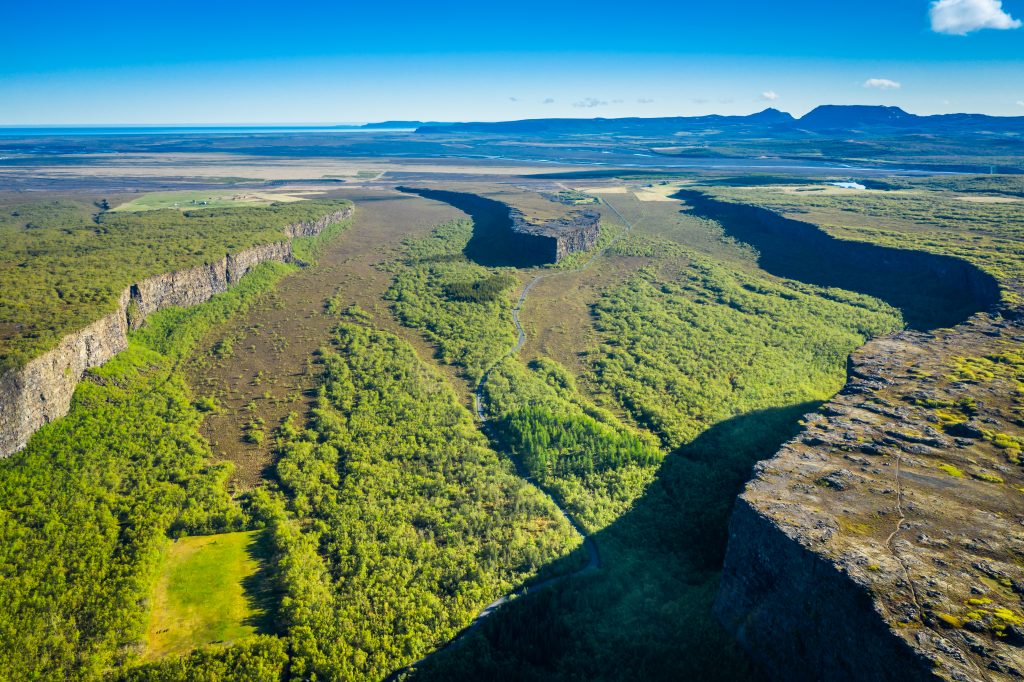
The ancient town of Laufas looks like something out of a fairytale.
The old turf homes seem to rise from the ground in the ancient farming village. These homes from another time were built with turf roofs to reinforce them through Iceland’s harsh weather conditions.
Just a stone’s throw from the turf houses is a church that is equally as exquisite. It is now a museum where tourists can get a glimpse of what life was like on this early farm.
Laufas was originally built between 874-940. It was destroyed by a powerful storm and rebuilt in the mid-1800s. The turf homes provided housing for everyone who worked on this successful farm.
Take in the farm from another era while being surrounded by scenic views of the towering nearby mountains. There is a gift shop and the museum provides information on the origins of this settlement.
If you have at least an hour to spend, take a short scenic trip down to Laufas. You won’t regret it!
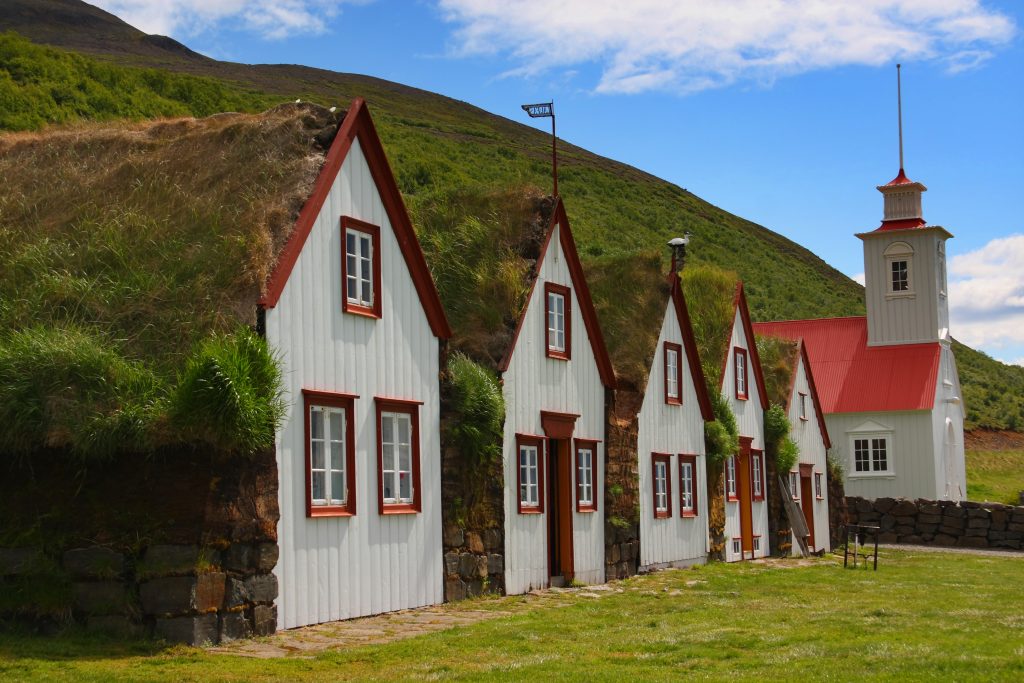
Arctic henge
Constructed to be the sun dial for North Iceland, Arctic henge is a fasicnating structure that is steeped in astrology and lore.
When the construction is finished. the aligned gateways at Arctic Henge will capture sunlight and cast shadows precisely into the structure.
The plan is for it to be a modern version of Stone Henge that will capture the rays of the midnight sun that shines during the summer months in Iceland.
Stepping into Arctic Henge will encapsulate Icelandic history and lore. The entire location is based on the eddic poem Völuspá, and the Dwarf’s names from this poem will be instrumental to the structure.
When Arctic Henge is complete, the names of the72 dwarfs will be etched in the stone of the structure in a circle, representing the year. Five days will be dedicated to each dwarf. Following the calendar, visitors will be able to find their birthday Dwarf!
This will be a spectacular location for tourists to take in all the beauties of Iceland from the midnight sun, to the northern lights.
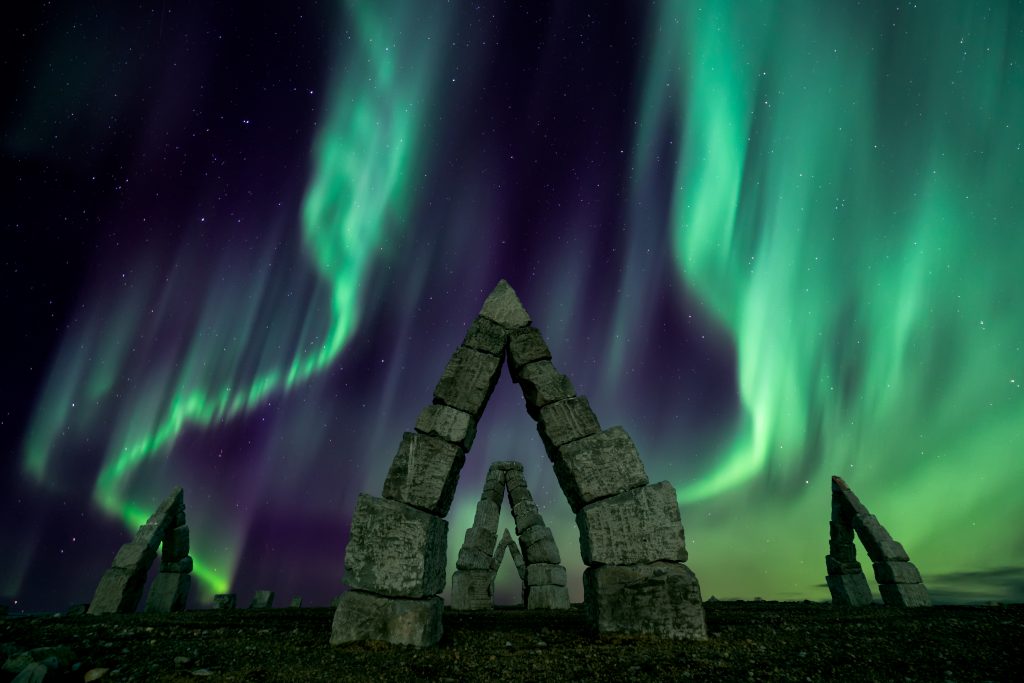
Hljodaklettar
If you haven’t noticed yet, Iceland is known for its unique rock formations. However, not many of them are famous for their acoustics and echos.
Hljodaklettar is a cluster of basalt columns that are arranged in no particular order. They are uniquely in disarray and form interesting rock faces and caves!
What is most interesting about these formations is they have a tendency to produce eerie and intriguing echoes.
To get a good look at the formation near the entrance Vesturdalur, in the Vatnajökull National Park, there a few paths you can take. There is an easy short path that is maked in blue that will take about 30 minutes.
The more intense path is marked in red and will take about 2 hours to complete. This one, however, has some great views of this North Iceland attraction and leads in a circle around the area.
The circular path leads to three equally interesting rock formations that are nearby. The formations are called the castle, the troll, and the church. Each of the basalt formations resembles their name with the same rugged rock faces seen throughout the cluster.

Grettislaug Hot Springs
Located just north or Saudarkrokur in Skagafjordur fjord, Grettislaug Hot Springs are the perfect place to sit back and take in the natural beauty of North Iceland!
What makes Grettislaug Hot Springs unique is they have. a much more rustic and natural look than some other hot springs in Iceland.
They feel more like they are part of the natural surroundings instead of being a way to view them.
These natural hot springs are around 39º C all year round making for a wonderful way to relax outdoors!
The springs are near the edge of the peninsula. They have a great view of Drangey and there are even some quaint turf houses nearby!
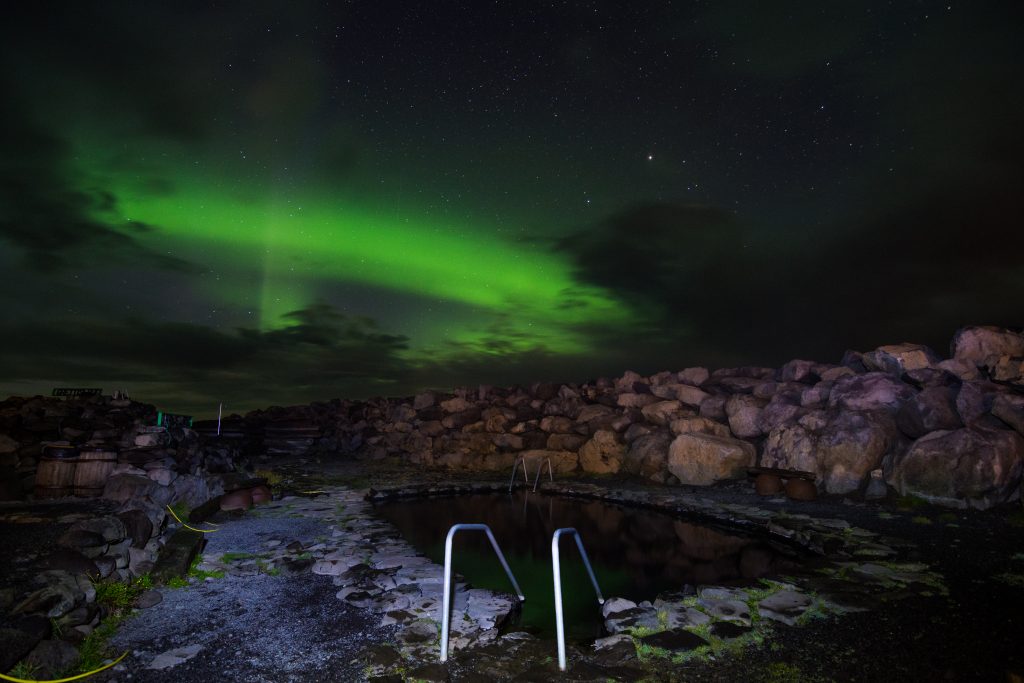
One of the most known attractions in North Iceland is Drangey, or Bird Island.
This island is home to thousands of birds that live undisturbed on the giant island, including corky puffins!
The only way to the island is through one of the guided boat tours. On these tours you have a good chance of seeing whales. Drangey is near Husavik which is popular for all of its whale watching tours.
Do you want a glimpse of the rare birds that inhabit this ancient island? Then you better be prepared for a bit of a hike!
Once you land on Drangey the only way on the island is up. A 180-meter climb up rope ladders is the only way to find yourself on top of this remarkable island. Don’t worry though, you are more than welcome to stay near the boat if you don’t want to make the climb.
Once on top, it is a sensational view of the surrounding landscapes and the ocean. You will not regret making the trip up to the beautiful bird island of Drangey!

Kolugljufur Canyon
North Iceland is just the place to have a gorgeous canyon and waterfall right off the main road.
Kolugljufur is home to a serene river that quickly falls off into Kolufoss. This waterfall is mesmerizing and unique due to the layers and ridges that make up the face of the falls.
Take the time for a short trip off of Ring Road, to watch the river wind through the deep green canyon. There is a viewing platform on site to help you take in the views, and it will barely cost any time!
If you want to walk the path alongside the canyon, you will find gorgeous waterfalls! However, taking in the views right off the road on the viewing platform will be something you won’t forget!
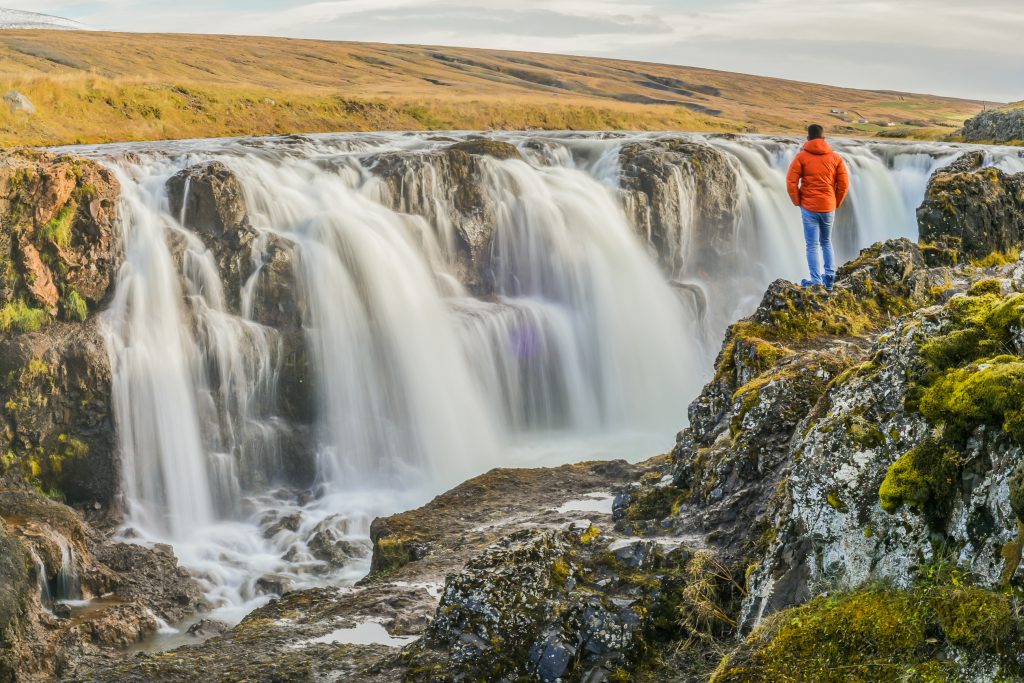
The beauty of North Iceland is unmatched. Not many places in the world offer so many natural wonders in one spot. It is filled with charming towns steeped in lore.
There are geothermal pools where you can gaze upon wild whales. There are even waterfalls you won’t believe with your own eyes. North Iceland’s natural beauty is something that cannot be ignored. When you see these wonders on your next trip to northern Iceland, it’s fair to say you will be in awe.

Reader Interactions
Leave a reply cancel reply.
Your email address will not be published. Required fields are marked *
Save my name, email, and website in this browser for the next time I comment.
Thanks for visiting nordicvisitor.com! For the very best browsing experience on our website, we urge you to upgrade to the most recent version of your browser . Some of our site features may not function properly on older versions.
- Travel Update
- Search Suggested Results View All Results
- EUR (€)
- GBP (£)
- Self-Drive i
- Privately Guided i
- Guided Small Groups i
- Northern Lights i
- Honeymoon & Romance i
- Ice & Snow Hotels i
- All Travel Styles
- Show all tours
- Best Sellers
- Special Offers
- Scandinavia
- Switzerland
- United Kingdom
- Book With Confidence i
- Why book with us i
- Booking Terms i
- Sustainability Policy i
- Manage Booking
- Privacy policy
Iceland Bíldshöfði 20 110 Reykjavík +354 578 20 80 View Map
Sweden Scotland View Details
10 Must-sees in North Iceland: Best Places to Visit
Prepare to be blown away by the natural and cultural wonders of North Iceland.
Touring North Iceland offers you the chance to experience remote landscapes and charming towns in the Land of Fire and Ice.
Must-see North Iceland attractions include active volcanoes, secluded fjords, thundering waterfalls, rustic fishing villages and bubbling hot springs. You could go whale watching, uncover Icelandic folklore, or go hiking in the most extraordinary of locations.
And have you heard about the Diamond Circle? This route is the north’s answer to the famous Golden Circle. The scenic journey covers some of the best places to visit in North Iceland, including the first 5 must-see attractions below.
Read on to find out which spots you shouldn’t miss on your North Iceland adventure.
- Explore these must-see sights on a North Iceland tour package
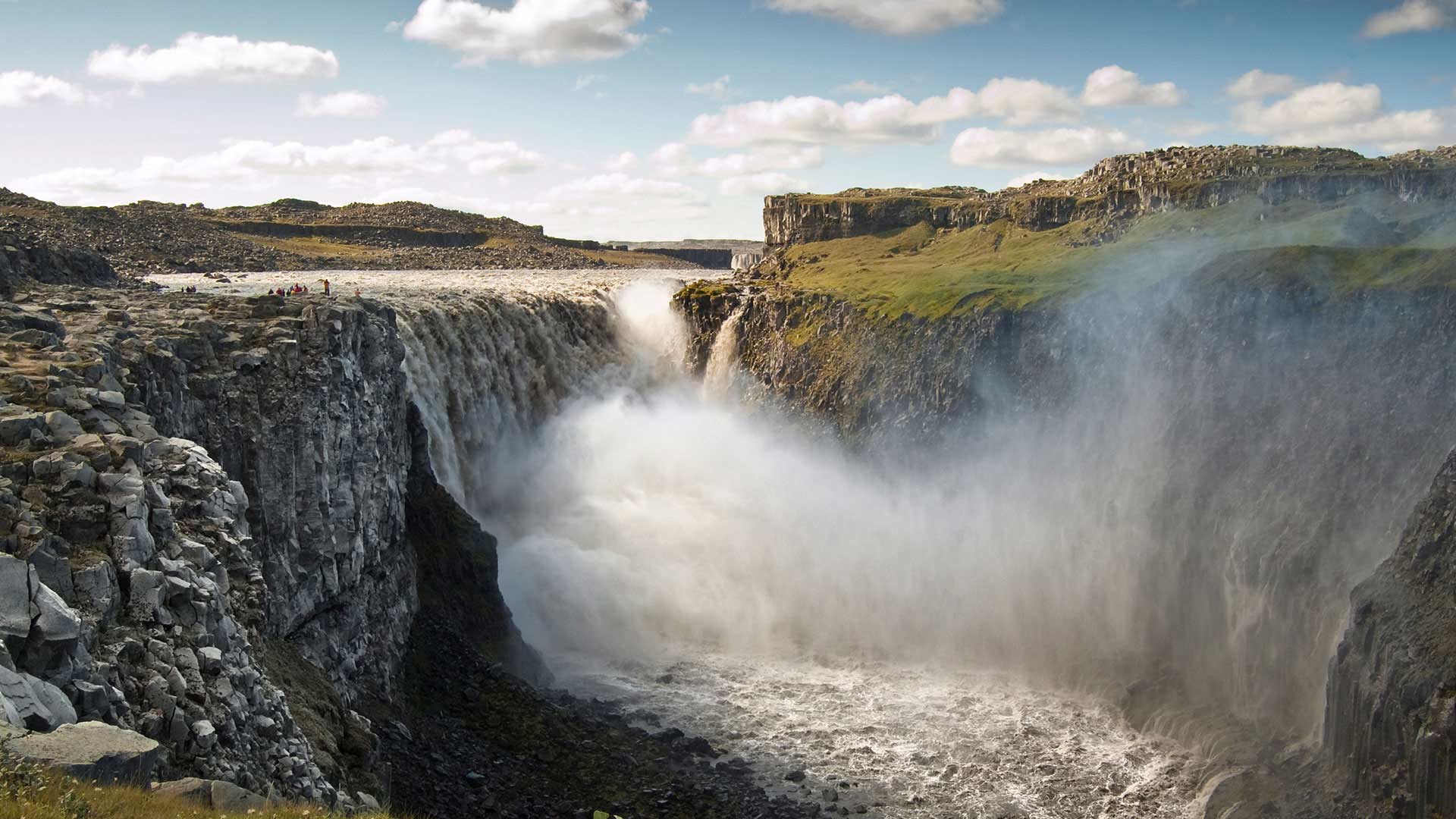
1. Dettifoss waterfall
Stand in awe before Dettifoss , the most powerful waterfall in Europe and the largest in Iceland. Dettifoss is one of the most jaw-dropping places in this part of the country, where you can really get a sense of nature’s immense energy.
As you approach Dettifoss, you’ll hear the roar of water reverberating in the air before you even lay eyes on it.
The best place for you to stand and admire the waterfall is on the east bank. Follow the pathway to the main viewpoint and prepare to be stunned by the raw power of Dettifoss.
Then, watch as the Jökulslá river drops into the canyon below from a height of 45 metres (148 feet), sprawled across a width of 100 metres (328 feet). You may even feel the spray from the river as it rises up from the depths of the canyon.
- Related: Top 10 waterfalls in Iceland
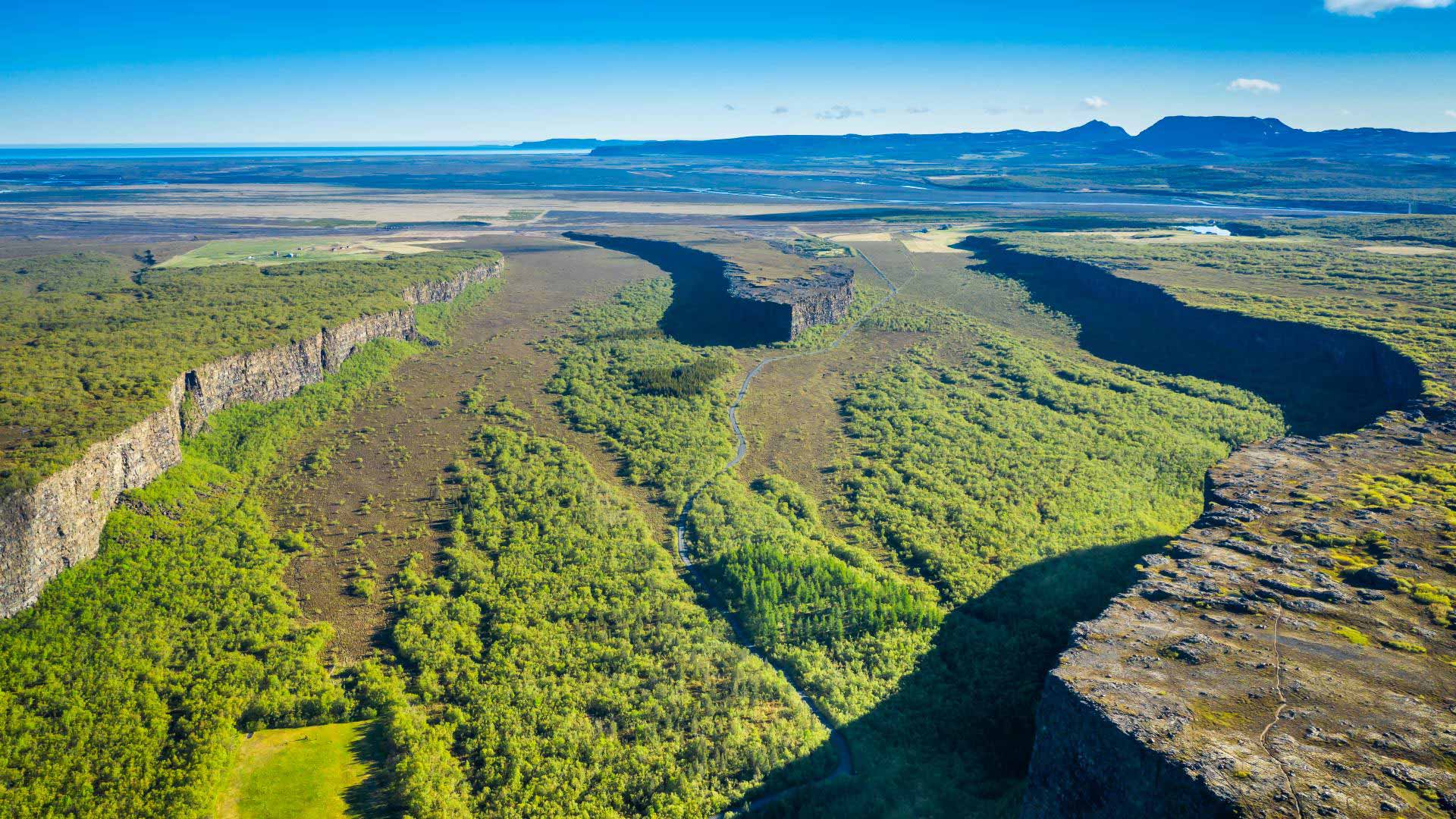
2. Ásbyrgi canyon
Head to the northernmost corner of Vatnajökull National Park to witness the impressive canyon landscape of Ásbyrgi .
Look down in wonder from the top of Ásbyrgi’s rock walls and you’ll see a horseshoe-shaped canyon carpeted in lush forest and plantlife. This greenery has been able to flourish thanks to the towering cliffs and large rock “island” that provide shelter from strong weather forces.
With its well-maintained hiking trails, thriving birdlife, rivers and waterfalls, Ásbyrgi is a must-see in North Iceland.
You might wonder how Ásbyrgi was formed. There are two answers to this question.
Scientists will tell you that the canyon was probably shaped by glacial flooding of the Jökulsá á Fjöllum river after the last Ice Age.
But according to Norse mythology, Ásbyrgi was created when the god Odin flew over the region on his 8-legged flying horse, Sleipnir. The mythical creature touched the earth with his giant hoof and the vast canyon was formed.
- Take a road trip around North Iceland on one of these self-drive tour packages
- Related: Tips for driving the Diamond Circle, Iceland
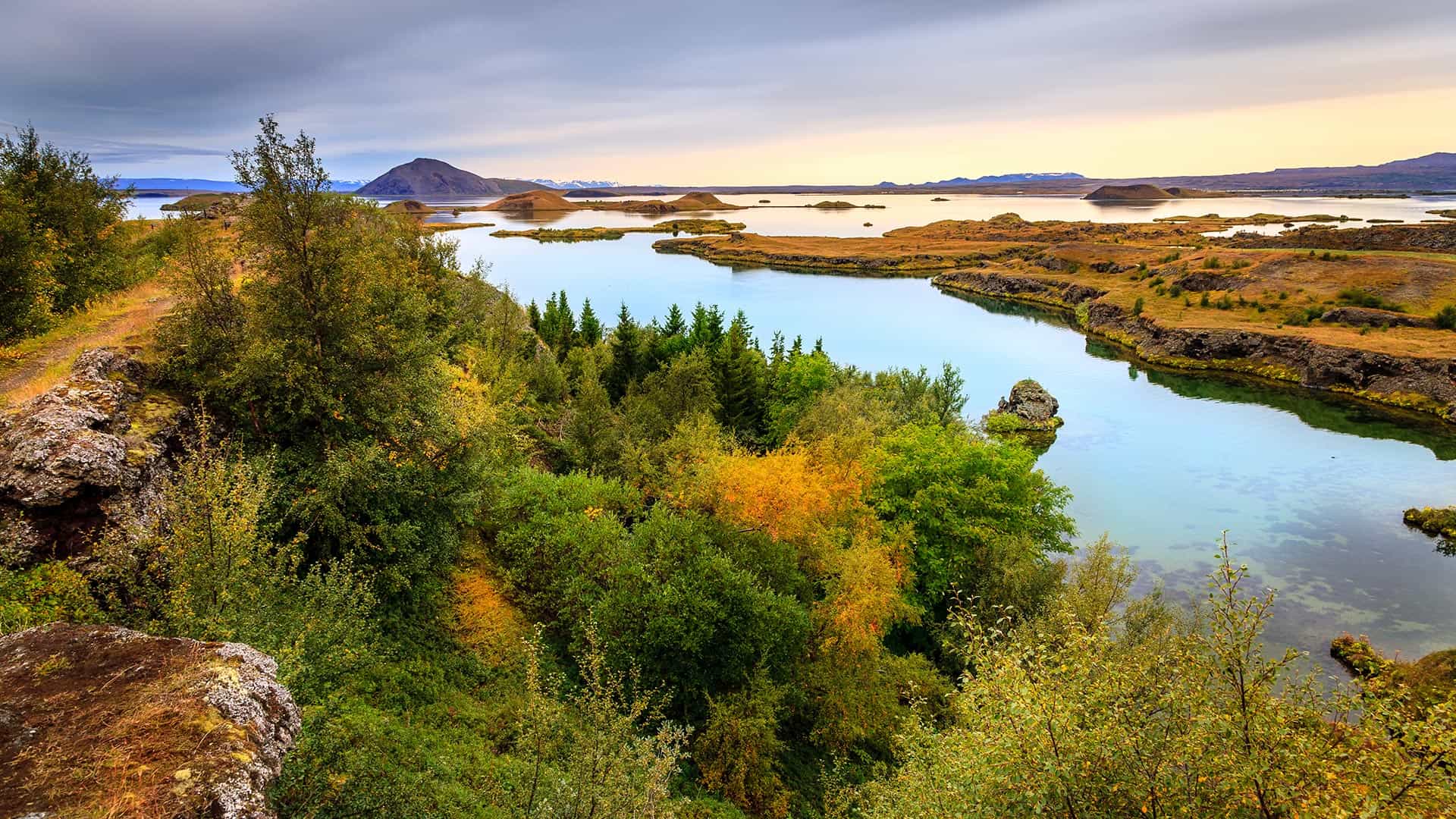
3. Lake Mývatn
Lake Mývatn is one of the top North Iceland attractions you should visit, with fascinating volcanic geology to discover. If you take a Full Circle tour of the country, you can’t miss this vast lake, situated close to the Ring Road.
Mývatn is an ethereal expanse of shallow water that stretches over 37 square kilometres (14 square miles). It was formed by a basaltic lava eruption some 2,300 years ago.
You can spot other signs that this is a region shaped by volcanic activity. Lake Mývatn is surrounded by lunar-like formations such as lava pillars and rootless vents. Check out the pseudo-craters at Skútustaðir , created by gas explosions.
You’ll also want to take a closer look at the Hverfjall crater, found just to the east of the lake. Measuring 1 kilometre (3,280 feet), this is one of Europe’s largest tephra (tuff ring) craters.
Then there are the Námaskarð mud pools, also located to the east of Lake Mývatn. Marvel at the yellow and brown colours of the clay along with the gray-filled mud pools. It looks like a movie scene from another planet!
- Related: All you need to know about driving Iceland’s Ring Road
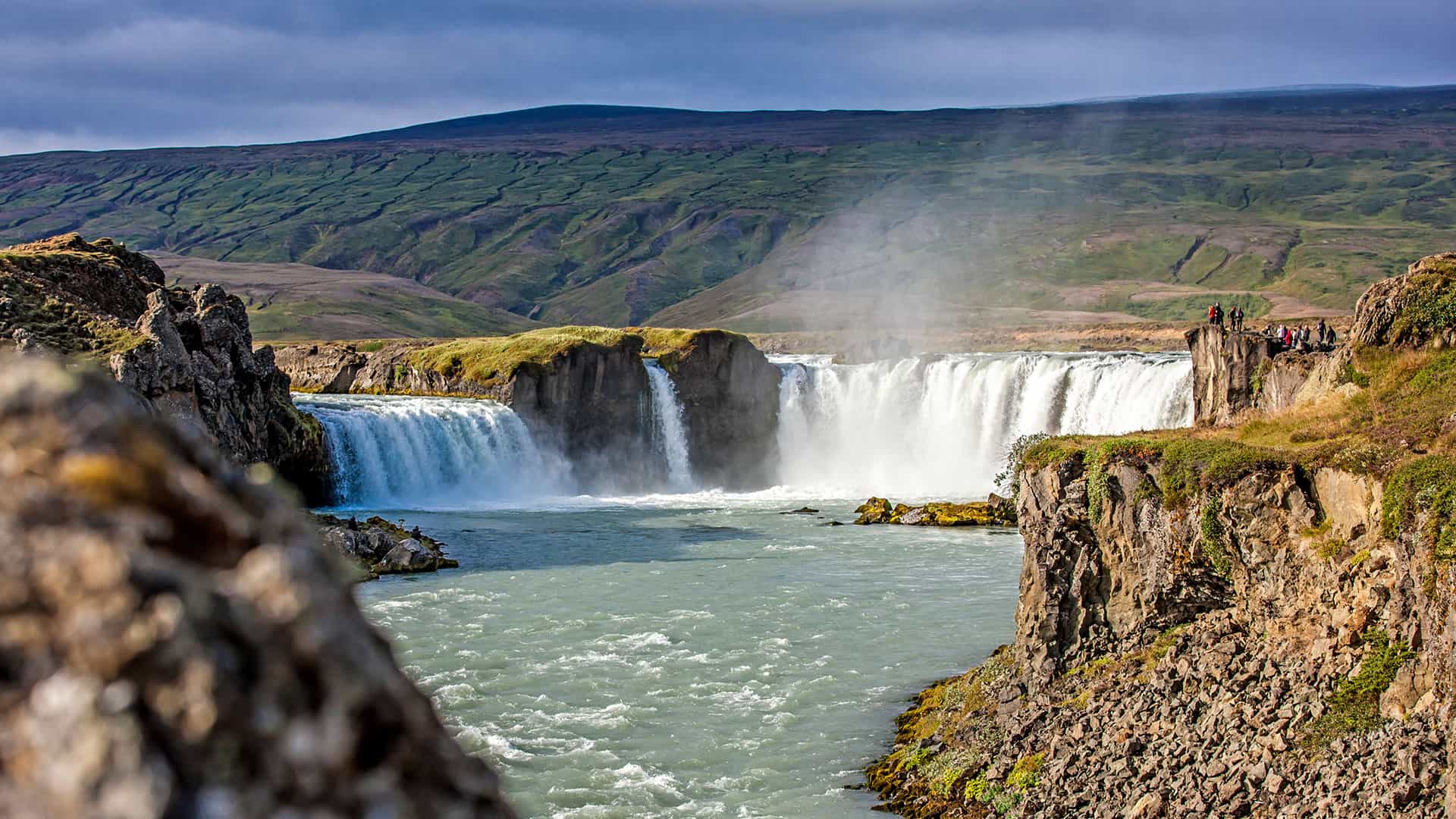
4. Goðafoss waterfall
Lay your eyes on the awe-inspiring “Waterfall of the Gods” – a North Iceland wonder. Goðafoss will dazzle you with its beautiful cascades that drape over two horseshoe-shaped falls.
In a country full of stunning waterfalls, what sets Goðafoss apart is the sheer width of the tumbling falls. White water from the Skjálfandafljót river surges over the rim, thundering down and crashing into the rocks.
These falls are captivating to behold all year round. Watch the falls under the midnight sun in summer, or come in winter to see them cloaked in ice and snow.
Why is it called “Waterfall of the Gods”, you ask? Icelanders’ sagas have it that Þorgeir Ljósvetningagoði, a lawmaker, cast his statues of the pagan gods into the rushing water. This was after deciding, in the year 1000, that Iceland should adopt Christianity.
- Get to know North Iceland like a local on a guided small group tour
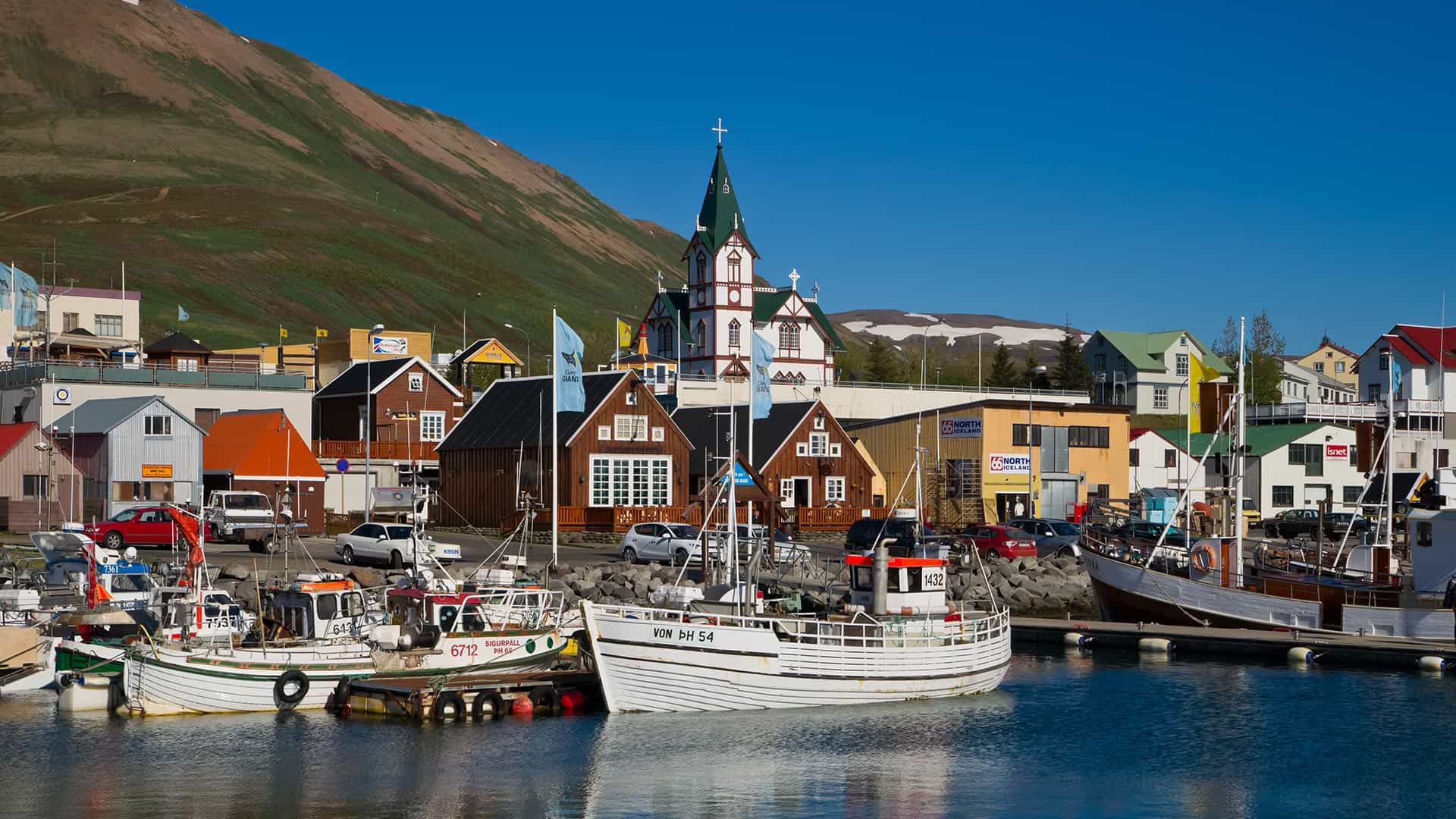
5. Húsavík
You might recognise Húsavík from Netflix’s Eurovision Song Contest: The Story of Fire Saga . Húsavík was one of the Eurovision movie’s filming locations , the hometown of characters Sigrit and Lars – played by Rachel McAdams and Will Ferrell.
In real life you’ll discover that the seafront town of Húsavík is one of the most charming places to visit in North Iceland.
Admire the traditional Icelandic architecture, including the distinctive, wooden church which dates back to 1907. Enjoy views of the Kinnarfjöll mountains across the bay, where fishing boats bob on the water’s surface.
Above all else, you shouldn’t miss a whale-watching tour from Húsavík.
The success rate of whale sightings here is the highest in the country, which is why many call Húsavík the “Whale-watching Capital of Iceland”. You could spot up to 23 different species of cetaceans on your boat tour along the Arctic coast, including humpback, minke and blue whales.
- Related: Your complete guide to whale watching in Iceland
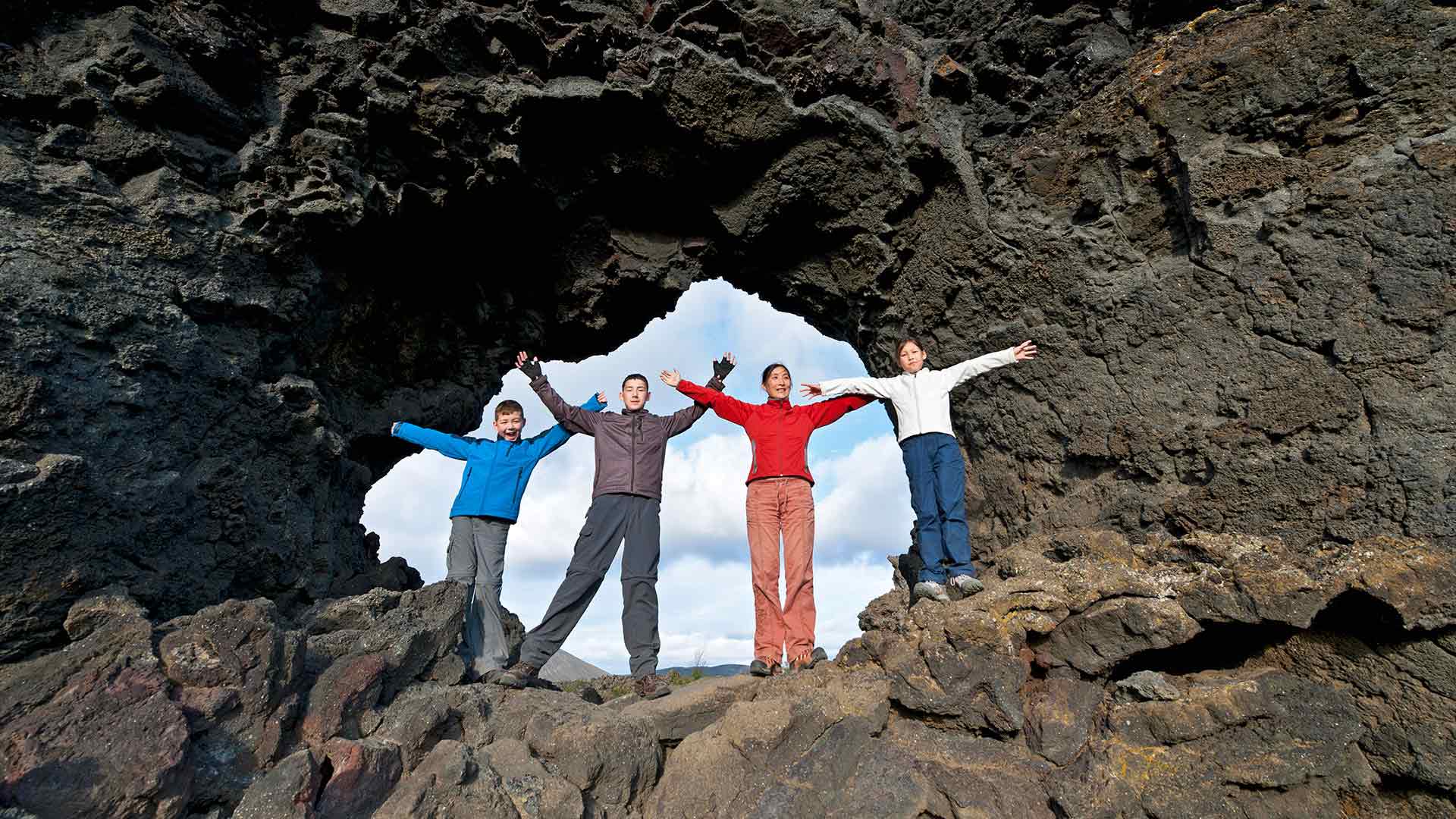
6. Dimmuborgir lava formations
As you now know, the Lake Mývatn area in North Iceland is brimming with otherworldly volcanic formations that are intriguing to behold. Another place you should visit in this part of Iceland is Dimmuborgir .
Situated to the east of Lake Mývatn, Dimmuborgir is a strange lava landscape. Its name means “Dark Castles,” owed to the interesting rock formations jutting out of the ground, resembling a fort from an ancient city.
Walk through this extraordinary place to see columns, caves and arches, including the most famous formation: Kirkjan (“the Church”).
The black lava pillars were born from a collapsed lava tube from a large volcanic eruption more than 2,000 years ago.
- See North Iceland with an expert on a privately guided tour
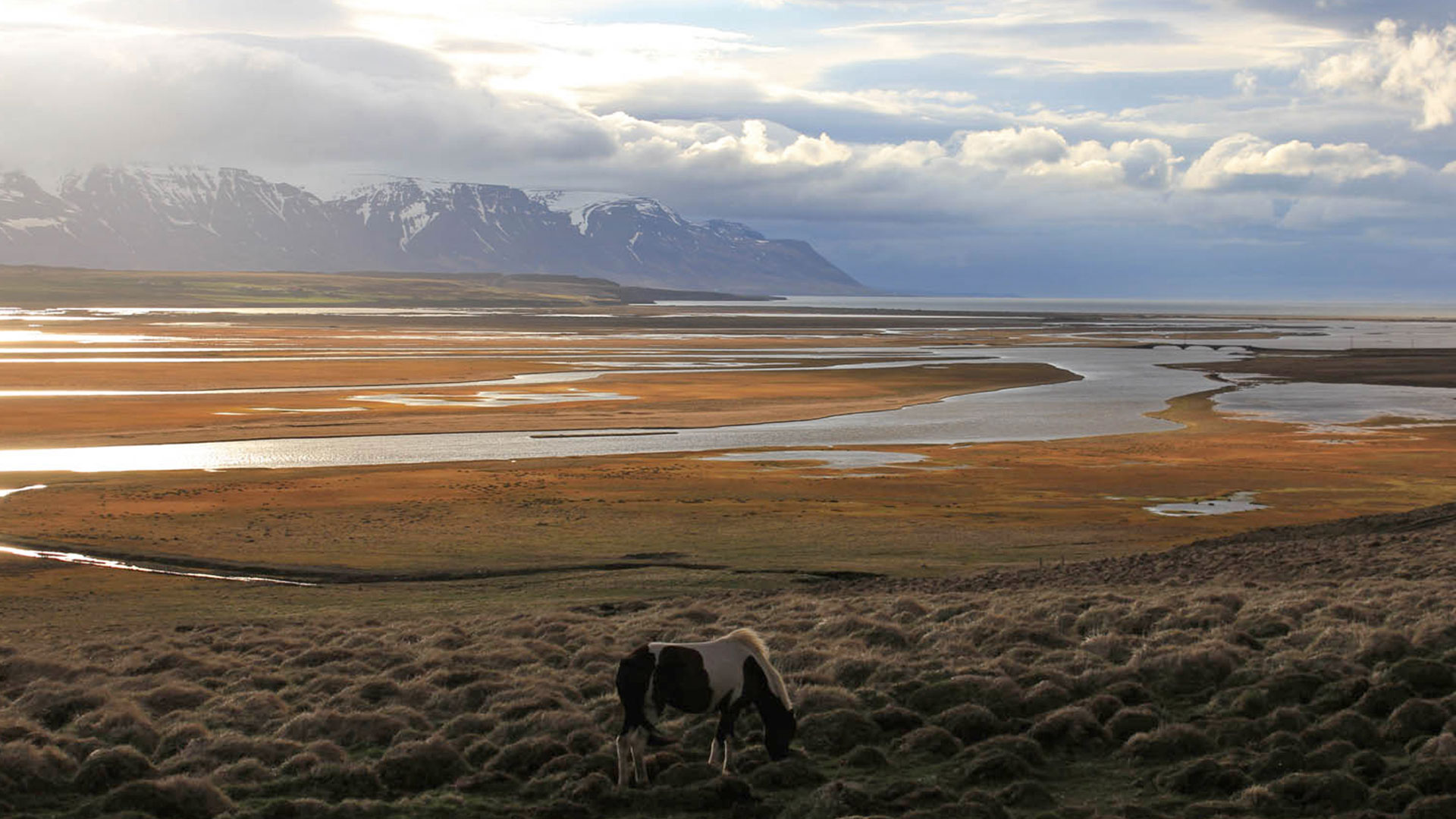
7. Skagafjörður valley
Discover the blissfully remote Skagafjörður , a valley set by a beautiful fjord of the same name in North Iceland. Skagafjörður is the perfect place to explore if you’re looking for a picturesque countryside retreat during your North Iceland tour .
Here you’ll find sweeping pastures roamed by Icelandic horses, a breed that is unique to the country. In fact, these Icelandic animals outnumber the human population in Skagafjörður. This makes it the ideal spot for a horse riding excursion.
Skagafjörður is also home to mighty gorges, soaring mountains, and rocky islands. From the coastline you can see the isles of Málmey, Drangey and Lundey rising from the fjord waters.
Come at dusk to witness the breathtaking sunset over the North Atlantic Ocean. If you’re visiting Iceland in summer , you might stay up late to experience the midnight sun. You could even take a detour to Hvítserkur, west of Skagafjörður. This sea stack looks like a dragon drinking from the water.
Or choose a winter trip to Iceland to chase the northern lights. With its wide open landscapes, proximity to the Arctic Circle, and lack of light pollution, Skagafjörður is a great place to hunt for the aurora borealis.
- Explore these northern lights tours of Iceland
- Related: Iceland's hidden gems: things to do off the beaten path
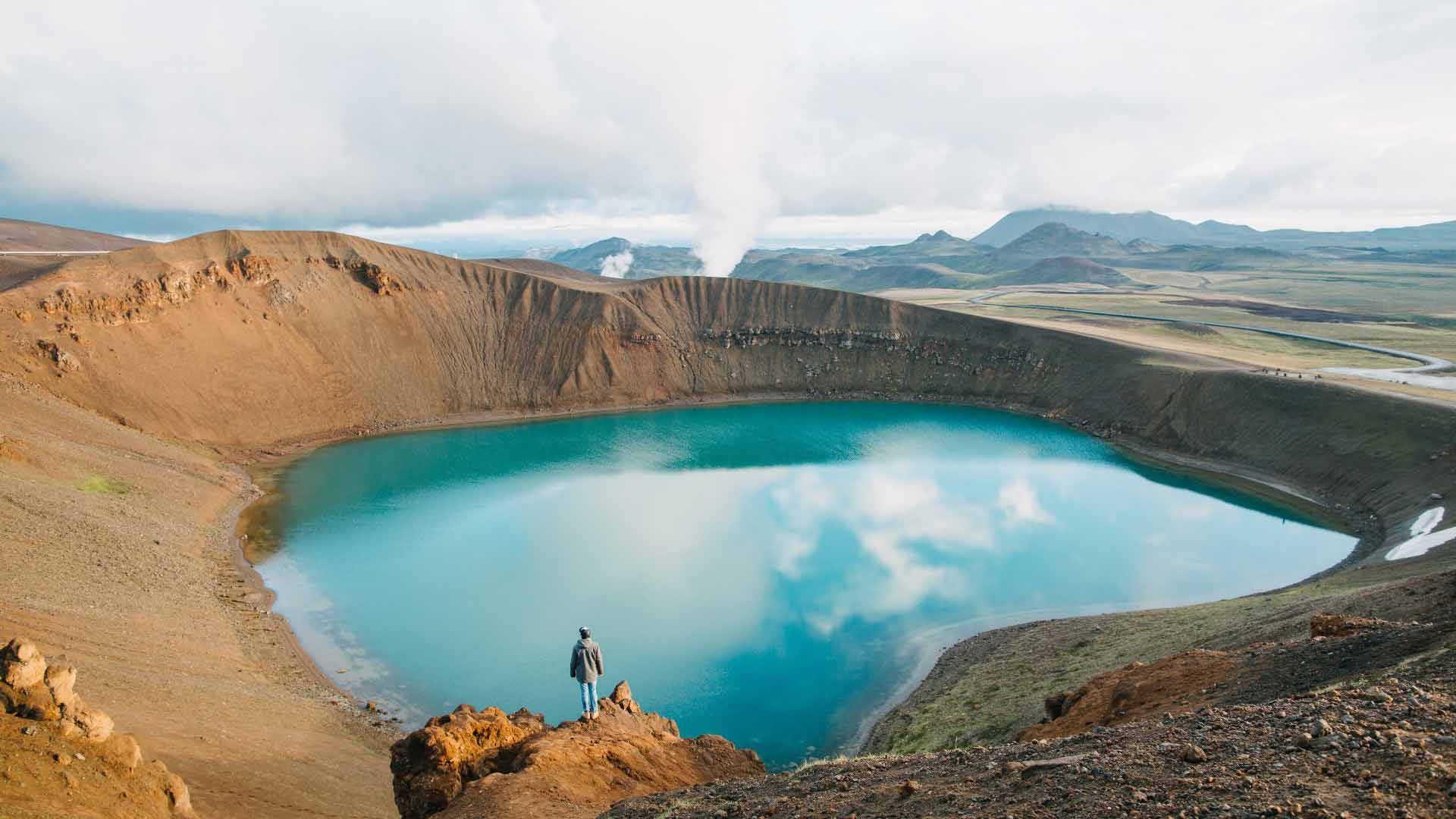
8. Krafla volcano
Imagine staring down at a crater on the slopes of a volcano, in an area that’s still geothermally active. This is what it’s like when you visit Krafla , a volcano that’s 818 metres (2,690 feet) high with a caldera that’s 10 kilometres (6 miles) across.
Krafla, which is set on a fissure zone in North Iceland, erupted 9 times between 1974 and 1984. This series of events is known as the “Fires of Krafla”.
You’ll sense the raw power of this volcanic landscape as you explore the fumaroles, mud pots and lava fields around Krafla and the neighbouring Leirhnjúkur.
Don’t miss Víti, one of the best-known craters in Iceland. You can reach this jade green, volcanic crater lake via a 20-minute walk from the Krafla car park. It’s a fascinating example of Iceland’s fiery nature.
- Related: 7 volcanic experiences to have in Iceland
.jpg)
9. Akureyri
Although the great majority of North Iceland’s star attractions are natural ones, you shouldn’t miss a visit to its biggest cultural hub.
Akureyri is the second largest town in Iceland, after Reykjavík, and is nicknamed the “Capital of the North”. It’s still small, with a population of just 18,000. But when you’re journeying through the vast landscapes in the region, that’ll feel pretty big!
Wander through the old town in Akureyri and keep an eye out for original buildings like the theatre, school house and hospital. These all date back to 1827. Then there’s the wooden house, Laxdalshús, which was constructed in 1795.
As well as admiring the architecture of Akureyri, you could visit the world’s northernmost botanical garden: Lystigarðurinn. There are also museums to pop into, such as the Icelandic Folk Art Museum which bestows you with a view of the Eyjafjörður fjord.
And, just like Húsavík, Akureyri is a great place to enjoy some whale watching.
- Choose a multi-day tour of Iceland to take day trips from Akureyri and Reykjavík
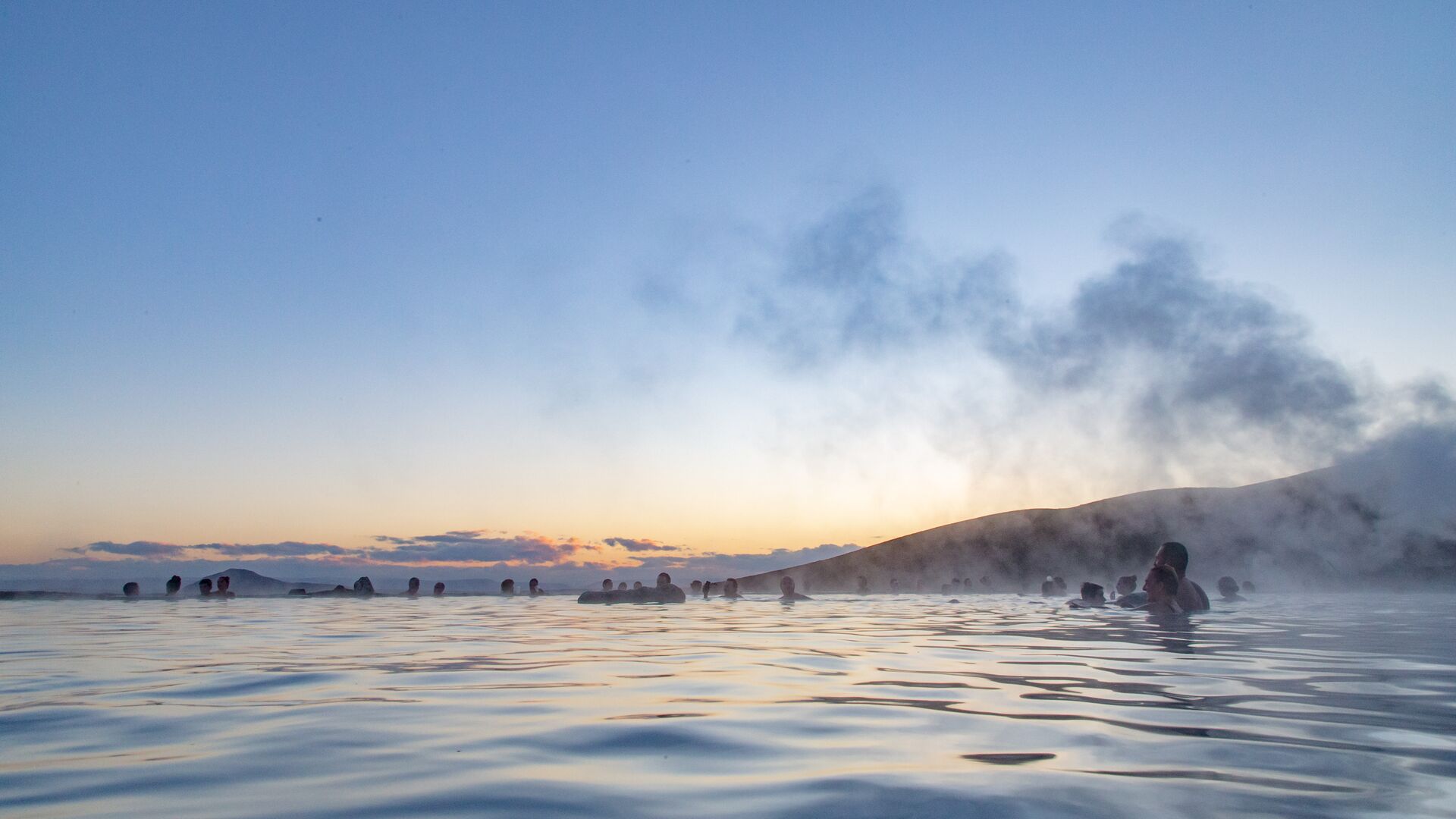
10. Mývatn Nature Baths
One of the coolest things about exploring North Iceland? You have the chance to dip in the naturally heated waters of a geothermal pool: Mývatn Nature Baths .
Soak up the views of the ethereal landscape near Lake Mývatn while you bathe in one of Iceland’s best geothermal pools . The waters, fed by a hot spring, are rich in minerals and sulphur, which is thought to help soothe skin conditions and asthma.
Enjoy delightfully warm temperatures of between 38 and 40°C (100 and 104°F). This may already seem hot to you, but the waters are actually cooled from a natural temperature of 130°C (266°F)!
Then why not relax in the steam baths at this geothermal spa? You still get to see the view though, thanks to the wide windows that frame your surroundings.
- Related: Nordic spa and wellness traditions
When you’re ready to explore North Iceland for yourself, Nordic Visitor can help.
Our Iceland travel experts are based in Reykjavík and know the country inside out. They’ll be able to plan a tour of North Iceland for you, incorporating all the must-see sights that you’d like to experience.
Your dedicated travel consultant will design and book your trip for you, while you relax, reserve your flights, and look forward to your getaway.
Leave it to us to arrange your stays in handpicked accommodation, your transport, and any guided activities. You also get daily breakfast as part of the package and access to our 24/7 helpline throughout your tour, just in case you need us.
Get in touch with our Iceland travel team to make your dream trip a reality.

Wanderlust has taken Emma across much of the world, but it was Scotland that she made her adopted home. Aside from enjoying countryside walks, campervan weekends and gigs in Glasgow, you’ll often find her writing about European travel and plotting her next trip.
Getting there
We'd love to give you the same amazing travel experiences as you read about in our blog! To visit the destinations and attractions mentioned in this post - and to discover a few new highlights along the way - check out these recommended Nordic Visitor tours.
HIGHLIGHTS OF NORTH & WEST ICELAND
- USD ($)
- CAD ($)
- AUD ($)
ICELAND FULL CIRCLE CLASSIC
Best of south & north iceland, related posts, driving iceland's diamond circle: all you need to know.
Blogs , Iceland , In Focus , Destinations , Guides
Whale Watching in Iceland: Your Complete Guide
5 best road trips in iceland: a local expert's view, 8 must-see geothermal attractions in iceland.
- Skip to main content
- Skip to secondary menu
- Skip to footer
ZigZagonEarth
Plan unforgettable road trips!
23 best things to do in Northern Iceland (+ Map + Photos)
Last updated on November 1, 2023 by Claire Robinson - this article contains affiliate links. If you purchase through them, I get a small commission ( more )
Since it is further from Reykjavik, North Iceland is less visited than the South. Yet, it has incredible landscapes and things to do. In Summer, it is my favorite region with many incredible volcanic features, especially around Lake Myvatn. Below is my Northern Iceland Travel Guide to help you plan your itinerary including map, tips, photos and my favorite places to see.
Before my tips + photos, here are my favorites for Iceland:
My favorite platform to rent a car in Iceland: DiscoverCars
The unmissable boat tour: Whale Watching
Fun activity: Swimming in Silfra Fissure
My favorite places to stay:
- Reykjavik: see best rated hotels – e.g. Vintage Boutique Hotel
- Lake Myvatn: see best rated hotels – e.g. Hotel Laxa
- Vik area: see best rated hotels – e.g. Hotel Vik i Myrdal
Why visit Northern Iceland?
North Iceland is a world of powerful landscapes:
- giant volcano craters,
- geothermal areas,
- impressive lava fields
- rushing waterfalls.
When you travel to Northern Iceland, especially around Lake Myvatn, it feels like landing on another planet or waking up in a post-apocalyptic world , especially when you end up walking alone in a lava field still fuming!
Let me show you around…

Below is a short video showing you a snapshot of the many of the beautiful landscapes of North Iceland including waterfalls, geothermal areas, lava pillars and volcano craters:
Is North or South Iceland better?
Most visitors visit the South Region as it is easier to access. However, both regions are very different and worth a visit. To summarize, I think that :
- South Iceland is more romantic with elegant waterfalls, lagoons, icebergs…
- North Iceland is more impressive with a post-apocalyptic feel: geothermal fields, craters, lava, canyons…
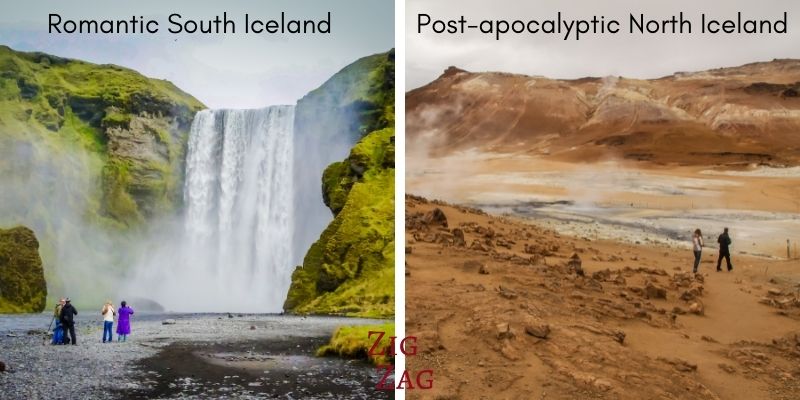
More photos after the planning tips.
Planning tips – How to get to North Iceland and Lake Myvatn
How to get to north iceland.
The Northern Region is easily accessed by car via the Ring Road (Road 1) . It leads you to Akureyri (the largest town) and to Lake Mytvan.
- Reykjavik to Akureyri – 4h30 drive
- Akureyri to Myvatn – 1h20 drive
- Myvatn to Husavik – 1h drive
Another option is to fly from Reykjavik to Akureyri. It is a short flight from the domestic airport (45min, operated by Icelandair). And if you are lucky like I was, the sky will be clear, and you will be able to admire the landscapes from above. I even saw the fumes from an eruption in the distance.
It is a great region to discover on your Road trip around Iceland .

How long to plan to visit North Iceland?
It was my favorite region in Iceland, there is a lot to see. But what is great is that you can settle in Lake Myvatn which is very central and see everything from there! I would say you need at least 3 days but 5 days would be better to really explore it.
Option 1 – Self-drive
For the freedom of stopping wherever you want and spend more time in the places you really enjoy, renting a car is the best solution. Driving in this region is actually really easy. Many of the top attractions are along or not far from the Ring Road. However, if you are hesitating, note that some of interesting places are only accessible by 4WD. You can read my articles about:
- planning an Iceland road trip
- how to rent a car in Iceland
- driving in Iceland
Need to rent a car in Iceland?
- Compare prices on my favorite platform: Discovercars.com – one of the best rated comparison sites!
- Prefer a compact car for the narrow streets in villages
- Consider their full coverage option – it for peace of mind!
- Book early to have a large choice of vehicles!
See all my tips

Option 2 – Northern Iceland Tours from Akureyri
If you don’t want to drive, you can base yourself in Akureyri and book day trips such as:
- Lake Myvatn Classic Tour – See some of the best volcanic features around Myvatn including: Dimmuborgir, pseudo-craters, Grjotagja and the Myvatn bath. Plus a few other nice stops – Check out program and book
- The Diamond Circle with Dettifoss, Husavik, Godafoss… And in Summer, they make an extra stop to see puffins! – Check out program and book
- Northern light hunt from Akureyri (keep in mind that seeing northern light is not guaranteed since it is a natural phenomenon – Check out program and Book
North Iceland Map, Itinerary tips and Places to stay
Top 5 things to do in north iceland – map.
Let’s start with a map highlighting 5 of the most famous attractions in North Iceland to help you get oriented:
- Hverir geothermal area
- Godafoss waterfall
- Dimmuborgir lava field
- Dettifoss waterfall
- Whale watching (from Akureyri or Husavik)
And maybe I should also include the Myvatn Nature Baths (the equivalent to the Blue Lagoon – located between 1 and 3)
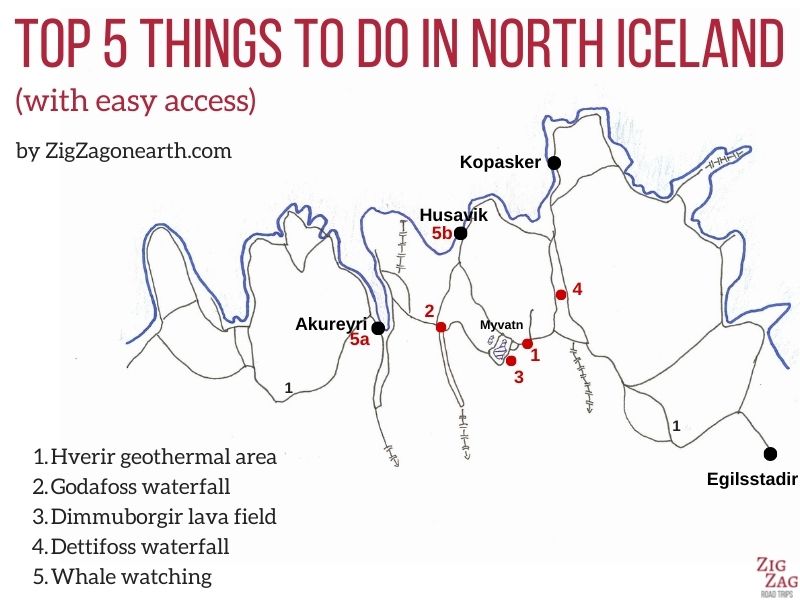
My favorite 5 places to see in Northern Iceland
My personal favorites are (and this is very difficult to select):
- Skutustadir and its pseudocraters
- Leirhnjukur
- Dimmuborgir
- The Trollaskagi peninsula
All my favorite locations (more than those) and detailed maps are included in my travel guide eBook that helps you plan your Iceland road trip :
Plan your dream trip in Iceland thanks to my guide
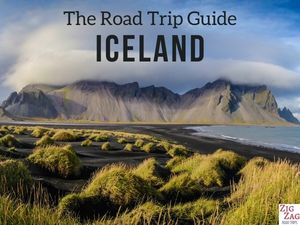
- 8 maps to easily plan your itinerary
- 100+ pre-selected locations
- GPS coordinates direct to the carparks
- Tips to make the most of your time
- 130+ original photos to help you choose
The towns of North Iceland
Some of the main touristic towns are :
- Akureyri, the main town
- Dalvik (on the coast of the Trollaskagi peninsula)
- Reykjahlid – on the shore of Lake Myvatn
- Husavik, on the North coast
- Egillstadir to make the jonction with the East Fjords
Road trip in North Iceland – Itinerary Tips
- I recommend basing yourself at least for a couple of nights in Myvatn . There is so much to see around and it is quite a peaceful spot just to relax
- There are 2 roads to see Dettifoss from both sides of the canyon. If you have time, I recommend both because the view is quite different, but if you are limited in time, I recommend the West Bank
- Visit Dimmuborgir at opening time . It can become crowded during the day and you enjoy a lot less the crazy formations around you
- Enjoy the pseudocraters at dawn, the place is quite magical
- Visiting Northern Iceland requires a lot more walking than South Iceland. But most walks in the attractions are easy to moderate
- Don’t climb Hverfjall when it is very windy
Note: If you don’t want to book everything yourself, consider booking a Self-Drive Tour Package (see my article to help you choose )

5 days around North Iceland – itinerary example
Doing the Ring Road clockwise, I would:
- Day 1 Visit Akureyri Enjoy Godafoss waterfall (head to Aldeyjarfoss if you have a 4WD) Sleep near Godafoss to see sunset – See photos and availability
- Day 2 Head to Husavik – do a whale watching Tour Visit the Whale Museum Drive to Myvatn – 3 nights in Myvatn – Choose one of the lake Myvatn accommodations
- Day 3 & 4 Enjoy the attractions around Lake Myvatn including Hverir geothermal area, Leirhnjukur fuming lava field, Dimmuborgir, the Skutustadir pseudocraters, Krafla Viti lake, Hverfjall crater… Relax at the Myvatn Nature Baths in the evening
- Day 5 Drive to Iceland’s grand canyon with the waterfalls of Dettifoss, Selfoss and Hafragilsfoss. Drive to Egilsstadir to spend the night and be ready for the East Fjords – See best rated accommodations For example I enjoyed the IcelandAir hotel – see photos and availability
Or you can do the opposite, of course, if you are traveling counterclockwise.
For more itinerary including North Iceland, you can check out:
- My suggested for 7 days in Iceland itineraries
- My 4 itineraries to spend 10 days in Iceland
- And my favorite itinerary for 14 days around Iceland

What to wear in Northern Iceland
Check out my complete article with detailed suggestions and tips on what to wear and pack for Iceland

And keep track of your own trip!

Where to stay in Northern Iceland
- Lake Myvatn This places is incredible. You should really not miss it. There is much to see and do within 1h drive of the lake. I recommend staying at least one night, but I think 2 or more is better. The Dimmuborgir Guesthouse is one of my favorite places to stay in Iceland (I booked myself and paid entirely for my stay). Right next to the lake and with the Hverfjall crater in the background… perfect! See more photos and check availability Or Choose one of the lake Myvatn accommodations
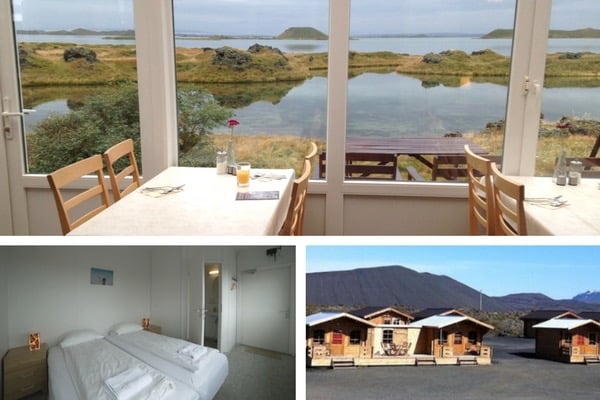
- Akureyri It is the capital of the North. From here you don’t have to drive, you can explore by tours. There is a large choice or restaurants and great boat tours to see wildlife See best rated accommodations
- Egilsstadir If you are traveling from the East Fjords or to them, the town of Eilgsstadir is a perfect mid-way point to stay for a night. See best rated accommodations For example I enjoyed the IcelandAir hotel with large room and Northern lights wake up call! – see photos and availability
- Husavik Husavik is famous for its wildlife attractions. It is a small town but with wide open views, a place to breathe. See best rated accommodations
- Godafoss If you want to enjoy Godafoss at sunset, sunrise and under the stars, you can stay one night right next to it. The Fossholl Guesthouse, right on Route 1 near Godafoss. See photos and availability
More tips in my article about Where to stay in North Iceland
Where to stay in Iceland?
My favorites:
- Reykjavik , capital city: see best rated accommodations – or my article on where to stay
- Selfoss , between Golden Circle and South Coast: see best rated accommodations
- Vik, near waterfalls and glaciers: see best rated accommodations
- Höfn , gateway to the East fjords: see best rated accommodations
- Egilsstadir , between fjords and North Iceland: see best rated accommodations
- Reykjahlid , for the wonders of Lake Myvatn: see best rated accommodations
- Akureyri , capital of the North: see best rated accommodations
- Grundarfjordur , on the Snaefellsnes Peninsula: see best rated accommodations

10 Best Things to do at Lake Myvatn
Lake Myvatn is for me the highlight of North Iceland. There are so many places to see and natural attractions concentrated there: lake, pseudo-craters, eruption craters, geothermal areas…
1. Lake Myvatn itself
A large area, with a lake and wetlands, which has a rich fauna. It is a dream destination for those who love geology and bird watching. The lake was created by a large eruption over 2000 years ago.
Great views from near the entrance to Dimmuborgir.

2. Pseudo-craters
Skutustadagigar is a peninsula on lake Myvatn with a series of beautifully shaped pseudo-craters created when lava flowed over water.
More photos an Info on my article about the Pseudocraters

Hofdi is a park with many trees in the middle of the bare landscape. One of the paths leads you to the Lava pillars standing in lake Myvatn.
More photos an Info on my article about Hofdi

4. Dimmuborgir
Dimmuborgir is a special area around lake Myvatn where the lava created some spectacular shapes. Many paths lead you through the incredible landscape.
More photos an Info on my article about Dimmuborgir

5. Hverfjall Crater
Hverfjall is one of the largest symmetrical and circular eruption craters in the world. There are trails to climb it and tour its rim.
More photos an Info on my article about Hverfjall

6. Grjotagja
Grjotagja is a small cave created by a fissure in the crust. It is filled with geothermally heated water in a pool.
More photos an Info on my article about Grjotagja
It may be closed as it is on private property.

7. Myvatn Nature Baths
The Nature Baths are the equivalent of the Blue Lagoon but it a more intimate experience. After all the walking in the area it is nice to relax in these hot waters.
More photos an Info on my article about the Myvatn Nature Baths

Hverir is a geothermal area at the foothill of Namafjall. Features include colorful sulphurous mud springs, steam vents, cracked mud and fumaroles.
More photos an Info on my article about Hverir

9. Leirhnjukur
Leirhnjukur is a geothermal area where one of the trails allows you to walk through lava that is still fuming.
More photos an Info on my article about Leirhnjukur

10. Krafla Viti Crater
Krafla Viti is circular crater filled with deep blue water and surrounded by colorful mountains. A trail leads you all around its rim.
More photos an Info on my article about Krafla Viti Crater
I don’t drink coffee
But I also like other drinks and sweets! Do you like the free content you find on my blog? All my tips and practical information, without intrusive advertising…

9 best things things to do in North Iceland (attractions outside Myvatn)
And here comes my selection of the best things to do in the rest of Northern Iceland:

11. Godafoss
Godafoss is an elegant horse-shoe shaped waterfall that you can easily admire from both sides. It is just next to Road 1.
More photos an Info on my article about Godafoss

12. Aldeyjarfoss
Aldeyjarfoss is an off-the beaten track waterfall with a narrow flow but a large pool and interesting lava shapes. The surrounding landscape feels like another planet.
More photos an Info on my article about Aldeyjarfoss

13. Trollaskagi Peninsula
The Trollaskagi peninsula, located North of Akureyri, is full of stunning landscapes. I especially recommend driving trough via the central road.
More photos an Info on my article about Troll peninsula

14. Dettifoss
Dettifoss is the most powerful waterfall in Iceland with can be admired from both sides of the canyon. It is one of the most powerful in Europe.
More photos and Info on my article about Dettifoss & Selfoss

15. Selfoss
A trail leads from Dettifoss to Selfoss, a horseshoe-shaped waterfall with a multitude of others, creating a veil.
More photos an Info on my article about Dettifoss & Selfoss

16. Hafragilsfoss
Hafragilsfoss can be admired from far away as it is canyon. It is a classic curtain waterfall, but the surroundings make the sight fascinating.
More photos an Info on my article about Hafragilsfoss

17. Glaumbaer
Driving west of Akureyri on Road 1 you can take a detour to admire the turf houses of the Glaumbaer farm. It is also a small museum where you can see old farm tools.
More photos an Info on my article about Glaumbaer

18. Akureyri
Akureyri is the capital of Northern Iceland. It is a quaint town at the end of a fjords. Great if you are looking for a break from Nature. LOL.

19. Husavik
Charming fishing town with a long history around Whales. Visit the museum, take a deep breath and enjoy a whale watching or puffin watching adventure!
Plan your trip to Iceland this Summer:
- My itineraries : 5 days , 1 week , 10 days , 2 weeks
- Where to stay in Iceland
- Where to stay in Reykjavik: best hotels
- 36 tips to rent a car in Iceland
- Guide to driving in Iceland
- How to plan a road trip in Iceland
4 unforgettable Northern Iceland activities
Want to take a break from all that driving? There are some great activities to have fun and see Iceland in another way. Have a look:
20 – Whale watching

North Iceland is the best places to see whales around Iceland. Tours depart all year round. You can book tours from Akureyri – see tour options and availabilities But the most famous destinations for whale watching tours is Husavik – see tour options and availabilities
21 – Horseback riding

Just you, the Icelandic horses and the landscapes. A majestic way of exploring North Iceland! From March to September
See options
22 – Super Jeep to the Central Highlands

Enjoy the thrill of getting off road in a super jeep. Head to the Central Highlands and the famous Aksja area. (June to Oct only) See program and availability
23 – Whitewater rafting
If you are looking for an adrenaline rush, check out whitewater rafting on the Jokulsa river. See details and availability
OR opt for a family version of rafting See details and availability
The flies around lake Myvatn
Lake Myvatn is one of my favorite places in Iceland but it has one major issue: the flies.
Myvatn is a thriving ecosystems with many fishes in the lake and plenty of birds. All that means flies. I was luck in September they were not that bad but still it was annoying. I can’t imagine being there when they are aggressive. Only 2 recommendations to help you there:
- Wear a head-net. Swallow your pride and forget how you look like!
- Do not do a horse ride. They are very attracted to the horses
Another solution is to stop breathing as they are attracted to the CO2 but it is not sustainable.
North Iceland and Myvatn in Winter
The North of Iceland gets a lot of snow in Winter. The experience is completely different in black and white. Some of the attractions are not accessible. But it is still worth a visit. Check out my article about Myvatn in Winter

Want to see more of the best Iceland has to offer?
- 45 Most beautiful landscapes in Iceland in pictures – read article
- The best stops on the Ring Road – read article
- The best locations off the beaten path around Iceland – read article
- 21 Most beautiful waterfalls in Iceland – read article
- Top 5 places to see around Myvatn – read article
- 5 best Lava Fields in Iceland – read article
- The 10 best lava caves in Iceland – read article
- The 5 most beautiful black sand beaches in Iceland – read article
- The Golden Circle – read article
- The Snaefellsnes peninsula – read article
Planning a trip to Iceland?
Check out my travel guides to help you plan:
Plan your dream trip to Iceland with my guides!

- 8 easy-to-plan maps
- GPS coordinates
- Useful planning tips
- 130+ large photos
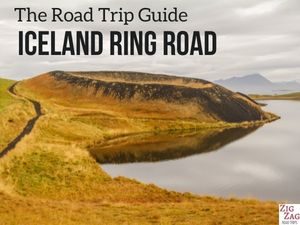
- 2 easy-to-plan maps
- 30 stops, 10 detours
- 70+ large photos
Vestrahorn Iceland
NEXT:
WEST OF AKUREYRI
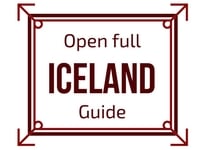
Inspired? Share it on your favorite platform!
Reader Interactions
May 11, 2018 at 1:16 PM
Great travel guide Claire, many thanks.
May 11, 2018 at 8:05 PM
Great to read. Thanks Happy travels!
Par Claire Robinson Region Lovers SARL 76600 Le Havre FRANCE VAT FR21845103191
Follow ZigZag on Facebook
Follow ZigZag on Pinterest
Website in French: ZigZagvoyages.fr
Website in German: ZigZagreisen.de
Website in Spanish: ZigZagviajes.com
And discover the French regions:
Normandielovers.fr LoireLovers.fr CorsicaLovers.fr Provencelovers.fr
Privacy / Terms of Use / Disclosure Policies / Refund policy
Become an affiliate for the ZigZag road trip guides
As an Amazon Associate I earn from qualifying purchases. ZigZagOnEarth.com is a participant in the Amazon Services LLC Associates Program, an affiliate advertising program designed to provide a means for sites to earn advertising fees by advertising and linking to Amazon.com, Amazon.uk and Amazon.ca
- Explore other regions:
- Travel Trade
- diamondcircle
- demantshringurinn
Or try searching by Category and/or Location
Top destinations in North Iceland
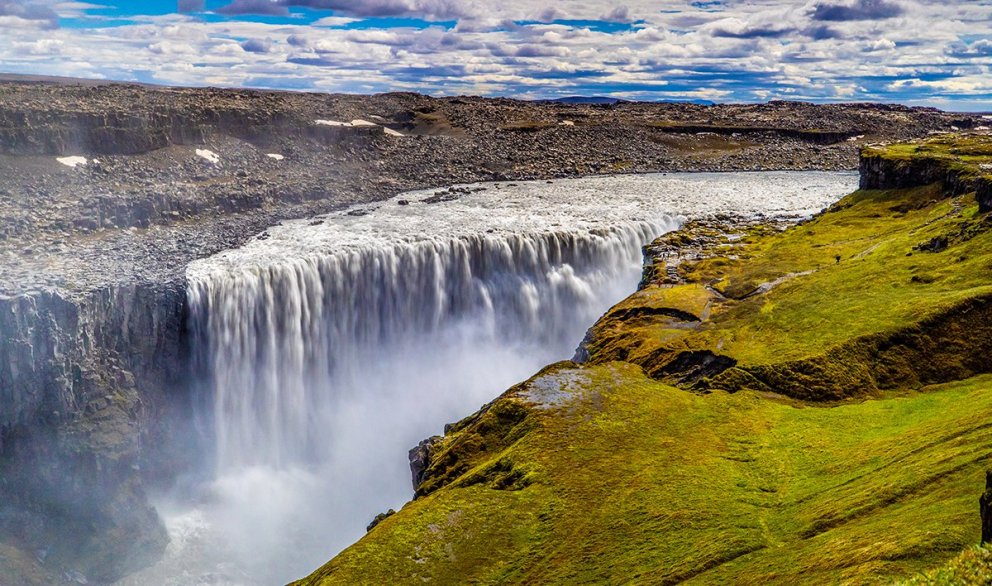
Waterfall Dettifoss is the most powerful waterfall in Europe and a part of the tourist route Diamond Circle.
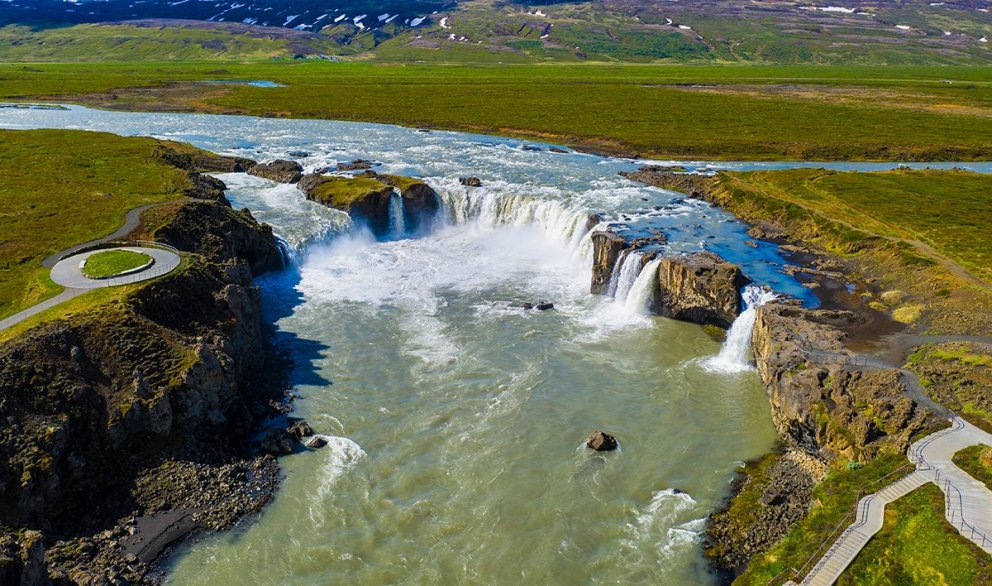
The Goðafoss waterfall is one of the most spectacular waterfalls in Iceland.
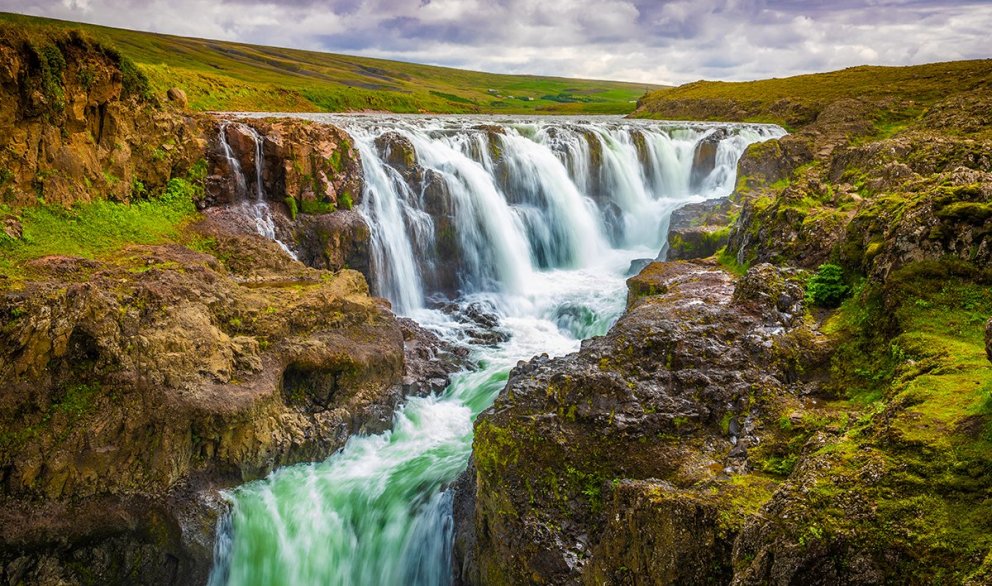
It is a breathtaking sight to walk on to the viewing platform and watch the calm waters of the river tumble onwards over so many impressive falls.
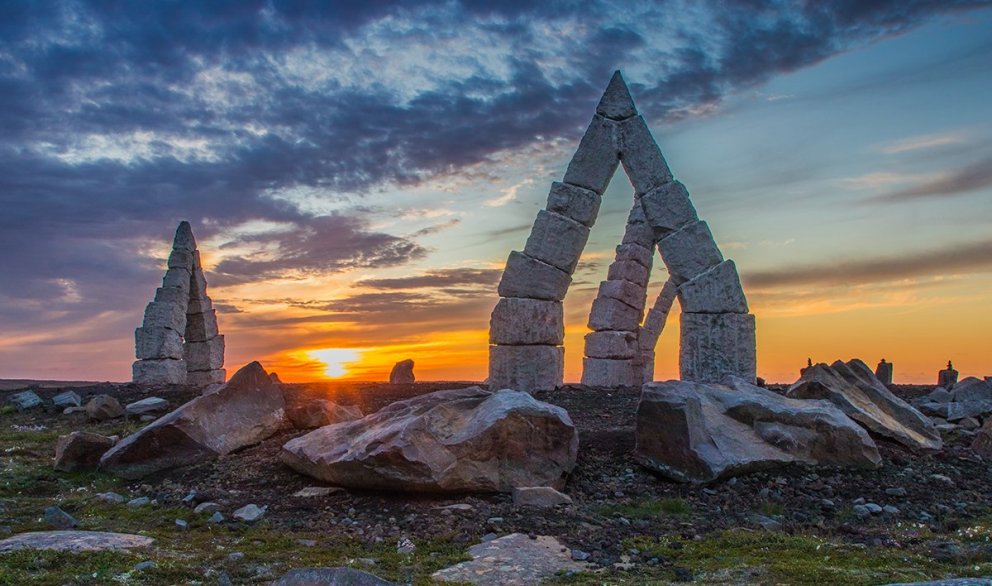
The Arctic Henge is like a huge sundial, aiming to capture the sunrays, cast shadows in precise locations and capture the light between aligned gateways.
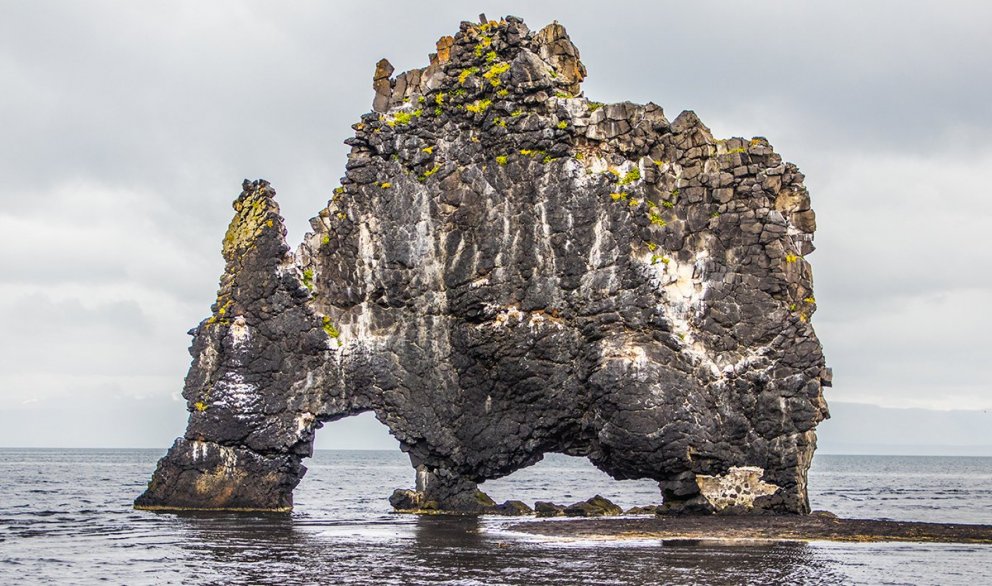
A 15-meter high sea stack just off the shore at Vatnsnes peninsula. Hvítserkur is also located along the tourist route Arctic Coast Way.
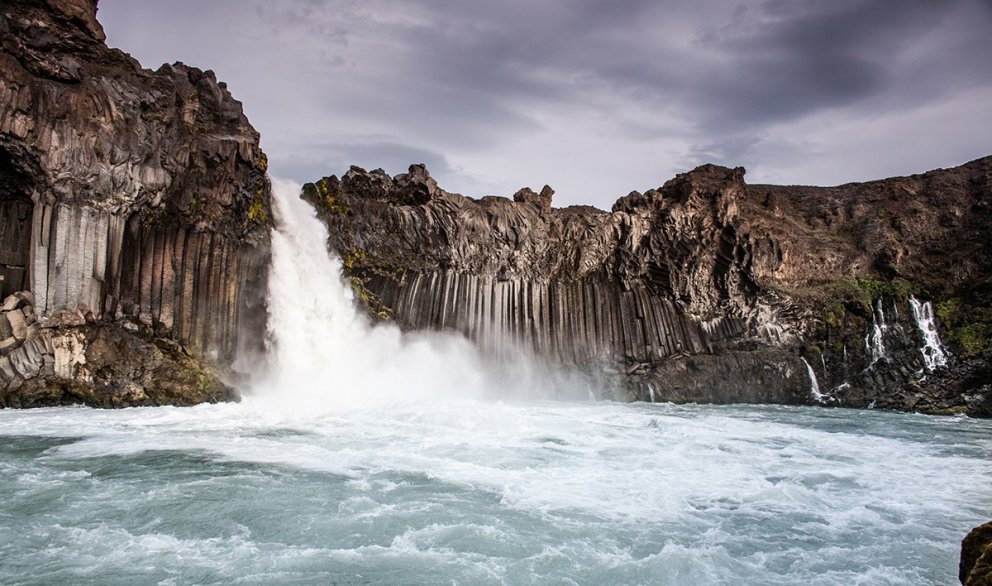
The waterfall is framed with long, natural basaltic columns and is located on the Sprengisandur highland route.
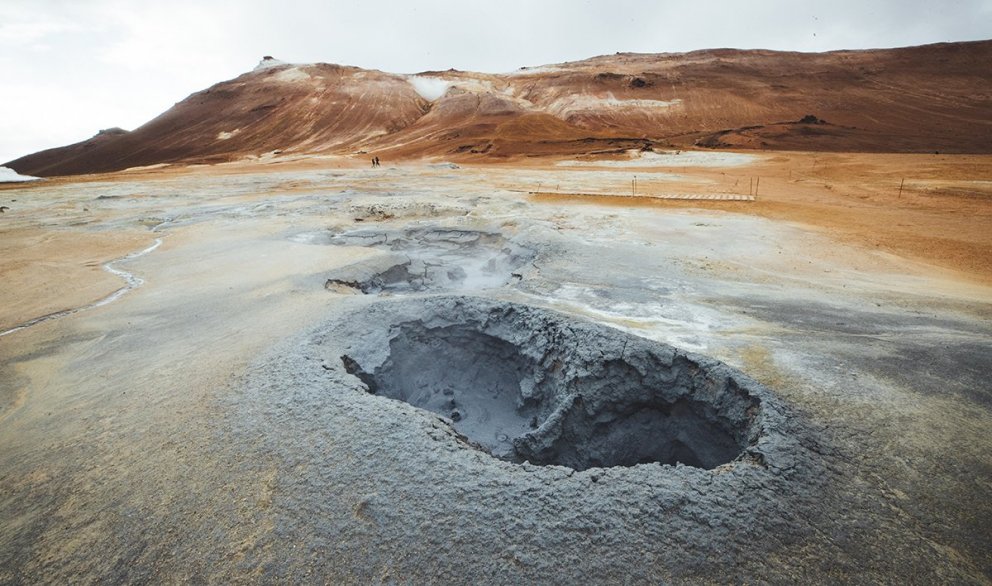
At the foothills of this spectacular volcanic mountain is an expanse of hot springs called Hverir that are known for their variety. You will also discover fumaroles, mud pools and mud pots that all seem to be boil with relentless energy.
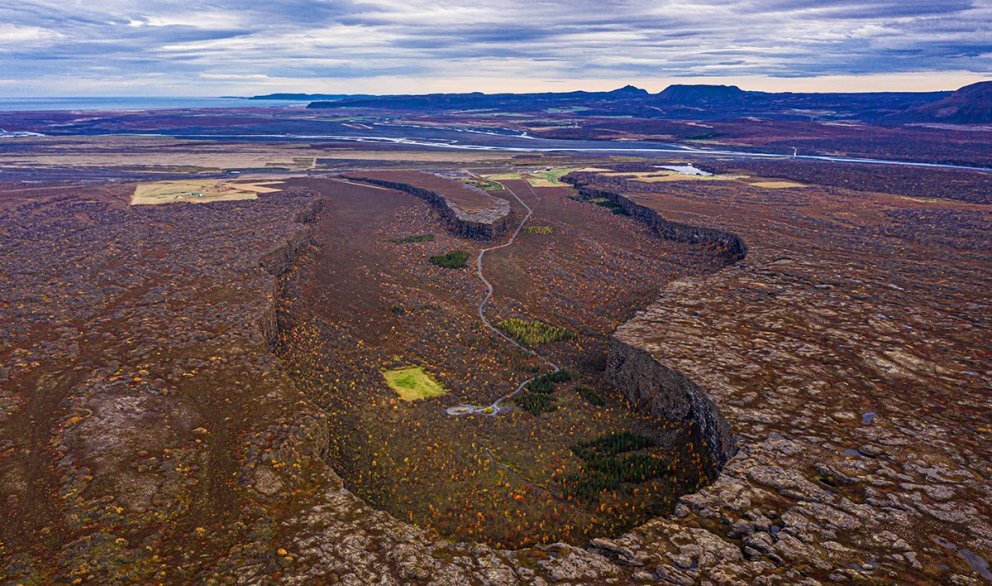
Ásbyrgi is one of the wonders of nature, a well-forested horse-shoe-shaped canyon in Oxarfjordur. Ásbyrgi is a part of both Diamond Circle and the Arctic Coast Way.
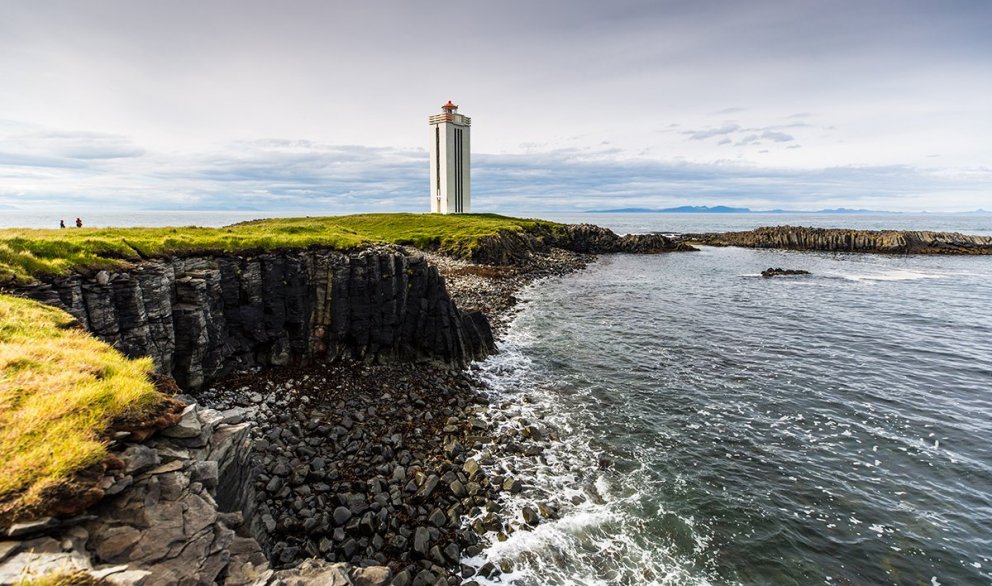
Kálfshamarsvík is a small cove with unusual, beautifully formed sea cliffs of columnar rock, created about 2 million years ago. It is located along the tourist route Arctic Coast Way.

- What to see
North Iceland
Northern Iceland and the Trollaskagi Peninsula are a must on any route through Iceland and are an ideal region for enjoying nature and whale or puffin watching .
What to see in North Iceland
Trollaskagi peninsula, siglufjördur, you may also be interested in.
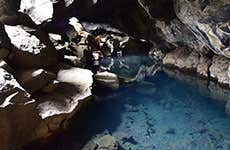
One of the most popular tourist attractions near Lake Myvatn, Grjótagjá is a small lava cave that served as a Game of Thrones filming location for the romantic scene between Jon Snow and Ygritte.
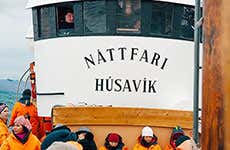
With just over 2000 inhabitants, Húsavík has established itself as an essential stop on any route around Iceland as it is an ideal place to see whales and puffins.
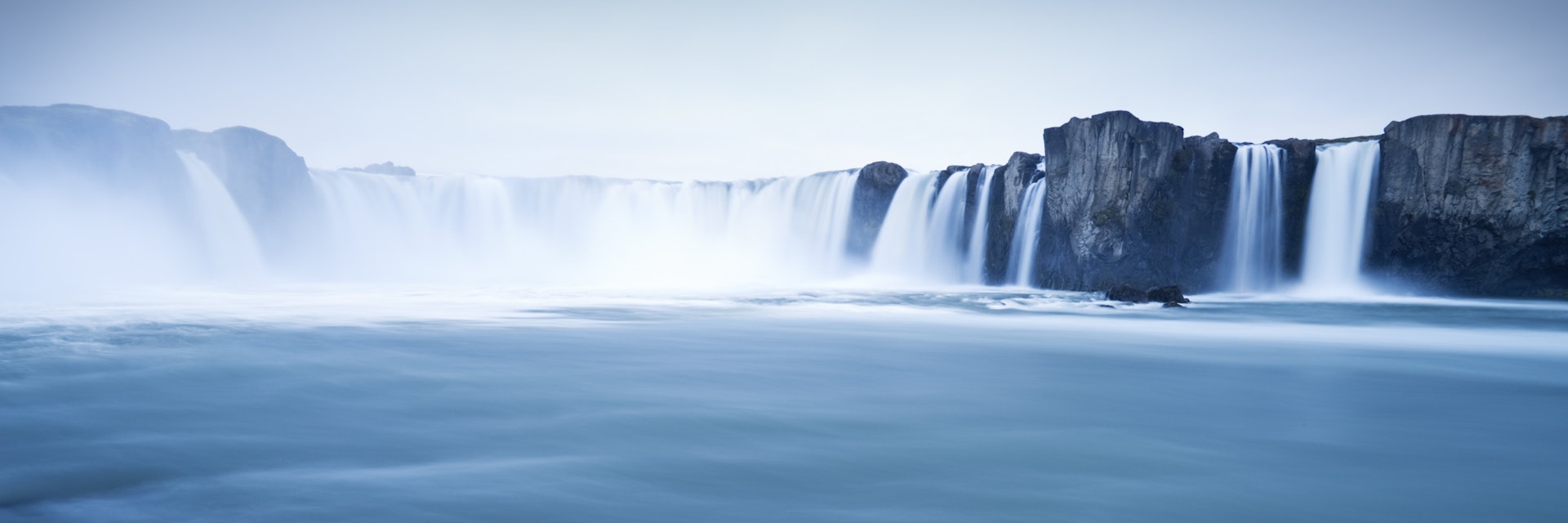
Justin Foulkes
North Iceland
Iceland’s mammoth and magnificent north is a geologist’s heaven. A wonderland of moonlike lava fields, belching mudpots, epic waterfalls, snowcapped peaks and whale-filled bays – this is Iceland at its best. The region’s top sights are variations on a couple of themes: the grumbling, volcanically active earth, and water and ice coursing towards the broad coast.
Leave the planning to a local expert
Experience the real North Iceland. Let a local expert handle the planning for you.
Attractions
Must-see attractions.
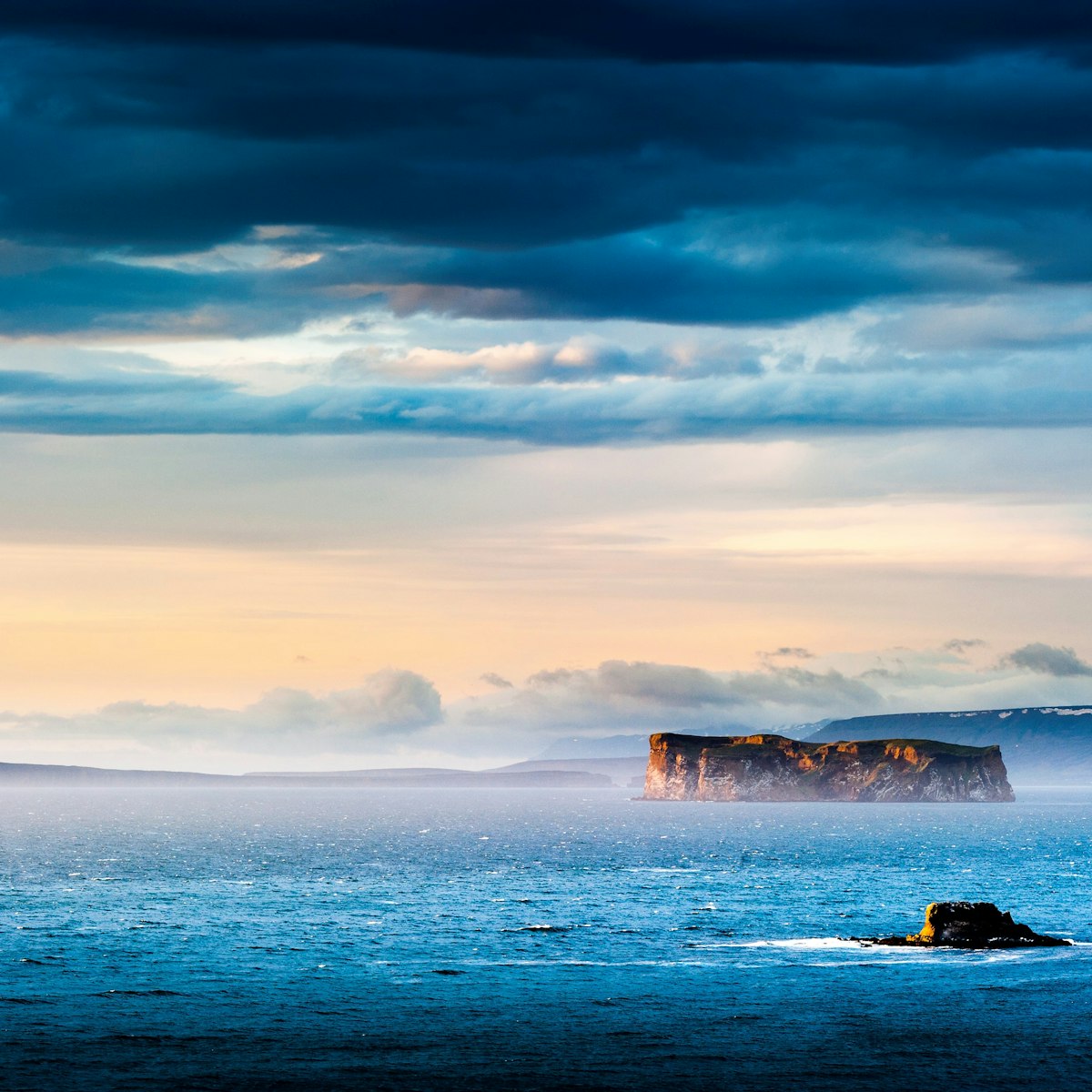
The tiny rocky islet of Drangey (drown-gay), in the middle of Skagafjörður, is a dramatic flat-topped mass of volcanic tuff with 180m-high sheer…

The 18th-century turf-farm museum at Glaumbær is the best museum of its type in northern Iceland and worth the easy 8km detour off the Ring Road,…

Herring Era Museum
Tröllaskagi
Lovingly created over 16 years, this award-winning museum does a stunning job of recreating Siglufjörður’s boom days between 1903 and 1968, when it was…

Dimmuborgir
Mývatn Region
The giant jagged lava field at Dimmuborgir (literally ‘Dark Castles’) is one of the most fascinating flows in the country. A series of nontaxing, colour…

Hljóðaklettar
The bizarre swirls, spirals, rosettes, honeycombs and basalt columns at Hljóðaklettar (Echo Rocks) are a highlight of any hike around Vesturdalur and a…

The dramatic lava cave at Lofthellir is a stunning destination, with magnificent natural ice sculptures dominating the interior. Although it's one of…

Goðafoss (Waterfall of the Gods) rips straight through the Bárðardalur lava field along Rte 1. Although smaller and less powerful than some of Iceland’s…

Dominating the lava fields on the eastern edge of Mývatn is the classic tephra ring Hverfjall (also called Hverfell). This near-symmetrical crater…
Plan with a local
Experience the real Iceland
Let a local expert craft your dream trip.
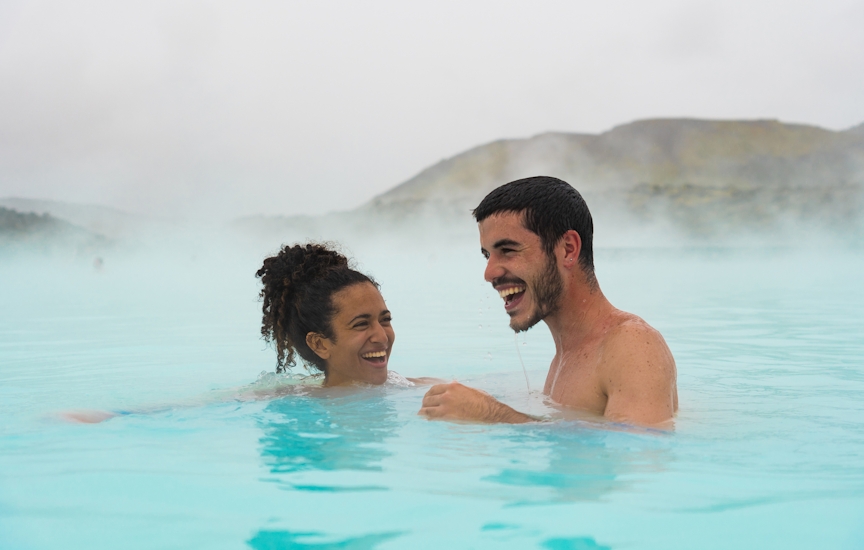
Latest stories from North Iceland
Filter by interest:
- All Interests
- Adventure Travel
- Art & Culture
- Beaches, Coasts & Islands
- Food & Drink
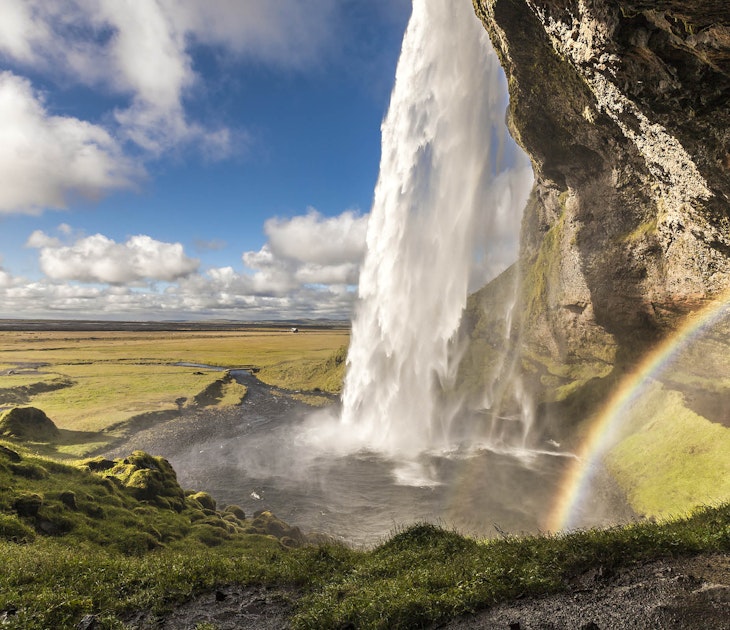
Wildlife & Nature
Jan 31, 2020 • 5 min read
Discover haunting lava fields, wild coastline, powerful waterfalls and majestic ice caps on an elemental journey around Iceland’s Ring Road.
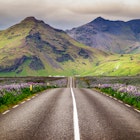
Jun 6, 2019 • 3 min read
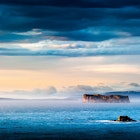
Apr 15, 2019 • 6 min read
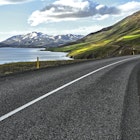
Mar 13, 2018 • 6 min read
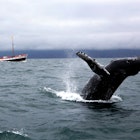
Oct 6, 2017 • 6 min read
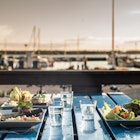
May 31, 2017 • 6 min read

Aug 8, 2011 • 2 min read
Purchase our award-winning guidebooks
Get to the heart of North Iceland with one of our in-depth, award-winning guidebooks, covering maps, itineraries, and expert guidance.
North Iceland and beyond
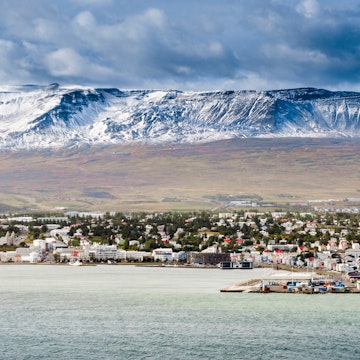

Home » Travel Guides » Iceland » 15 Best Things to Do in North Iceland
15 Best Things to Do in North Iceland
Volcanoes, steaming lava fields, bubbling mud pools, waterfalls and geothermal springs all await in primordial North Iceland.
In this region just a few kilometres from the Arctic Circle you may feel at the end or the beginning of the earth.
North Iceland’s natural marvels are spread around a vast and unpopulated area, where the largest town by far is Akureyri, home to just 18,000 people.
To make things easier you can follow itineraries like the Diamond Circle, leading from the lonely port at Húsavík to awesome glacial canyons, the most powerful waterfall in Europe and Lake Mývatn, which has a world of alien volcanic landforms on its shores.
The coast, on the Greenland Sea is the best place to see whales in Iceland and Húsavík has a world-class museum about the cetaceans of the North Atlantic.
Let’s explore the best things to do in North Iceland :
1. Herring Era Museum

In Siglufjörður there’s a salting station that was once the centre of Iceland’s lucrative herring fishery.
In the first half of the 20th century Siglufjörður was sometimes described as the “Atlantic Klondike”, with thousands of speculators showing up for a slice of the vast wealth generated by the Atlantic herring.
The salting station was abandoned 1969 after herring simply disappeared from this corner of the Atlantic, and an ensemble of buildings was converted into a museum in 1994. The Róaldsbrakki, a Norwegian salting station, dates to 1907 and has artefacts like salting barrels and black and white photos conveying the atmosphere in Siglufjörður at the time.
Grána is a herring factory from the 1930s, with heavy machinery gathered from herring sites around Iceland, while the Boathouse recalls the bustling waterfront in Siglufjörður and has ten vessels docked on its piers.
2. Lake Mývatn

Close to the Krafla Volcano, Lake Mývatn is prized for its salmon and trout stocks, while the surrounding wetlands are protected as a natural park.
The lake was created by an eruption 2,300 years ago and is embedded in a peculiar volcanic landscape of rootless vents and lava pillars.
The birdlife on the shores is astonishingly rich, and a new Bird Museum has been opened to document the many waterfowl species (common scoter, red-breasted merganser, gadwall) that frequent the lake in summer.
Enclosing the lake is a world of bizarre volcanic sights, from craters to geothermal pools and bubbling sulphur springs.

Ten kilometres in diameter and up to two kilometres deep, the active Krafla caldera near Lake Mývatn has lava fields that are still warm and scattered with volcanic features like rifts, gullies and lava flows.
There were nine eruptions at Krafla between 1975 and 1984, during which an epic magma chamber became visible from the surface.
At Leirhnjukur there’s a hiking trail through a sulphuric terrain, where steam rises from the ground and there are neon-coloured mosses by the path.
Just remember to avoid the light clay, as it can be hot enough to melt the soles of your shoes.
Víti Maar (Crater of Hell) meanwhile is a crater that took shape after a steam explosion in 1724 and has a teal-coloured lake.
4. Mývatn Nature Bath

Up the slope from Lake Mývatn is a quieter North Icelandic equivalent to the Blue Lagoon in Grindavík.
With a view of the lake, the Mývatn Nature Bath is an inviting geothermal pool, which may be just what you need after picking your way over lava flows.
The waters are claimed to be beneficial for respiratory and skin complaints.
There’s more room to move around at the Mývatn Nature Bath, and everything’s a bit more relaxed: You can even take a beverage into the water with you and look down towards the green shores of Lake Mývatn.
The main pool has a temperature in the high-30s, and there are also two steam baths, which get closer to 50°C.
5. Hveraströnd Sulphur Springs

East of Lake Mývatn and in the shadow of Námafjall is a geothermal field on the mid-Atlantic Ridge, where temperatures not far below the surface soar to more than 200°C. Above, the landscape looks like something from another planet, with boiling mud pools, steam fumaroles and earth tinted yellow by the sulphur.
There’s no vegetation to speak of at Hveraströnd, and you have to bring a camera to capture the desolation and the plumes of steams rising from the hissing fumaroles and pools.
In the late-Medieval period Hveraströnd was a key source of the sulphur that went into early gunpowder.
6. Grjótagjá

Avid Game of Thrones watchers may want to make the pilgrimage to this beautiful lava cave with a hot spring, around 1.5 kilometres east of Lake Mývatn.
In the episode Kissed by Fire in season 3, this is where Jon Snow and Ygritte have an “encounter” causing Jon Snow to break his Night’s Watch oath.
The pool in the cave had been used for bathing since the 1930s, but became dangerously hot after the Krafla eruptions in the 70s and 80s.
Since the 90s temperatures have slipped below 45°C and bathing has been allowed once more.
7. Dimmuborgir

Translating to “Dark Castles”, Dimmuborgir is a group of strange lava fields left over from an eruption in the Þrengslaborgir and Lúdentsborgir crater row 2,300 years ago.
Just past the east shore of Lake Mývatn, Dimmuborgir was formed when lava, ten metres deep, pooled on top of a small lake and marsh.
As the water underneath boiled, the steam rising through the lava created bizarre formations like pillars, arches and bridges.
The top layer of lava drained away down the slope, leaving these eerie structures behind.
Dimmuborgir is the only place in the world where you can see these kinds of volcanic formations on land.
At the cafe you can try Hverabrauð, a sweet rye bread made in special wooden casks buried in geothermally heated ground.
8. Jökulsárgljúfur

The second longest river in Iceland, the glacial Jökulsá á Fjöllum has hewn away at the basalt to create an awe-inspiring canyon, 25 kilometres long, up to 500 metres wide and 120 metres deep.
In the canyon there is a chain of waterfalls: Selfoss, Dettifoss, Hafragilsfoss and Réttarfoss.
This natural monument is now the northernmost part of the enormous Vatnajökull National Park, which encompasses much of eastern Iceland.
One of the sights to search for in the canyon is Hljóðaklettar, a cluster of strange basalt columns, standing vertically, horizontally and diagonally.

Like many of the spots on this list, Ásbyrgi is on the Diamond Circle and has to be seen when you come by the Jökulsárgljúfur.
This horseshoe-shaped canyon is not far west of the Jökulsá á Fjöllum river and was shaped by catastrophic glacial flooding at the end of the last Ice Age, about 8,000-10,000 years ago and then again approximately 3,000 years ago.
The canyon walls are up to 100 metres high and shelter a forest of birch, willow, larch, spruce and pine on the fringes of the Botnstjörn lake, a remnant of the Jökulsá á Fjöllum, which has long since changed course.
The Eyjan (Island) rock sits in the middle of this formation and has a photo-worthy panorama of this breathtaking scene.
The traditional explanation for Ásbyrgi is that it was formed by the hoof of Sleipnir Odin’s eight-legged horse.
10. Goðafoss

Thirty metres across and twelve metres high, Goðafoss (Waterfall of the Gods) is sensational all year round and regarded as one of Europe’s most beautiful waterfalls.
If there’s a time when the falls are absolutely unmissable it’s around late-spring when the water is encrusted with icicles.
The name, Goðafoss comes from a story in Ari Þorgilsson’s Íslendingabók, written in the early 12th century.
A century before, in 999, the lawspeaker Thorgeir Ljosvetningagodi threw his pagan idols into the falls after deciding that Iceland should officially adopt Christianity at the Althing (parliament). The falls are on the 178-kilometre Skjálfandafljót river, beginning at the Vatnajökull ice cap in the Highlands.
11. Dettifoss

In terms of discharge, Dettifoss on the Jökulsárgljúfur canyon is Iceland’s largest waterfall.
In bare rocky scenery, this colossus is 40 metres high and 100 metres wide and has an average flow rate of 193 cubic metres a second.
Dettifoss is a mainstay of the Diamond Circle, and you may have seen it in Ridley Scott’s Prometheus (2012). The high water discharge generates a thunderous roar, and propels spray high above the canyon walls.
On sunny days there’s invariably a rainbow in the canyon.
Dettifoss can be accessed by the gravel Route 864 and the recently laid 862, which has a tarmac surface.
You can embark on the hike of a lifetime from these falls to Ásbyrgi, around 30 kilometres away.
12. Húsavík

Just below the Arctic Circle, the fishing port of Húsavík in Skjálfandi Bay was, according to the Landnámabók (Book of Settlement), the first place in Iceland to be settled by Norse man, in the winter of 870. And from this the port, silica harvested at Lake Mývatn was exported to Scandinavia and the European mainland.
Now it’s a hub for the fishing industry on the north coast, and the best place in Iceland for whale spotting expeditions.
Appropriately, Húsavík Whale Museum, set in the town’s old slaughterhouse is a supreme exhibition on the whales that inhabit the North Atlantic.
There’s in-depth information about each of these cetacean species, their eco-systems and the history and present of the whaling industry in Iceland.
You can view complete skeletons of minke, sperm, pilot, humpback, beaked and bottlenose whales.
13. Whale Watching Tours

More than 20 types of cetacean can be spotted in the waters around Iceland from April to September, and Húsavík’s location in Skjálfandi Bay on the Greenland Sea makes it the prime whale watching location.
For round ISK 12,500 ($100) a variety of companies will take you on a three-hour tour of the bay where the likelihood of sighting fins, tails, blowholes or full breaches is always high.
You’ll be in the company of an expert and personable guide who can fill you in on the behaviour of minke, humpback and blue whales, and ensure you don’t miss anything.
The island’s in the bay, like Flatey and Lundey also have huge puffin colonies that you can observe.
Cold-weather gear will often be provided, and a cup of hot chocolate and a cinnamon will keep your spirits up.

On Eyjafjörður, Laufás was first mentioned in the earliest days of the Settlement of Iceland at the turn of the 10th century.
You can head there now to explore a manor/farm dating back to the 1600s, all with a photogenic mountainous backdrop.
The unusually grand manor house has was built in the second half of the 19th century using timbers from 200 years before, while the church on the site is from the same period but its fittings are much older and include a pulpit from 1698. The manor’s out buildings, including a row of delightful Icelandic turf houses, are furnished with farming tools and everyday implements from the turn of the 20th century when the farm was still running.
15. Akureyri Botanical Garden

In the town of Akureyri at the southern end of Eyjafjörður, this restful plant-based attraction has one of the most extreme locations for botanical garden on the planet.
Akureyri is just 50 kilometres south of the Arctic Circle, but there’s an unusually warm microclimate as the mountains buffer the fjord against the vicious winds.
This space was opened to the public as a park in 1912 and has been a botanical garden since 1957, now growing around 7,000 species from Arctic, temperate and mountainous zones.
Some 400 of these, growing in the southeastern corner of the garden, are flowers native to Iceland’s heaths and mountains, like dwarf birch, Bellard’s kobresia, the highland rush, dwarf fireweed and moss campion.
15 Best Things to Do in North Iceland:
- Herring Era Museum
- Lake Mývatn
- Mývatn Nature Bath
- Hveraströnd Sulphur Springs
- Dimmuborgir
- Jökulsárgljúfur
- Whale Watching Tours
- Akureyri Botanical Garden
7 Awesome things you can do in Northern Iceland
Last Updated on November 4, 2023 by

Northern Iceland is often overshadowed by the abundant mind-blowing landscapes of the South, but it’s truly a diamond in the rough, waiting to be discovered. While venturing north is sometimes considered an adventure for the brave, I firmly believe that Northern Iceland is a fantastic alternative to the more frequented paths in the country. If you’re seeking an experience beyond the the busy roads of the Golden Circle , then heading north is the way to go. In this guide, you’ll find a detailed itinerary for a 2-3 day road trip to Northern Iceland, offering insights into the best things to do and helping you plan your next fantastic adventure in this remarkable region.
Table of Contents
Tips for Visiting Northern Iceland

In this section, you will find the best tips to plan your adventure to Northern Iceland. Indeed, this part of the country, is slightly different from the Southern part, making travel slightly challenging in adverse weather conditions.
When is the best time to visit Northern Iceland?
The roads and weather conditions in Northern Iceland can be quite different from other regions of the country, particularly to the more touristy areas. While visiting during winter has its advantages, such as the chance to witness the Northern Lights, it also comes with potential hazards such as heavy ice on the roads and adverse weather conditions. For the most comfortable and accessible experience, the best time to visit Northern Iceland typically ranges from late April to mid-October. However, for personal experience, during April, you might still encounter some icy roads, but most of the attractions are open and visitable, providing a more pleasant and safer travel experience.
Road accessibility and weather conditions in Northern Iceland
It’s crucial to consider the timing of your visit to Northern Iceland, especially in terms of road accessibility. While other areas of Iceland may have passable roads, some routes in Northern Iceland might be closed due to snow and ice. For example, when we visited in April, we couldn’t access Dettifoss because the road was blocked by snow and ice.
Weather in Iceland can be highly unpredictable and this might affect your journey in a serious way. For this reason there are two essential tools that you need to keep handy for your journey. The first is the app Veður. This is developed by Icelandic Meteorological Office and gives you accurate weather predictions for your area. This includes also notifications for potential weather hazards in your area (e.g. we received one when we were in Reynisfjara).
You can download Veður on both IOS and Android .
The second, is the Road and Weather conditions live updates from Road.is. There used to be an app but this has been discontinued and now you can check live updates here . This is a very useful tour if you are doing an Iceland road trip as it gives you an easy to understand and updated report of most roads in the nation.
Lastly, Avoid driving at night on unfamiliar and icy roads, and whenever possible, stay on the Ring Road if you have doubts about road conditions. Icelandic roads can become extremely treacherous in unpredictable weather conditions. Your safety should always be the top priority, so exercise caution and make informed choices when traveling in these conditions.
Dining and Grocery in Northern Iceland
It is wise to plan your activities in advance, especially where and when you intend to dine. Dining options can be limited in this region. Therefore, I recommend choosing one of the main cities like Húsavík or Akureyri, which offer more extensive services. If you’re staying in an isolated location, be sure to pack groceries before starting your trip. Indeed, there are not many supermarkets along the road in the more remote areas of Northern Iceland. If you are driving longer stretch of road ensure to check the fuel stations and any supermarket/restaurants along the way before embarking on your journey.
Proper planning will enhance your experience and ensure you have what you need during your journey.
What to wear in Northern Iceland

Wearing proper waterproof and insulated boots is a smart choice when visiting Northern Iceland. You’ll often find yourself walking on snowy terrain, and the temperatures in this region can be colder than in Southern Iceland. Wearing layers is always an optimal choice when visiting colder places.
How many days do I need to visit Northern Iceland?
Northern Iceland is a region brimming with incredible sights and natural wonders. To fully explore the area and experience all it has to offer, dedicating 5 days would be an optimal timeframe. However, if you are on a longer itinerary of Iceland or have time constraints, 2 or 3 days are still sufficient to cover the main highlights and immerse yourself in the beauty of Northern Iceland. It’s a versatile destination that can be tailored to different lengths of stay, ensuring a memorable experience regardless of your schedule.
Can I see the Northern Lights in North Iceland?
Absolutely! Northern Iceland is one of the best places to spot the Northern Lights, also known as the aurora borealis. It offers several advantages for aurora hunting, including being less populated, having longer hours of darkness, and experiencing less cloud cover than other regions. Lake Myvatn, in particular, is renowned as a top spot for Northern Lights viewing.
However, it’s important to note that the area can be quite challenging to navigate, especially at night and in icy conditions. If you plan to venture off the beaten path for Northern Lights viewing, it’s advisable to undertake an organized tour. These tours typically provide experienced guides and the necessary equipment to ensure a safe and successful aurora-watching experience in Northern Iceland.
Why I should visit Northern Iceland?

A Geological Heaven
The Northern part of Iceland is truly a geological heaven, offering some of the most breathtaking landscapes and dramatic scenery. This region has no reason to envy the more famous Southern Iceland, as it boasts equally stunning natural wonders. What sets Northern Iceland apart is its relative lack of tourist attention, even during high season. This means that, even at the peak of travel, you have the opportunity to explore and experience many places with a sense of solitude.
During the spring season, temperatures can be quite chilly in the northern areas, given their proximity to the Arctic Circle. However, outdoor life remains enjoyable, and there are ample opportunities for day trips and outdoor adventures. The region is so rich in natural beauty and attractions that two days hardly seem sufficient to take it all in. I wish we spent more time exploring it!
Two-day itinerary of Northern Iceland
The map of Northern Iceland below provides a suggested two-day itinerary that’s easy to follow and covers some of the region’s top attractions. If you have more time at your disposal, you can easily incorporate additional attractions and points of interest along the way to further enrich your experience in this captivating part of Iceland.
Day one in Northern Iceland
On your first day in Northern Iceland, a great starting point is the city of Húsavík (Point A). Here, you can stock up on groceries for the day and plan your activities. Húsavík is located approximately 69 kilometers from your next destination, Krafla (Point B). The drive is relatively short, taking about one hour, and the landscape along the way is absolutely breathtaking. Depending on the conditions of Krafla (for example, when we visited, it was entirely frozen), you can spend anywhere from 30 minutes to an hour exploring the area.
From Krafla, it’s a quick drive of less than 10 kilometers (about 12 minutes) to reach your next stop, the stunning and colorful landscapes of Námafjall (Point C). If you have spare time and a sense of adventure, you can opt for a half-day hike in the volcanic mountains of Hverir. Alternatively, after your visit to Námafjall, you can hop back in the car and head to the Grjótagjá Cave (Point D), which is only 5.8 kilometers away (about an 8-minute drive).
The final stop of the day is the magnificent Goðafoss waterfall. This is located approximately 53 kilometers from your current position, and the drive takes about one hour. For the first day, we decided to stay in a pod in the middle of nowhere in Laxamýri. This location is only 39 kilometers from Goðafoss, making it an ideal place to potentially spot the Northern Lights and continue with your Northern Iceland itinerary.
Day 2 on Northern Iceland
On your second day in Northern Iceland, you can begin in the city of Akureyri ( Point F). This charming city offers plenty of opportunities for leisure, including exploring its lovely cafes and shops. You can easily entertain yourself here for a half day or more.
A second stop on your itinerary can be the delightful museum of Glaumbær (Point G), which is located approximately 102 kilometers from Akureyri. The drive will take around 1 hour and 20 minutes.
Admittedly, on our second day, we took it easy and enjoyed a more relaxed pace, as we had been on the road for several days by that point and wanted to enjoy the surrounding landscape. However, if you’re looking to add more spots to your itinerary, this part of Iceland offers plenty of attractions and natural wonders to explore. The choice is yours, and you can tailor your journey to your preferences and schedule.
Additional itinerary suggestions for Northern Iceland
If you have more time to dedicate to this wonderful region, I warmly suggest you to plan the following stops:
- Lake Mývatn and its Nature Baths is known for its stunning natural beauty. We visited briefly but not enough to consider it a proper stop. While there, you can consider relaxing in the Nature Baths , which are similar to the Blue Lagoon but less crowded. Entrance fee starts at 6,490 ISK per person.
- Dettifoss Waterfall is one of Europe’s most powerful waterfalls. As said before, this was one of our original stops but all the roads leading to the waterfall were closed for ice.
- The caldera of Askja is volcanic wonderland featuring a stunning caldera. Once you are there, if the weather allows it, you take a dip in the Víti crater’s geothermal lake.
- Hiking in the Súlur mountain. For those who enjoy hiking, consider adding an extra day to conquer the Súlur mountain, offering panoramic views and a rewarding outdoor adventure.
- Reykjafoss Waterfall is regarded as one of Skagafjörður’s hidden treasures. The path to reach the waterfall should be ok in every season.
7 awesome things to do in Northern Iceland
1. go whale-watching in húsavík.

Húsavík, a charming small fishing town nestled along Skjálfandi Bay, has a rich history. Its name, which literally means “bay of the houses,” hints at its historical significance. Indeed, according to Icelandic sources, Húsavík may well be the oldest Icelandic settlement. It’s believed that the Swedish explorer Garðar wintered here in 867. This would make Húsavík the first inhabited Icelandic settlement, pre-dating Ingolfur Arnasson’s settlement in Reykjavik.
While there may be no physical remnants of the old Norse village, the town has since transformed into a beautiful and vibrant community. Today, Húsavík is celebrated as a major tourist hub. Every year, it attracts visitors with its natural beauty, whale-watching tours, and a range of attractions that make it a must-visit destination in Northern Iceland.
Other things to do in Húsavík

In Húsavík, if whale watching isn’t on your agenda or you’re looking for alternative activities, there are many other delightful options to explore in this charming town. You can take a leisurely stroll around its peaceful harbor, soaking in the maritime atmosphere and scenic views.
For those interested in culture and history, consider taking a cultural tour through the town’s museums. Two major museums in Húsavík are The Museum of Exploration and the Húsavík Whale Museum . Both of them offer valuable insights into the region’s heritage and natural wonders.
Don’t forget to visit the photogenic Húsavíkurkirkja, a wooden church that has graced the main street of Húsavík since 1907. This charming church is a visual delight and a piece of local history that you won’t want to miss during your visit to the city.
2. Hiking in the Krafla caldera

The caldera of Krafla, which features a main crater known as Viti (meaning ‘Hell’ in Icelandic), has a fascinating history. This crater was formed during a massive explosive eruption that began in 1724 and lasted for approximately five years. In the years following the eruption, the crater truly resembled a “boiling hell,” earning its fiery name.
Today, the Viti crater boasts a diameter of 300 meters. This is fully walkable, offering visitors the chance to explore its remarkable landscape. During the summer, you’ll find a stunning turquoise lake at the bottom of the crater, creating a picturesque scene. While we couldn’t witness this due to the frozen conditions during our visit (we just hiked up and down), the beauty of the Krafla area is still undeniable. The smoke rising from the volcanic ground added a unique mood to the atmosphere.
As you approach the crater, you’ll also encounter intriguing structures. These belong to the nearby Power Station, which operates in close proximity to the caldera. These structures, resembling lunar bases, are quite photogenic and add to the otherworldly ambiance of the area.
3. Walk in a Mars-looking scenery at Námafjall Hverir

Can you see how beautiful is this scenery? Well, prepare yourself for an equal amount of smell! Indeed, these amazing colours are due to the sulphur crystals surrounding the mud pools and sulfataras characterising the area. The pungent smell is a testament to the geothermal activity beneath the surface. However, it’s remarkable how one can acclimate to the smell and fully appreciate the breathtaking landscape. Námafjall was undoubtedly one of the highlights of our Northern Iceland tour. Moreover, its expansive geothermal area is one of the largest in the country.
Námafjall’s accessibility from Lake Myvatn and the East Fjords makes it a convenient addition to the North Iceland itinerary. Especially if you’re planning a day trip to Krafla. The active fumaroles, that abound in this geothermal area, truly enhance the scenic beauty. This will make you feel as if you’ve stepped onto another world. It’s a surreal and captivating experience that will adds a unique dimension to your Northern Iceland journey
Visiting Námafjall Hverir. Things to know

Navigating the Námafjall geothermal area requires caution. Indeed, the paths may not always be clearly visible, and getting too close to the mud pools can be dangerous. If you have the time and an adventurous spirit, the Námaskarð Pass hike is very recommended. Indeed, it provides an opportunity to delve deeper into a landscape that resembles something out of a science fiction novel, akin to the surface of Mars.
What’s even more mind-blowing is that despite its Martian appearance, Námafjall played a significant role in NASA’s training for the Apollo lunar missions. In fact, the geological conditions found in some Icelandic areas serve as planetary analogs to those of the moon.
The intense smell and the steam coming from the ground work as a good reminder of how powerful and beautiful is our planet! I really enjoyed my visit to this place and I hope to go for a second round tour!
4. Live a GoT adventure in the Grjótagjá Cave

If you are a fan of Game of Thrones, you don’t want to miss the occasion of visiting this little hidden gem at just ten minutes from Námafjall and Lake Myvatn. Famous for being the Jon Snow and Ygritte’s cave, Grjótagjá was actually used as a thermal bath by Icelanders. Nevertheless, this was until the ’70, when a powerful eruption caused a sudden rise of the water temperature, which became above 50 degrees.
Today, bathing in Grjótagjá is not recommended . In fact, the water temperature is still very fluctuating passing from mild to boiling hot. The cave is also quite small and with a low ceiling. Unless you want to swim, I’m not sure it would fit more than five people.
5. Search for the Norse Gods at Goðafoss

Have you ever visited a natural landscape that is also a piece of history? Well, Goðafoss is precisely that. In fact, its name literally means “Waterfall of the Gods.” The waterfall is nothing less than a reminder of a significant chapter in Icelandic history.
The name originates from a famous “episode” involving Þorgeir Ljósvetningagoði, a lawmaker of Þingvellir. He made the difficult decision to abandon paganism in favor of the new Christian religion in the year 1,000. According to the Icelandic Saga, this decision followed a very difficult and sleepless night. During this night, the Asatru priest, as a symbol of this change, cast the idols of the Norse Gods into the waterfall. From that moment onward, the waterfall acquired the name Goðafoss.

Reaching the waterfall is very easy. You can find it along the road between Akureyri and Husavik. There are plenty of road signs clearly indicating the location of the waterfall. Therefore, you don’t need to worry about getting lost. Goðafoss falls from a height of 12 meters and has a width of about 30 meters. If you are visiting during the summer season, you might also want to consider adding the nearby Dettifoss to your North Iceland itinerary.
6. Warm your afternoon in a Akureyi café.

Akureyri is the second-largest urban area in Iceland, following Reykjavik. It’s often referred to as the “Iceland’s capital of the North.” According to Icelandic sources, the area was colonized during the early Middle Ages by Norse populations. Today, this vibrant city is primarily known as a fishing and cultural centre.
The city is much quieter than Reykjavik, especially in the winter and spring, with fewer tourists and crowds. Akureyri is a fascinating place, with its vibrant colours and lively atmosphere.
The city offers many charming cafes where you can warm up after a day of exploring in the cold North Icelandic breeze. One of the nicest cafes we visited was Bláa Kannan Café , located on the main street of the city, offering a great selection of cakes and freshly baked bread.

We truly enjoyed our time in this cozy cafe, especially when the weather outside was too cold for extended outdoor exploration. One piece of advice: when ordering food, especially cakes, it’s a good idea to ask about the ingredients. Icelanders have unique tastes, and you may encounter some unusual food combinations!
7) Visit the Icelandic version of the Shire at Glaumbær

One of the highlights of our North Iceland itinerary was undoubtedly the isolated village of Glaumbær. The village is entirely constructed using the traditional turf-building technique. This has been used in Iceland since the time of the Vikings. While these houses were once inhabited by Icelanders, the entire area has now been turned into a museum.
Glaumbær dates back to the 18th century and is one of the best-preserved villages of its kind. In cold environments like Iceland, turf houses offered superior insulation compared to wooden structures, until modern architectural techniques were introduced.
It’s worth noting that until the early 20th century, many Icelanders lived in turf houses. However, with the advent of new technologies and improved insulation methods, turf houses gradually have been abandoned in favour of modern homes. Still, as you travel around Iceland, you can spot some of these characteristic buildings that are typical of the Icelandic landscape.
As a Tolkien enthusiast, I must admit I loved how this village resembled an Icelandic version of the Shire. The charming houses covered in grass and the vibrant colours set against the vast valley backdrop, felt like a scene from a Tolkien book.
Tips for visiting Glaumbær

Glaumbær operates as a museum, and there is an entrance fee if you visit in the morning. However, if you choose to visit in the late afternoon or at dusk (as we did), you can freely stroll around these charming houses without any issues. During our visit, we were the only ones there at that time.
Keep in mind that you won’t be able to enter inside the houses during the late afternoon visit. That privilege is reserved for morning visitors. However, if your main goal is to capture some beautiful photos and soak in the unique atmosphere, the late afternoon is likely the best time to do so.
Where to Stay in Northern Iceland

During our stay in Northern Iceland, we opted for two primary accommodations. On the first night, we booked one of the cube flats called Laxhús . This location is situated roughly 58.8 miles from Laxamyri and only 5 miles from Husavik.
Laxhús can be a bit on the pricey side compared to some other accommodations in Iceland, with a cost of about £170 or €200 per night. However, it offers excellent value for the price, providing all the amenities you need for a comfortable stay. The well-equipped kitchen includes a cutlery set, microwave, plates, and a coffee machine. You also get your own private terrace, a TV, and a spacious bedroom. Not to mention, the stunning Icelandic views directly from your window are worth the expense. Additionally, we were fortunate enough to witness the Northern Lights during our stay here. If you can’t catch the aurora from your terrace, you’re free to use the open area behind the cube for stargazing.

On our second night in Northern Iceland, we chose to stay at Guest House 46 (formerly known as Guesthouse Höfðabraut) in Hvammstangi. The hosts, Steinbjörn and Eva-Lena, were incredibly welcoming, making us feel right at home. Our room was on the smaller side but still cozy, and we enjoyed a fantastic view. Steinbjörn even prepared breakfast for all the guests in the morning. If you’re looking to connect with locals and experience an authentic Icelandic atmosphere, this is one of the best places to consider. Rates start at £65 per night for a double room.
Where to eat in North Iceland
Cooking at “home” during our North Iceland trip turned out to be a great choice. We found supermarkets in the cities of Akureyri, Húsavík, and Hvammstangi, which made it convenient to shop for groceries. Most Icelandic guesthouses are well-equipped for cooking, so we prepared our own dinners. Not only did we save more than 75% on our budget, but we also enjoyed the experience. Since many places outside of the major cities don’t have restaurants open at night, having a meal in the comfort of your accommodations is a practical and enjoyable option.
Plan your trip to Iceland

Liked this blog? Pin it for later!
Share this:
You may also enjoy:
Everything you need to know to visit …, a perfect gateway to mount etna: donna …, 3 best christmas markets to visit in belgium, 10 unique things you can do in marrakech, tell me what you think, leave a reply below cancel reply, the historian traveller instagram, where is laura.
Email address
Privacy Overview
Subscribe to the historian traveller newsletter, looking for something.
North Iceland
Dancing along the edge of the Arctic Circle, North Iceland probably sounds pretty cold! However, in reality, this area experiences some of the mildest temperatures in the country. This part of the country offers a huge spectrum of scenery to explore, from the soft and gentle to the awesomely spectacular.

The North is rich in history as well as wildlife, with amazing volcanic landscapes, unusual museums, a wealth of antique farms, fjords and saga sites. It is no wonder the region was recently named a top European destination by Lonely Planet!
It is hard to resist its appeal and only a few places can compare with its local charm, staggering remoteness and natural contrasts all melted together in one place. Let’s see what the North of Iceland is all about!
Attractions in North Iceland
- Dettifoss Waterfall
- Lake Myvatn
- Hverfjall Crater
- Dimmuborgir Lava Park
- Godafoss Waterfall
- The Town of Siglufjordur
- Hvitserkur Rhino Rock
North Iceland is home to the unexpectedly lush Jokulsargljufur area, the northern section of Vatnajokull National Park including Dettifoss, Europe’s most powerful waterfall. The name, Dettifoss, roughly translates the ‘falling’ fall likely grown from its incredible force. If you are looking to reconnect with nature, coming up close and personal with its exhilarating power then this is the spot!

Let’s start with the North East of Iceland
In the northeastern corner, you will also find the enchanting Lake Myvatn with all its many gems. The lake itself is a beautiful sight but surrounding it are the pseudocraters Skutustadagigar, the pitch-black crater mountain Hverfjall, Hverir or Hverarond hot spring string, the turquoise blue water in the volcanic crater Askja, Myvatn Nature Baths the North’s answer to the Blue Lagoon, Dimmuborgir and the infamous Krafla caldera which has erupted 29 times in recorded history. Many of which were in the 1970’s and 1980’s!
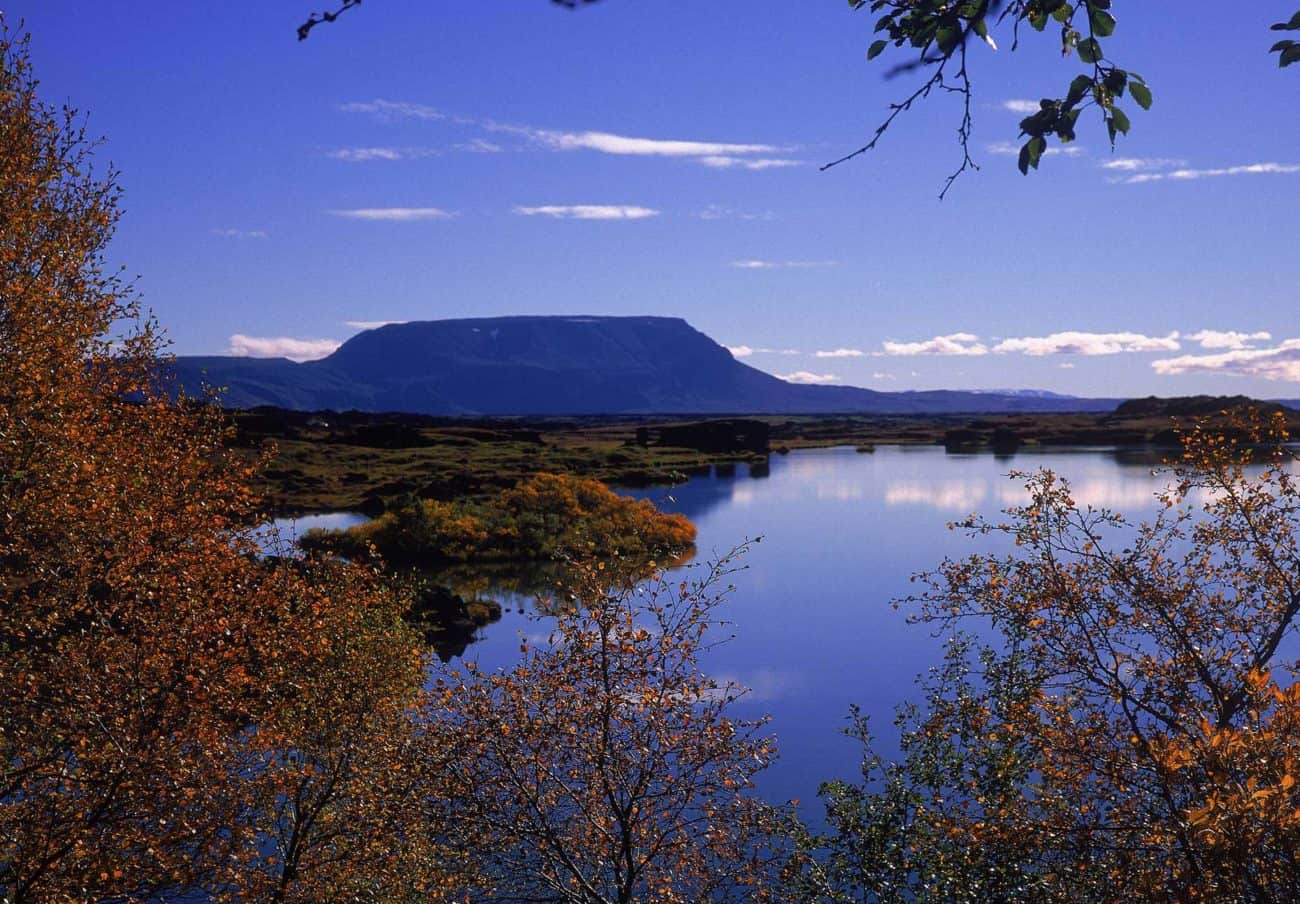
Another must-stop is of course the dazzling, heavenly Godafoss. Often nicknamed the waterfall of the gods. But Þorgeir Ljósvetningargoði ( yes, that was his name ) is said to have thrown his pagan statues into the falls upon taking up Christianity. Evidently, this event led to the namesake which we still use today.

On Skjalfandi Bay, Husavik has established itself as Europe’s main whale watching mecca with the superb harbor-side Whale Museum and sightings of rare species like the blue whale. There you can also find the extraordinary new facility, GeoSea, offering a splendid infinity pool style bathing.
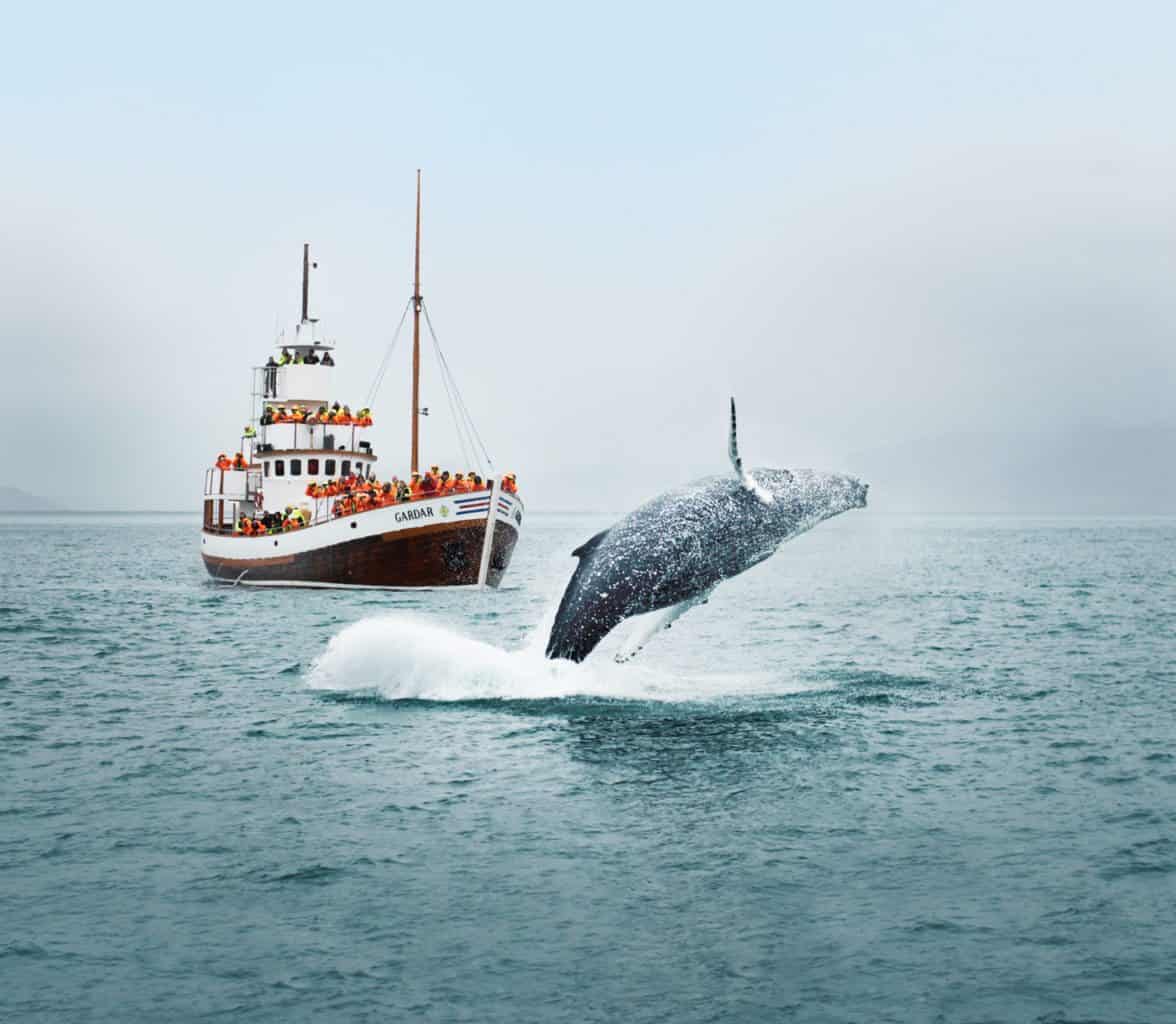
Now Let’s move to North West Iceland
Another charmer worth a mention is the colorful fishing village Siglufjordur. Not only is it rich in history, as the town once housed thousands of people who came to work the golden herring age in the town, but recently the local people have placed great effort and funds into restoring its old status. Old houses have been rebuilt, renovations on the once that still stood left, new restaurants and museums have opened up and the town is once again lively and exciting. Moreover, the town is excellent for skiing so this spot is great any season!
Next on our countdown is Skagafjordur bay, with its green valleys and ancient mountain ranges, is the traditional heart of horse breeding in Iceland and boasts many historical sites from the classic Sagas. It is a place of great natural warmth, so hot spring bathing is a given at almost every turn.
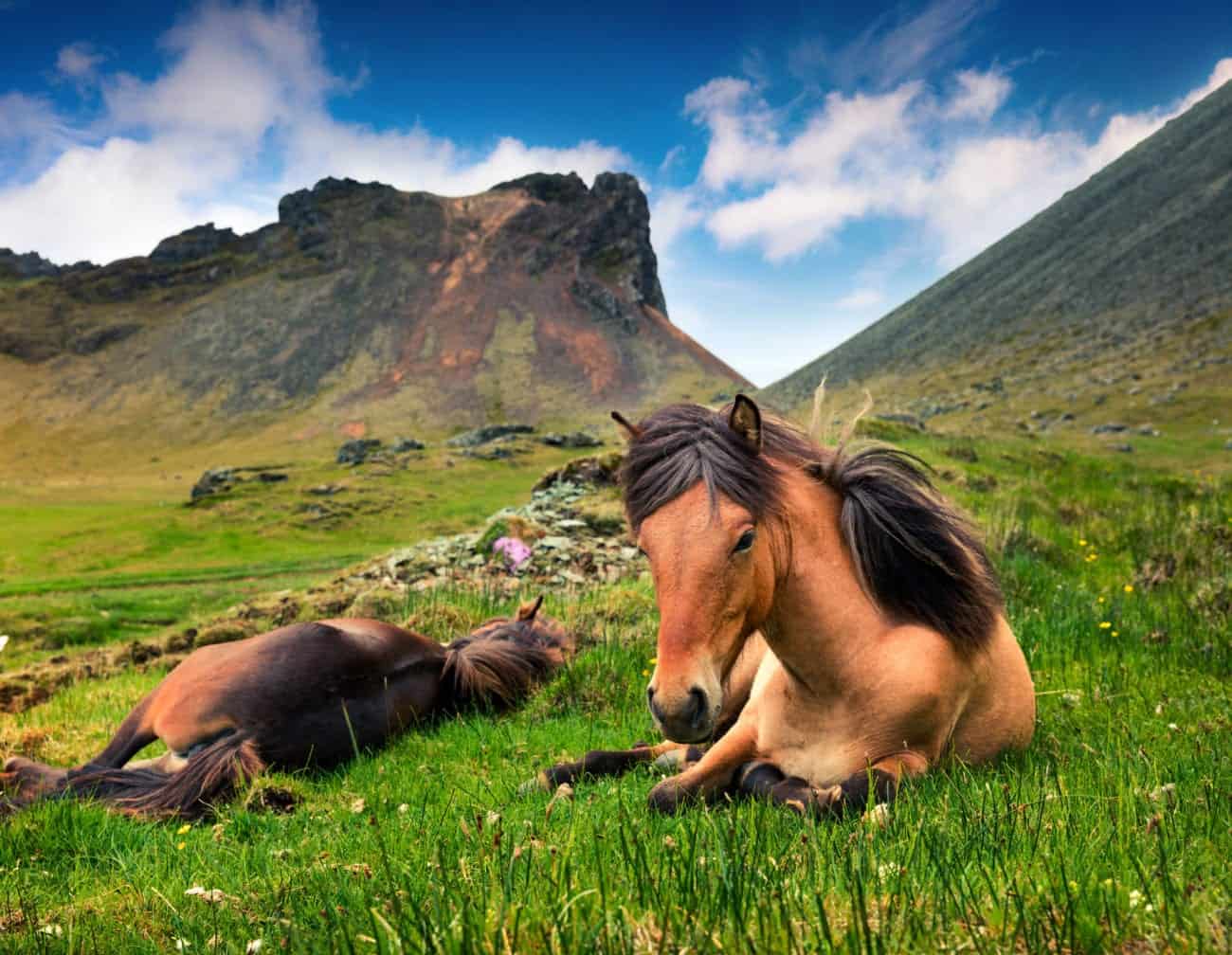
Hunvatnssysla is another must-mention. The region offers fantastic opportunities for horseback riding, seal spotting tours and a visit to the magical Hvitserkur rhino/dinosaur cliff. This is one of those places in Iceland where you almost can’t believe it is not man-made. But fear not, there is a perfectly logical geological explanation behind the whole thing. However, eerie folklore tales do surround the place.
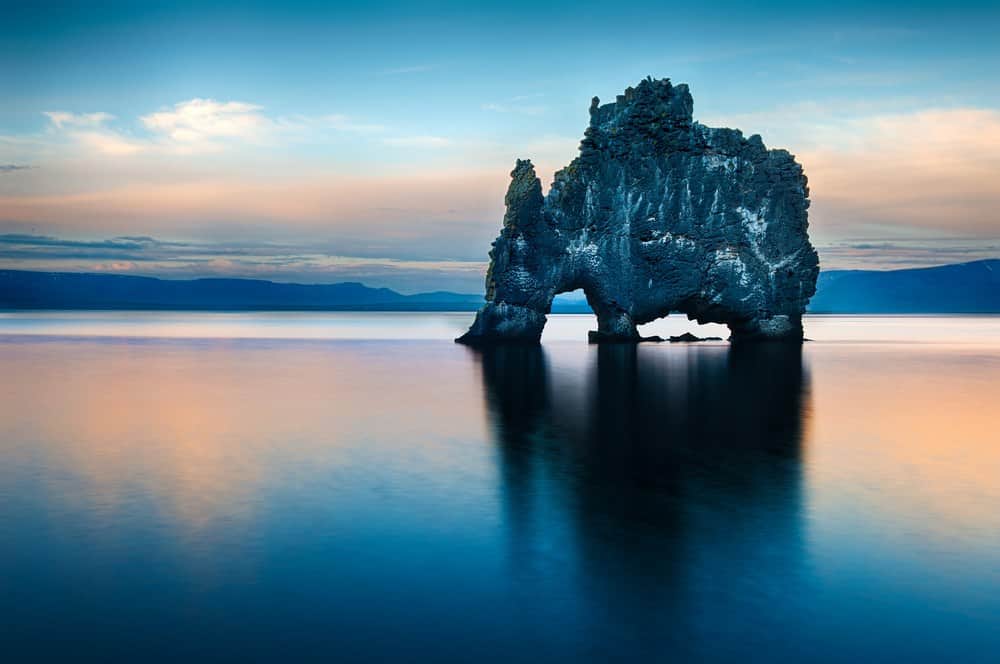
Things to do in North Iceland
- Go Whale Watching
- Drive the Arctic Coast Way Rout
- Take a ferry to the remote Grímsey
- Taste a hot dog with fries
- Try a full-throttle white water rafting tour
- Go bathing in a beer bath
- Drive the Diamond Circle
- Bath in natural hot springs and spas
The Midnight Sun is an extraordinary spectacle in these northern latitudes in summer. However, during the Northern Lights season, the magnificent vistas are made even more theatrical by the glow of Aurora Borealis. They say the farther north you go the better the lights are, so going to the northern parts of the already north Atlantic island of Iceland must be close to perfect!
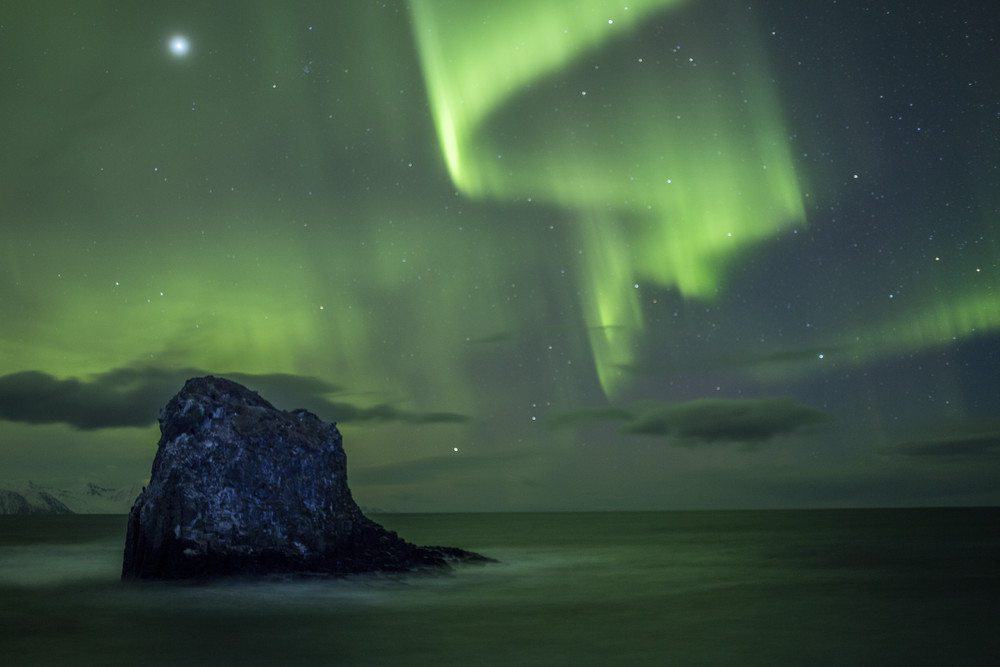
One of the more popular road trips to do around Iceland is the Arctic Coast Way . Which brings you a carefully chosen map to the best of the North of Iceland. The trip leaves no place highlight unvisited with additional historic and natural beauties to decorate the itinerary. The trip can be done as an add-on to the Ring Road or on its own as you can fly to both Akureyri and Egilsstaðir að pick up a rental from there!
Things to do in Northwest Iceland
Seasonal delights include golf under the Midnight Sun at the world’s northernmost 18-hole course in Akureyri, taking to the slopes at one of eight skiing areas, snowmobiling, horse trekking, super-jeep excursions, white-water rafting and hiking on along the rugged coastline.
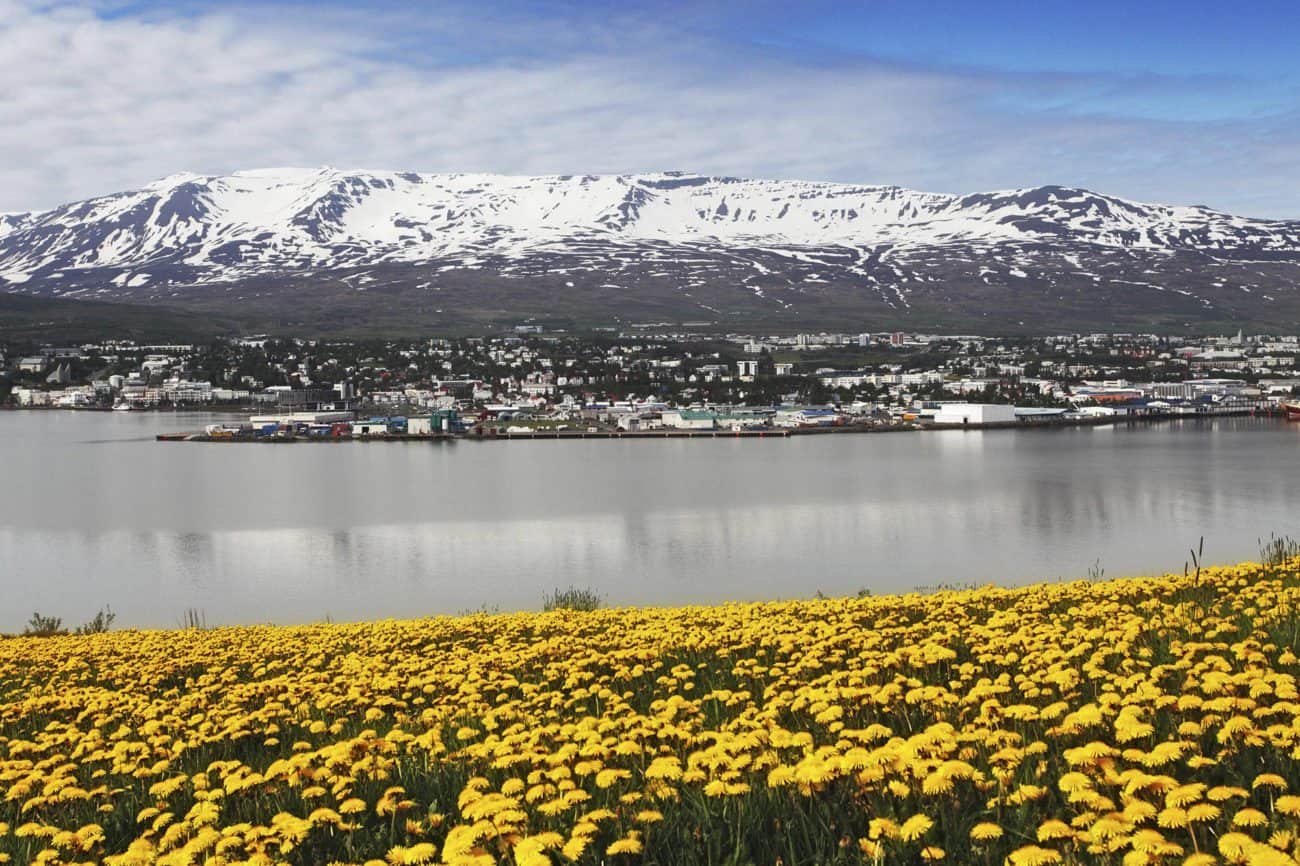
Akureyri has often nicknamed the capital of the North and is a busy little haven, with an amazing blend of culture, local charm and stunning sights. The local dish is a hot dog loaded with fries and melted cheese. Try if you dare, it is hard to stop!
From Akureyri, you can also take the ferry out to the beautiful Grimsey island, located right on the Arctic Circle. The island is famous for its small population which is many times over outnumbered by puffins and other cute wildlife.
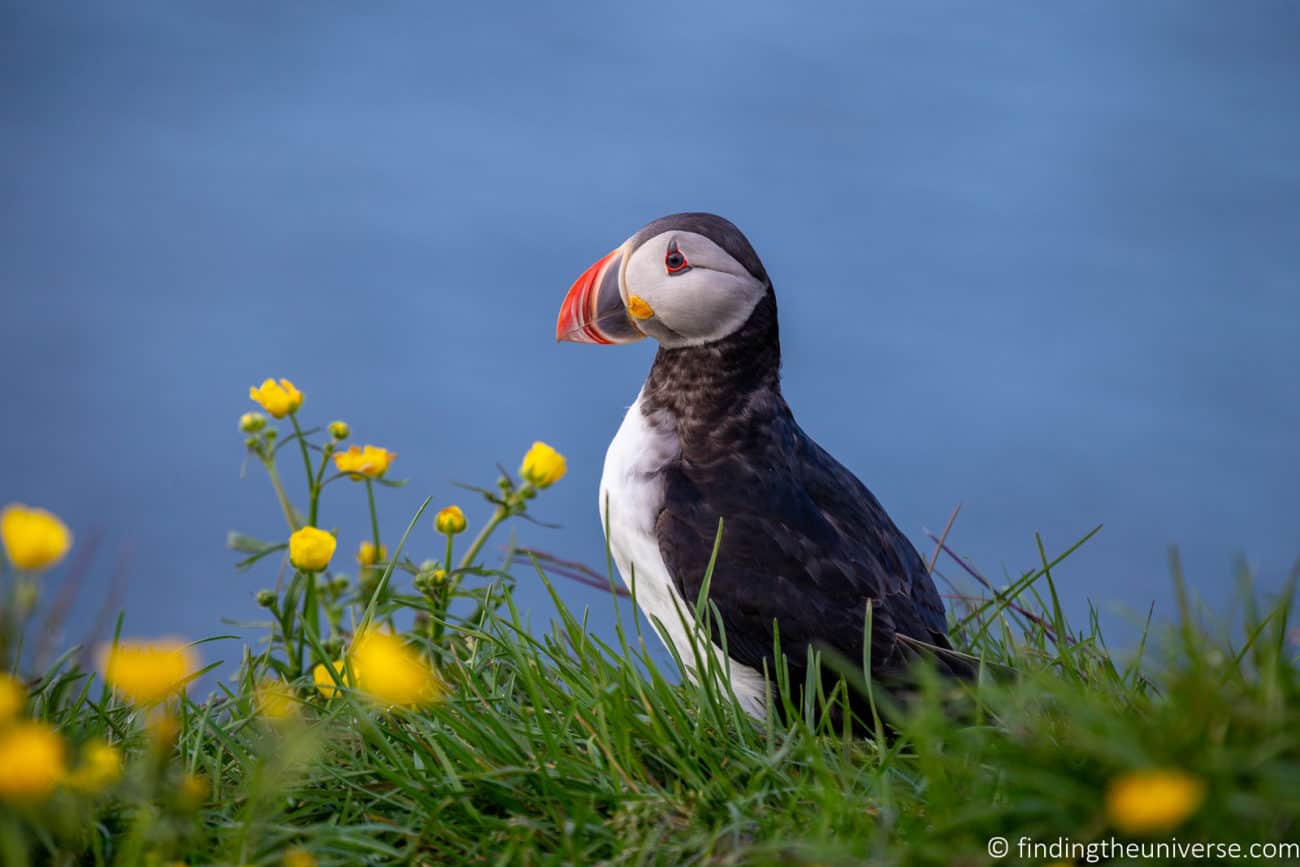
In June 2017, the first beer spa in Iceland was opened in the nearby village of Dalvik, where people can cleanse their skin by lying in a tub filled with beer, water, hops and yeast. Dalvik is yet another great spot for whale watching but together with Husavik and Akureyri the three are absolute whale watching winners. Additionally, the record sighting is held in Dalvik with over nine different whale species seen in one trip!
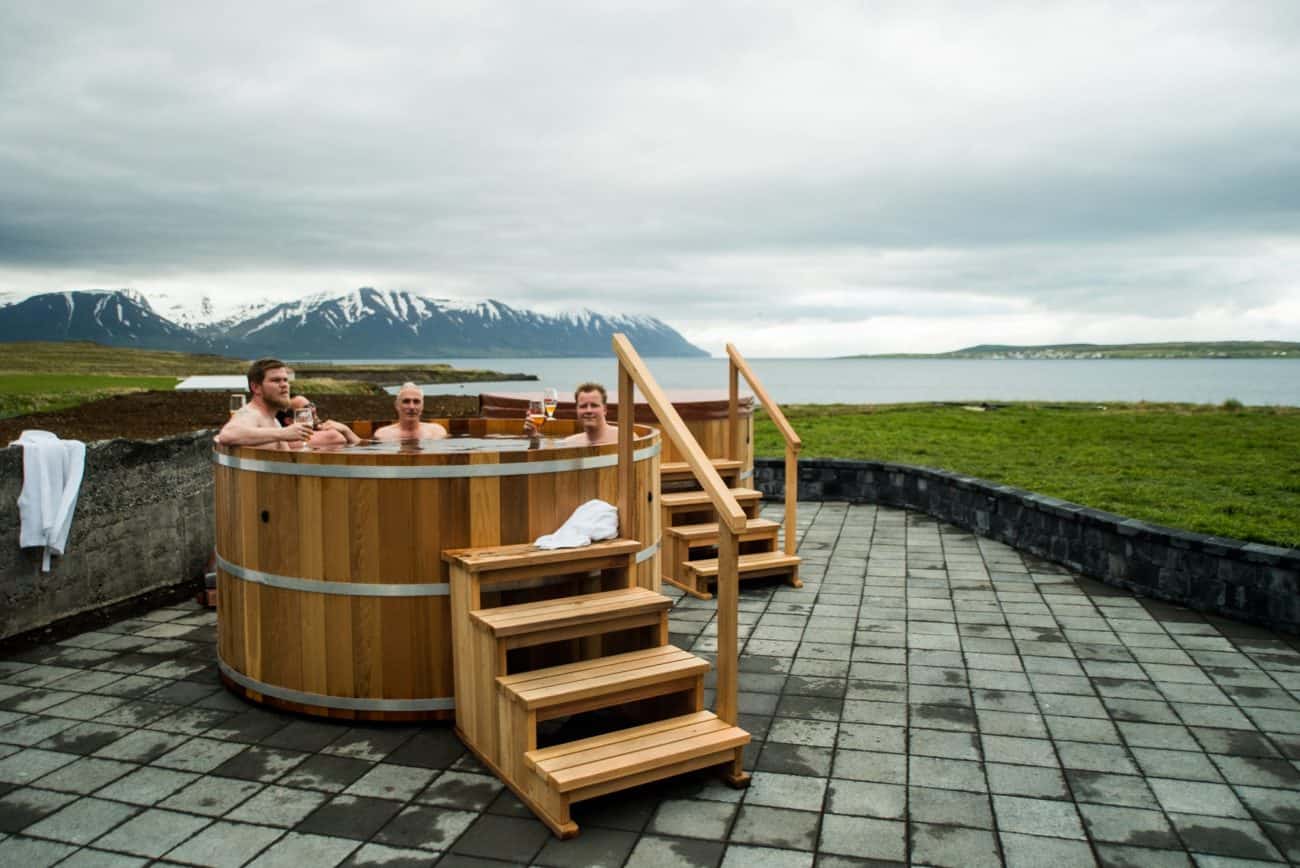
In Skagafjordur, previously mentioned as the bay of horses you can also find adventurous tours such as the wildest white water rafting tour in Europe!
Things to do in North East Iceland
The Diamond Circle is the Northern version of the Golden Circle and includes some of the most stellar sights in the North. Its key destinations are Asbyrgi, Godafoss waterfall, Myvatn and Husavik. So, for anyone looking to get the best of the Northeast in one day, this is surely the way to go!
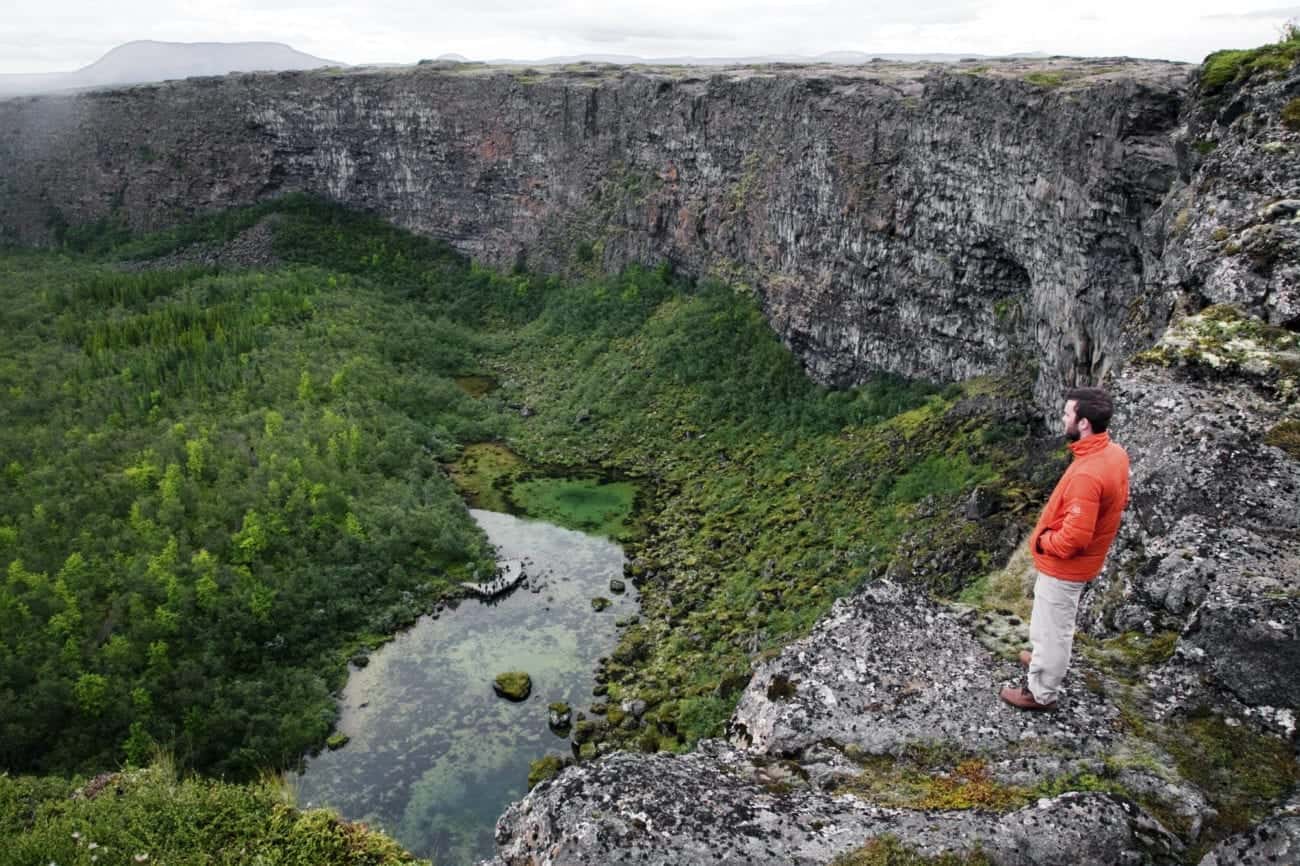
Asbyrgi is a grand horseshoe-shaped canyon filled with small springs and birch trees. Seemingly like a scene from Lord of the Rings. Once you walk around it you will know what we mean.
Godafoss is yet another delight, falling beautifully in almost the same shape as Asbyrgi. Myvatn is of course a given on the list with its many attractions and incredible sights. And, we must mention Husavik with its homey feel, great restaurants, swimming pools, hot springs and whale watching adventures!
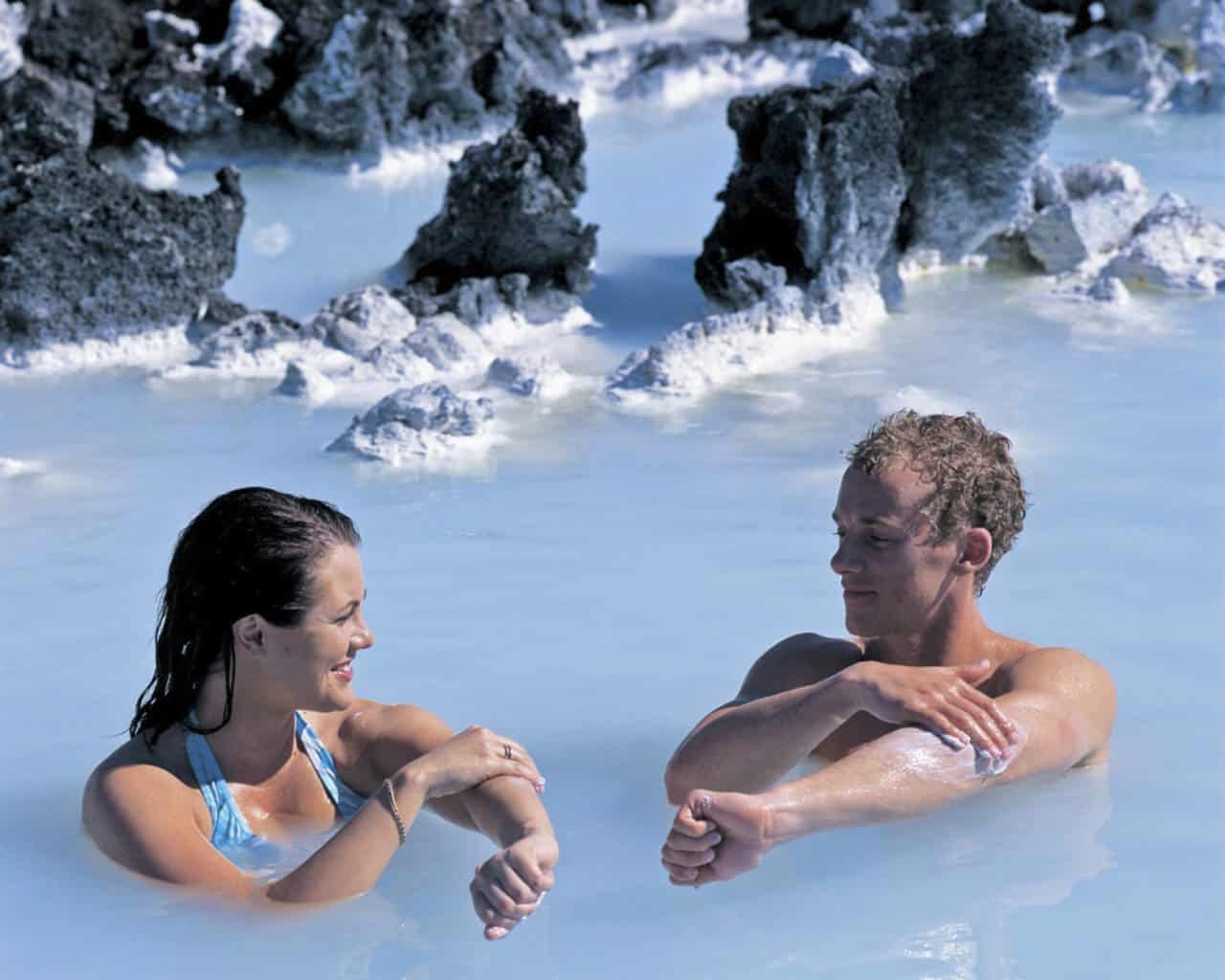
For more detailed information about attractions, villages and activities in north Iceland be sure to go through our destination guide.
Photo Gallery
Iceland is open for travel. Check volcano updates here .

- 10 Things to Do in North Iceland
10 THINGS TO DO IN NORTH ICELAND
Related Tours
Related blogs.
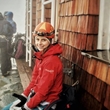
Already soaked in the Blue Lagoon and drove through the South Coast? Go North! North Iceland is charming, unique and filled with fascinating attractions and wildlife.
Already soaked in the Blue Lagoon and drove through the South Coast ? Go North! North Iceland is charming, unique and filled with fascinating attractions and wildlife. Get inspired, create your own Northern Iceland itinerary and have the adventure of a lifetime.
Here’s a list of the best things to do in North Iceland :
1. Visit the Arctic Henge
The Arctic Henge is an enormous stone sculpture in the northeastern village Raufarhöfn . It’s currently under construction and is intended to be a symbol of Nordic paganism in Iceland.
The Arctic Henge project started in 1996. Essentially it’s a sundial, which will capture the midnight sun perfectly in the aligned gateways.
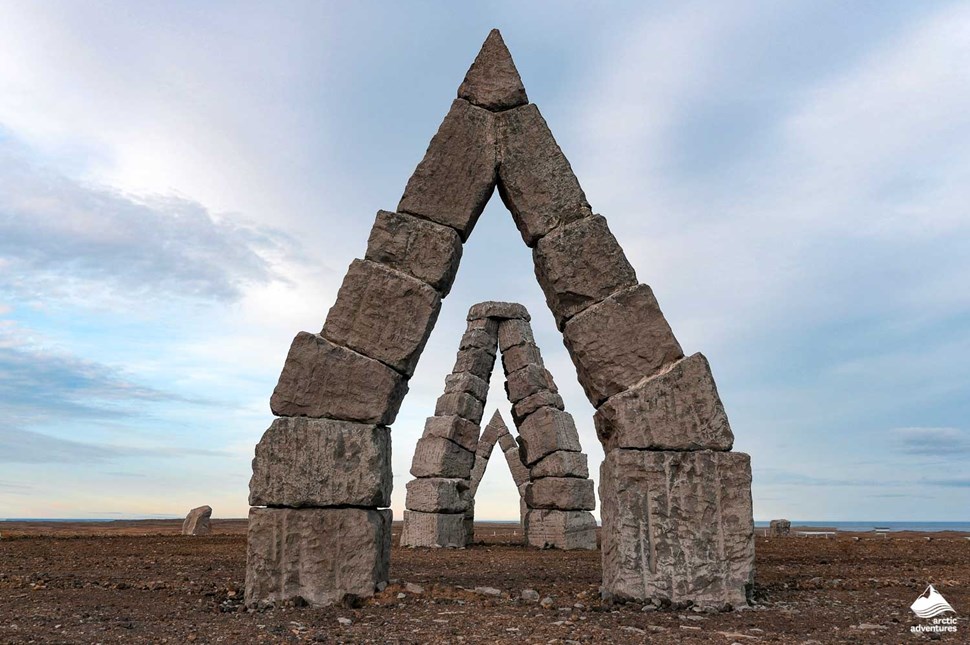
Heimskautsgerðið (The Arctic Henge) was inspired by the old Eddic poem Völuspá (Prophecy of the Seeress). The 72 small blocks of rock, each inscribed with their own dwarven name, represent the 72 weeks of the year. The rocks circle 4 bigger stone monuments, formed as an arch, which then circle one massive basalt column.
You can enjoy some solitude at the Arctic Henge as it is yet to be discovered by the masses.

The mystical arctic henge in Raufarhofn in Iceland
How to get to the Arctic Henge?
Take Road 85 (Hófaskarðsleið) from the northern part of the Ring Road, then take Nordausturvegur Road and drive further up north. After 13mi (21 km) you should reach Raufarhöfn .
When can I go to Arctic Henge?
All year round. If you’re going there in the winter, beware of the road closures and weather conditions.
2. Explore Askja Area
For lunar-like landscapes and solitude, head to Askja . Located in the northern Icelandic Highlands, Askja is a volcanic caldera with three geothermal crater lakes: Askja Lake, Öskjuvatn Lake , and Viti Volcano Lake . It’s a breathtaking area, dwarfed by the high peaks of Dyngjufjoll (Dragon) Mountains and dotted with turquoise lakes.
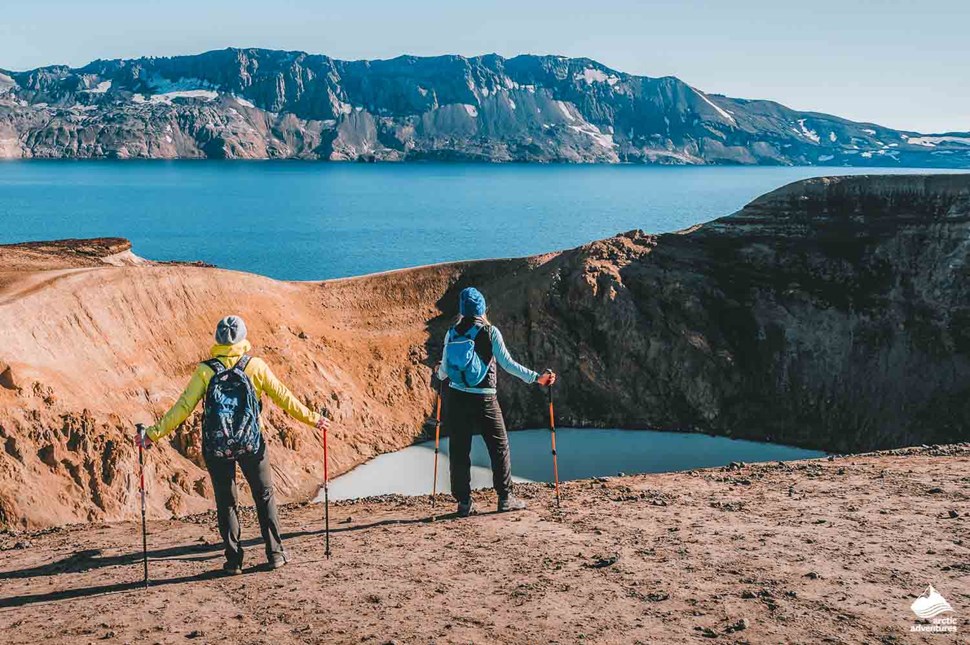
Hikers looking at Geothermal crater lake near the Askja volcano
Due to its otherworldly scenery, the Askja area was one of the main sites NASA used to train pilots before the Apollo 11 mission in 1969.
When can I go to Askja?
Due to unpredictable Icelandic weather, the Askja area is mostly accessible during the summer months. Before heading to bathe in Viti Lake, visit the visitor center.

Oskjuvatn lake at Askja, Iceland

How to get to Askja?
To get to Askja, you’ll need a proper 4×4 vehicle. Make sure your 4WD will be able to cross at least two rivers. The easiest way to get to Askja Lake is by driving the Ring Road past Akureyri and Myvatn . Get off the Ring Road onto Road 901 and turn right onto the F910. Drive for approximately 13 mi (21 km), take Road F910 and drive further for 38 mi (62 km). At the end of the road, you will see the visitor center and campsites.
3. Soak in Beer Spa
Soak in a warm beer bath – a unique experience that pretty much sums up the Icelandic way of living. Located not far from Dalvik, Bjorbodin Beer Spa combines young beer body treatment with a relaxing soak. The beer in the tub is undrinkable so there’s no age limit. Next to the tub you’ll find a draft with Icelanders’ favorite beer, Kaldi.

Beer bathtubs are made of Kambala wood and filled with young beer, water, hops, live beer yeast, beer oil, beer, salt, and water. The contents of the bath are high in potassium, protein, iron, magnesium, and zink, which will revitalize your skin and hair. Note, it’s recommended not to shower for at least 4 hours after the soak.
When can I go to the beer spa?
North Iceland’s Beer Spa is one of the best Northern Iceland attractions and is available all year round.

How to get to Bjorbodin Beer Spa?
The Beer Spa is located in Árskógssandur , a small community on the shores of Eyjafjörður Fiord between Dalvik and Akureyri . You can get there by taking Road 82 on the northern part of the Ring Road. Head North for about 14 mi (24 km).
4. Feel the magic of Myvatn Area
Myvatn combines all the natural wonders that Iceland has to offer. Deserted craters, hot spring caves, and lofty lava formations are just a few highlights found in this microcosm.

The crown jewel of the area is Lake Myvatn . This shallow lake is surrounded by high geothermal activity. Nestled among towering lava formations, the lake is the North’s answer to the Blue Lagoon. While you’re there, visit Hverir Geothermal Area and watch the ground melt away into hot mud puddles or feel the strength of Dettifoss , Europe’s second most powerful waterfall.
Cap your day off with a hike up the Hverfell Crater Mountain , a tuff ring volcano, or Skutustadagigar Pseudocraters , a conservation area to the south of Lake Myvatn.
When can I go to Lake Myvatn?
The area around Lake Myvatn is open all year round. However, due to adverse winter conditions, some roads might be closed.
How to get to Lake Myvatn?
Lake Myvatn is located next to Reykjahlid , which is right on the Ring Road .
5. Voyage to Grimsey Island
If you’re looking to tick the Arctic Circle off your bucket list, then a voyage to Grimsey is perfect! Grimsey Island is located 25 mi (40 km) off the northern shores of Iceland and straddles the Arctic Circle.
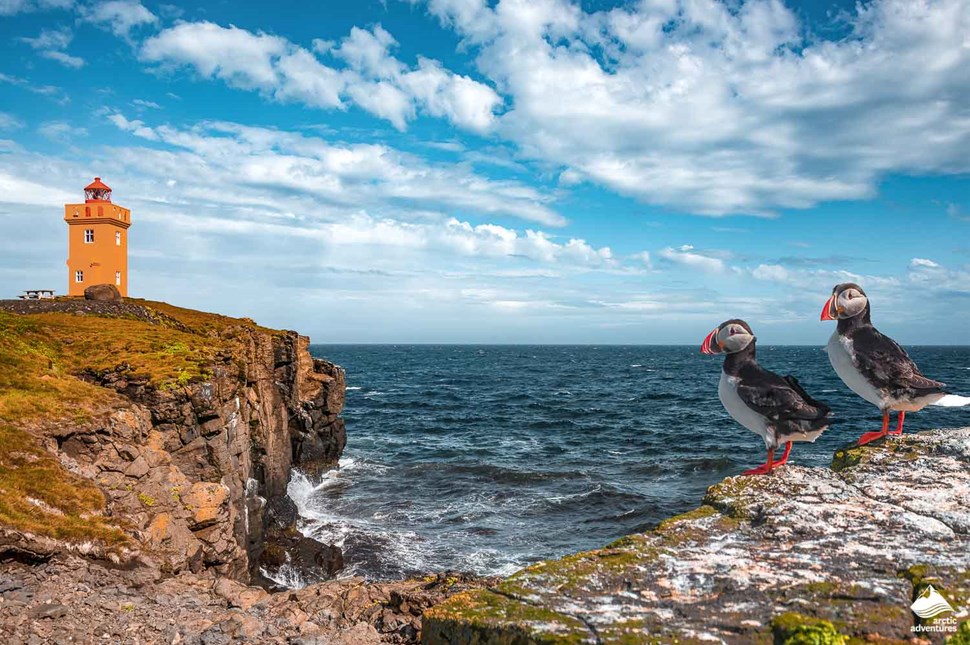
North Atlantic puffins sitting in front of orange lighthouse in Iceland
Home to more birds than people, Grimsey Island has a lot more to offer than just the Arctic Circle crossing. During summer, the Midnight Sun creates the perfect backdrop for nature and wildlife photography. While in the winter, the sky is colored with dancing flares from the Northern Lights . Grimsey is one of the top destinations to watch the Northern Lights.
Here you can also visit an 800-year-old church, try local cuisine, go for a swim in a newly built pool and visit the all-in-one school, library, and community center.

Lonely church and puffins at the cost of Grimsey island
A great variety of birds call Grimsey their home. Nearly all main birds that visit Iceland during the year can be found on the island. Some of the most popular ones include black-legged kittiwake, northern fulmar, Atlantic puffin, razorbill, and the black guillemot. Grimsey has one of the biggest tern nesting sites and one of the largest puffin colonies in Iceland.
When can I go to Grimsey Island?
All year round. The guesthouse on the island is open throughout the year so you can visit anytime you want. Keep in mind though, Grimsey is a remote island with a northern climate so be prepared if you decide to go there during the winter.
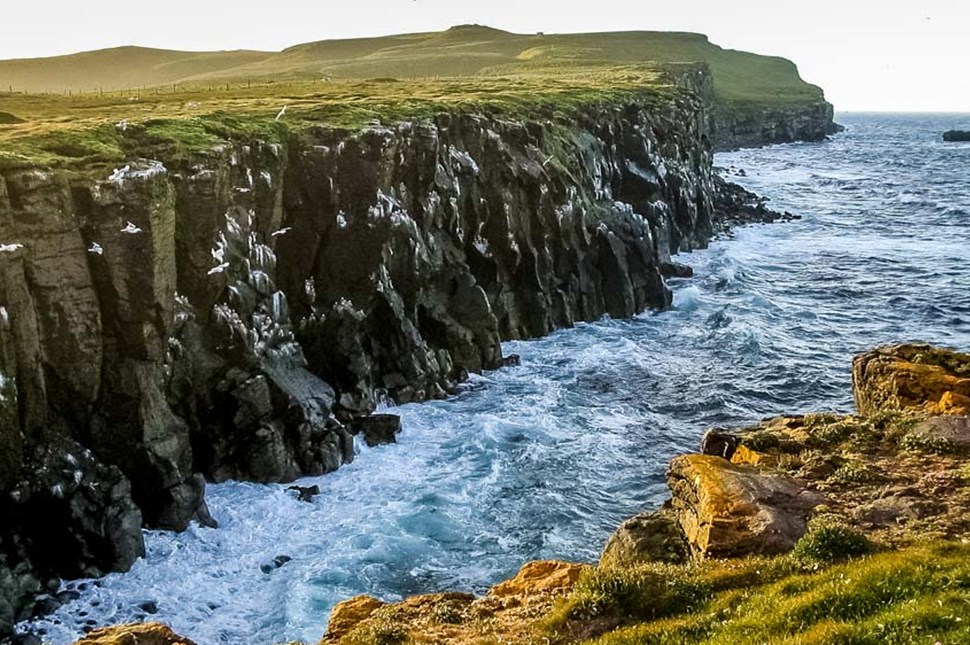
How to get to Grimsey Island?
Take a ferry from Dalvik or a plane from Akureyri . The ferry to Grimsey Island leaves three times a week all year round and flights from Akureyri are scheduled three times a week during winter and seven times a week during the summer.
6. Whale watching in Dalvik
An authentic fishing village, Dalvik is Iceland’s whale watching capital. The village is located in Trollaskagi Peninsula , right on the shores of the North Atlantic Ocean which is home to a variety of whales during the summer. Hop on a boat and sail out into the ocean in search of these gentle giants on our whale watching tour from Dalvik . Our guides are experts in seeking out whale hiding spots with a 98% success rate.

Iceland, Dalvik – watching crazy humpback whale
Besides whale watching, Dalvik is full of things to do for every adventurous soul. For one, this fishing village is home to the best alpine skiing in Iceland. Also, a great variety of hiking trails with views of the Trollaskagi Peninsula are available to you.
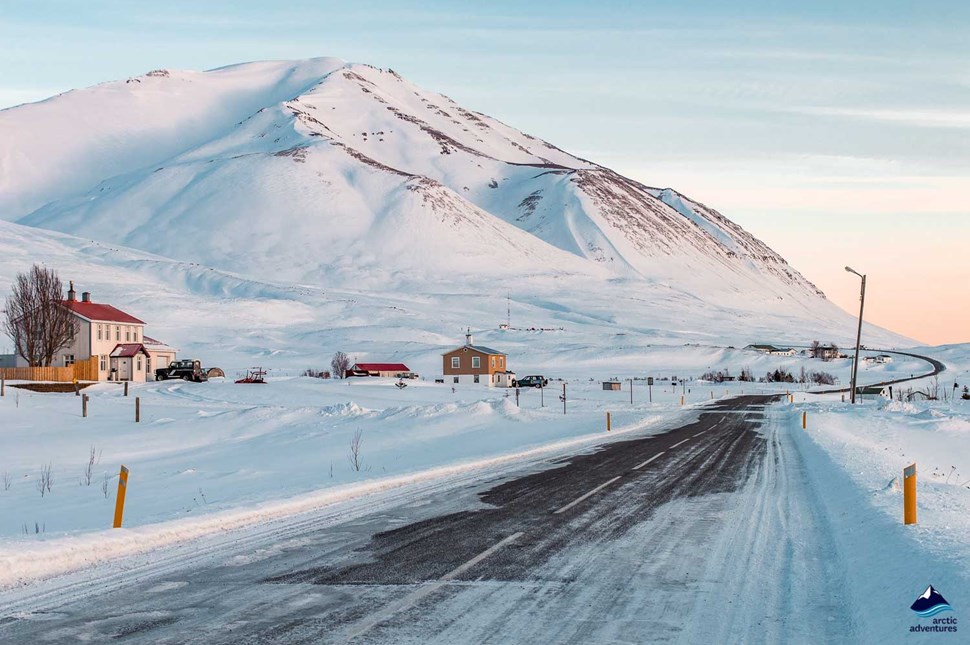
When can I go whale watching in Dalvik?
The biggest success rate of whale sightings in Dalvik is during the summer months.
How can I get to Dalvik?
Take Road 82 off the Northern part of the Ring Road and drive for approximately 20 mi (33 km). If whale watching is a must, check the 5-Day North and West Iceland Tour which combines the best activities within these areas. A multi-day tour organises all the accommodation and transport, so you can sit back and enjoy the journey to your next activity.
7. A self-drive tour of the Arctic Coast Way
Looking for a true taste of Iceland? Go off the beaten path and discover Iceland’s hidden gems on a self-drive adventure of the Arctic Coast Way . The road takes you through 18 geothermal pools , 16 charming fishing villages , 6 islands , and many attractions unique to North Iceland. Visit the most remote areas in Northern Iceland and seek out wildlife that call the Arctic their home.
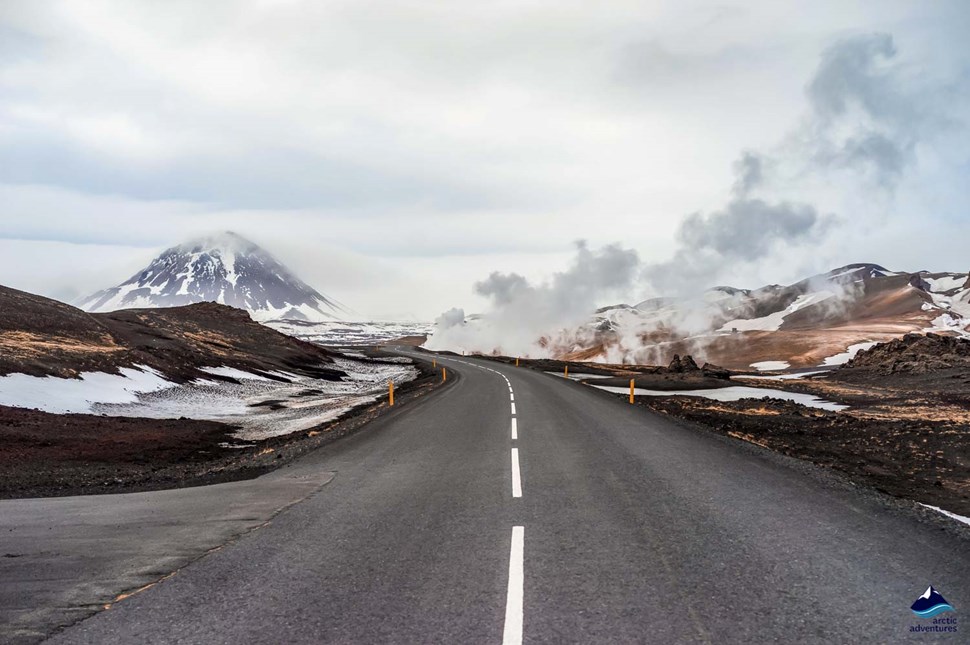
The Arctic Coast Way is around 560-mi (900-km) long and can be driven in winter and summer. Both seasons will grant you with seasonal and unique Iceland adventures. During the summer, you will be rewarded with 24 hour days as the Midnight Sun never sets. During the winter, you’ll be able to watch Northern Lights dance across the Arctic sky form the best locations in the world.
Book our self-drive Arctic Coast tour and see the best that Northern Iceland has to offer.
When can I drive the Arctic Coastway?
All year round. However, keep in mind that winter in North Iceland can be harsh and it might take you longer than usual to reach certain sites.
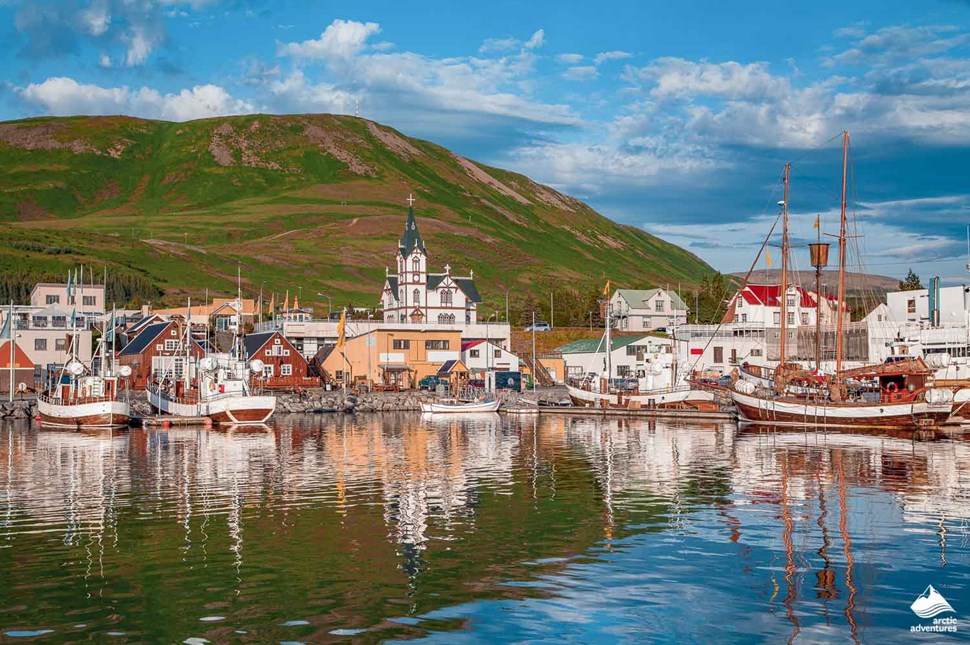
Scenic view of the historic town of Husavik
How to get to the Arctic Coastway?
If you choose to start your journey from the West – Hvammstangi is your starting point. If you choose to experience the Arctic Coastway from the East, Bakkafjordur is your starting point.
8. Experience the Power of Dettifoss
Every waterfall hunter should add Dettifoss to their list, it’s a must-see in North Iceland. Dettifoss, the second most powerful waterfall in Europe is known for its size rather than beauty. The waterfall is 330 ft (100 m) wide and drops a whopping 144 ft (44 m). The sheer size of it is what will leave you stunned. Surprisingly, for such a vast waterfall, you won’t hear the cascading water until you get really close to it.
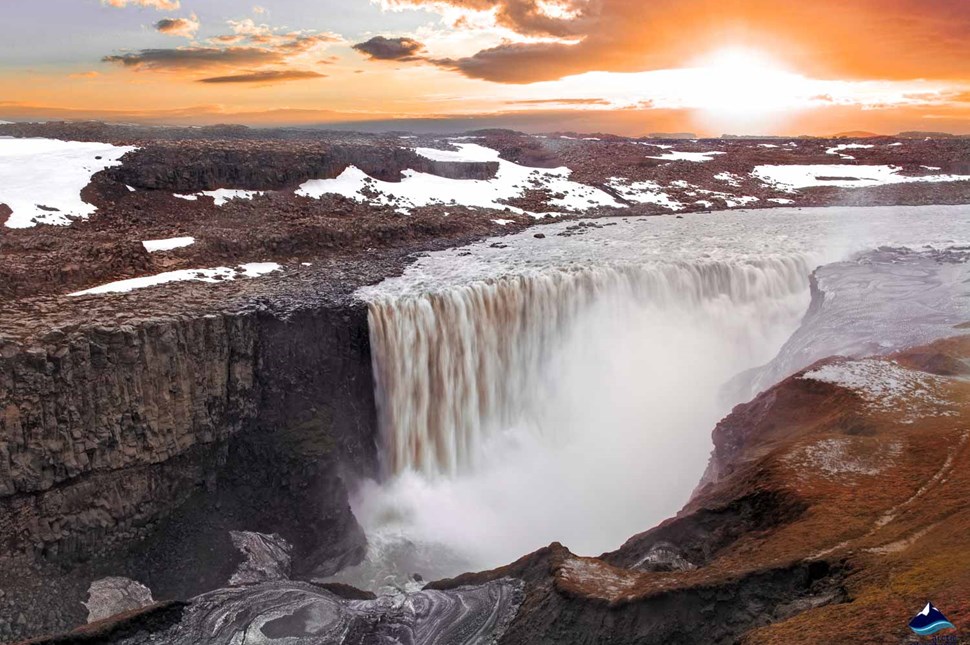
Iceland waterfall – Dettifoss
To explore the waterfall will take you around 2 to 3 hours. Once you’re done, go on a 21-mi (34-km) long hiking trail. The trail will take you above and around the waterfall, and straight into Asbyrgi Canyon where you can further enjoy the Icelandic landscape.
When can I visit Dettifoss?
It’s best to visit the waterfall during the summer. In summer months, the waterfall is at its mightiest, rewarding you with the water show of a lifetime. During winter, you’ll have very little daylight and slippery approach to the waterfall, which can be dangerous.
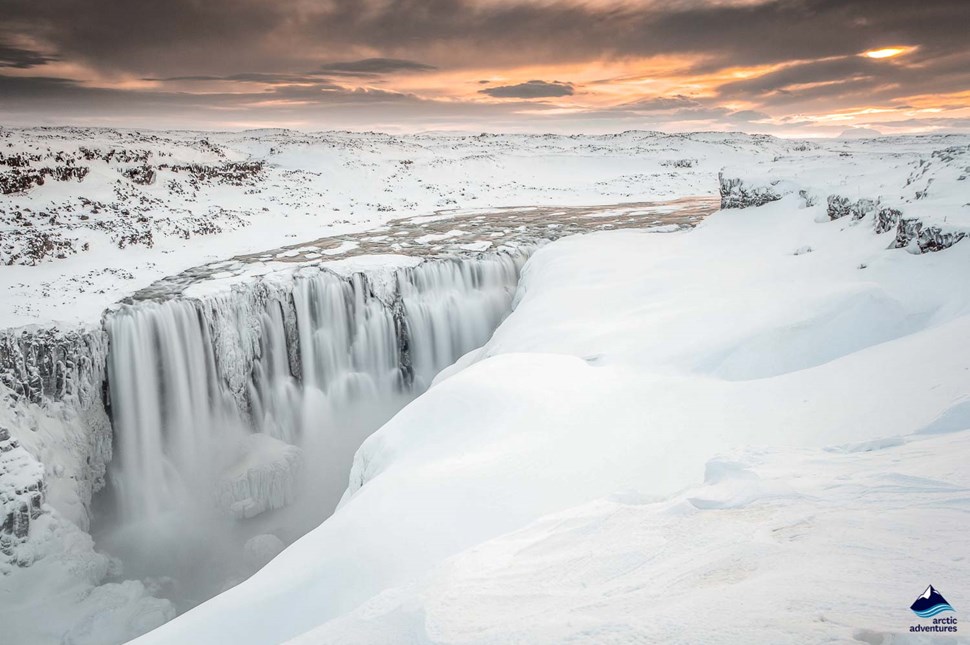
How to get to Dettifoss?
Turn onto Road 864 from the northern part of the Ring Road and head North for about 19 mi (32 km).
9. Find the oldest turf church, Grafarkirkja
Grafarkirkja, the oldest church in Iceland, is located on the western shore of the Trollaskagi Peninsula . Built in the 17th century the church is also one of the very few in Iceland that has been embellished. It is said that a carver by the name of Guðmundur Guðmundsson built the church on the remains of an even older church.

Grafarkirkja, the oldest church in Iceland
The church was deconsecrated not long after Guðmundur built it and used as a tool shed for quite some time. Surprisingly, the turf oratory remained in good condition and was easy to renovate for the National Museum of Iceland in the 1950s.
When can I visit Grafarkirkja Church?
All year round. As with other attractions in the North, it’s possible that you won’t be able to access the church due to adverse weather conditions during the winter months.
How can I get to the church?
Take road 76 just off the northern part of the Ring Road and head towards the small town of Hofsos .
10. Visit Hvitserkur Sea Stack
Looking for what to see in North Iceland? A truly unique attraction in North Iceland is the Hvitserkur Sea Stack . The sea stack is located off the shores of the Vatnsnes Peninsula and is 49 ft (15 m) high. The monolith formation looks like an elephant or a dragon drinking water and is home to a variety of seabirds.
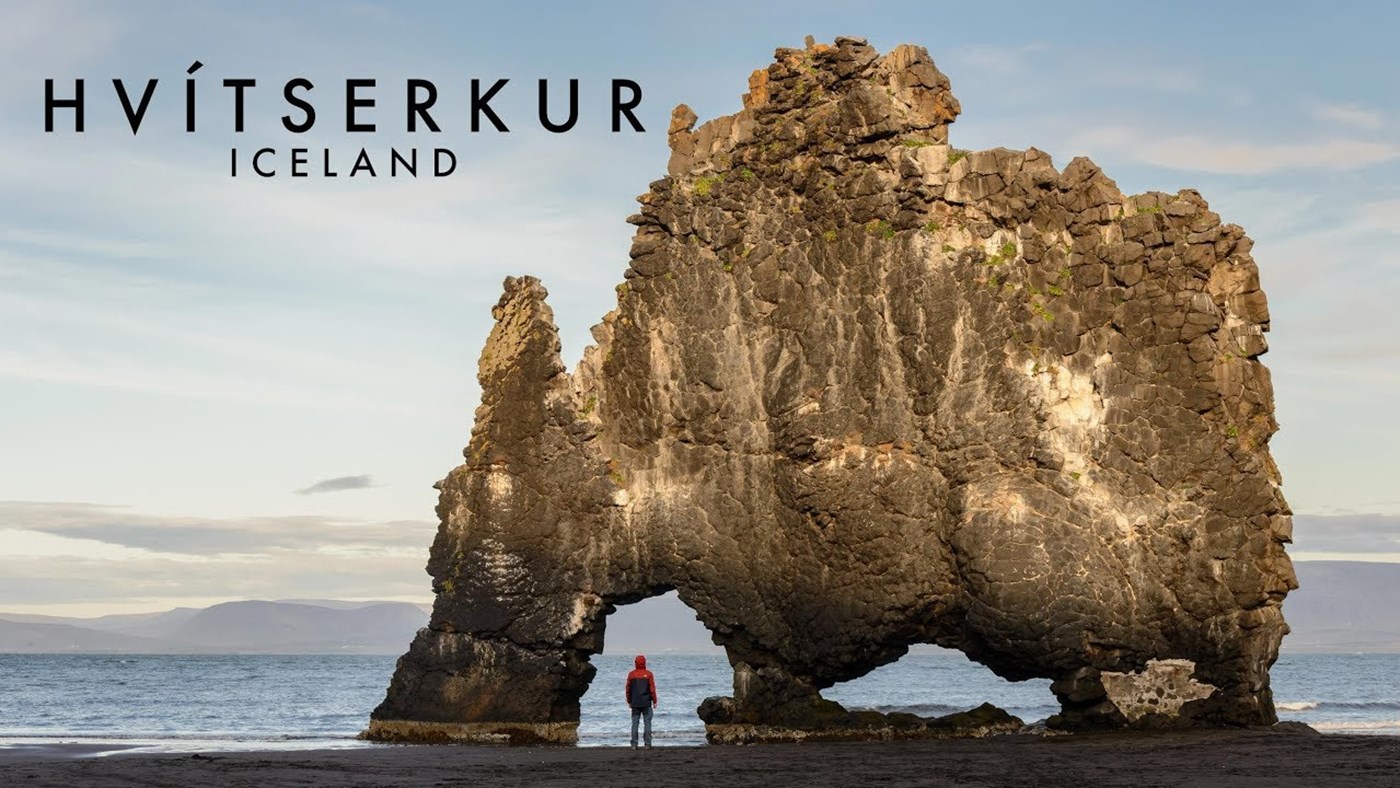
Top places of Iceland – Hvítserkur
Legend has it that the sea stack was once a scarred troll, who was on his way to Þingeyraklaustur Convent from Strandir. Iceland’s trolls are not Christian, so Hvitserkur was on a mission to tear down the bells of the convent. He wasn’t fast enough and as the sun was rising, he turned into this charming monolith stack.
The sea stack was getting worn with each wave of the North Atlantic Ocean and would’ve collapsed soon. Locals of the area wanted to save Hvitserkur so they all pitched in and got the base of the stack reinforced with concrete.

When can I see Hvitserkur Sea Stack?
All year round. In winter, beware of the possible road closures.
How to get to the Hvitserkur Sea Stack?
Take Road 711 from the northern part of the Ring Road and drive North for around 18 mi (30 km).
Fallen in love with North Iceland? Book our 11-Day Self-Drive Tour on Iceland’s Arctic Coastway and do all the things in North Iceland listed above! Or if you're a little more limited on time, see where our day tours could take you.
Best Seller

6 Days Around Iceland Adventure
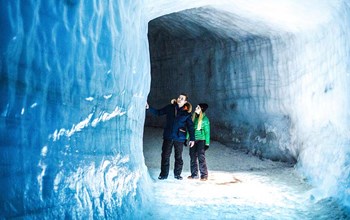
Ice Cave & Northern Lights Tour

2-Day Tour to Snæfellsnes Peninsula & Borgarfjörður Fjord

Iceland in May
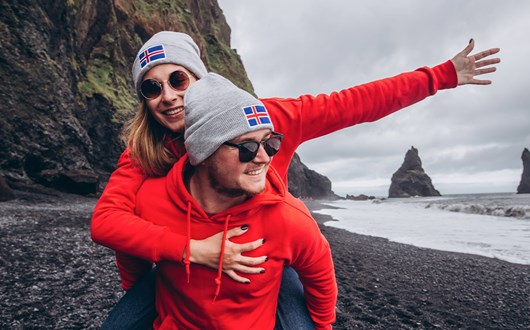
The First Day of Summer in Iceland
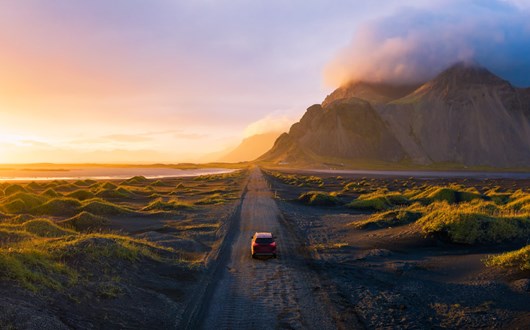
Iceland in April
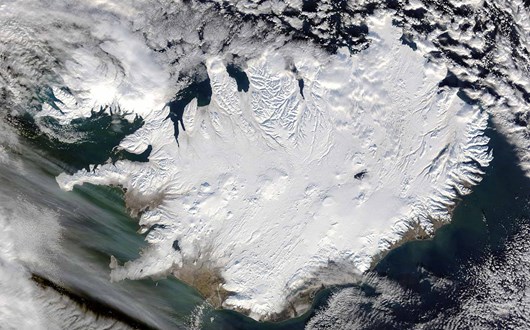
What to Wear in Iceland
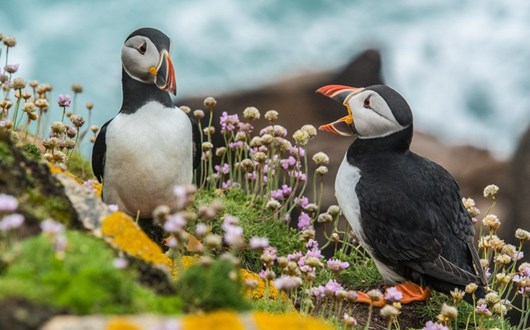
Puffins in Iceland - Everything You Need to Know
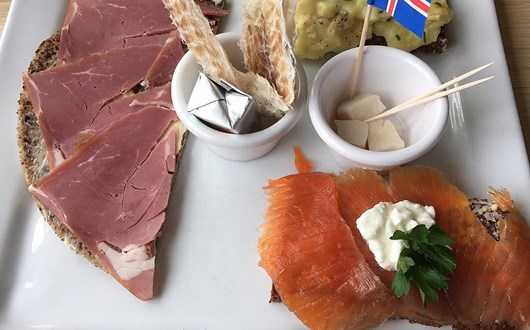
Icelandic food

Northern Lights Explorer

Whale Watching From Dalvik

Askja Caldera & Holuhraun Lava Field

Godafoss, Mývatn and Askja Volcano Tour
The North of Iceland is a whole new planet to discover. The Volcanic activity, the colorful mountains, and dramatic mountains make the most beautiful landscapes which Kay visited on the Goðafoss, Mývatn and Askja Volcano tour. Here she tell...
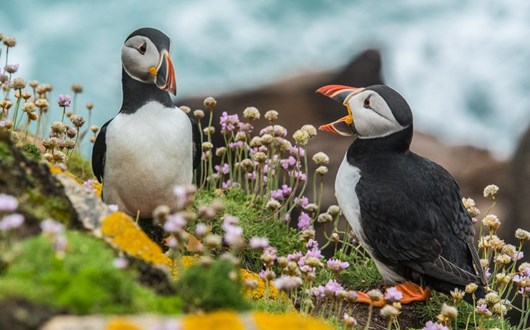
Iceland is the puffin watching capital of the world. Bird watchers and scientists from all over the globe come to Iceland to see this interesting species for themselves. Thanks to their incredibly cute and funny appearance, puffin watching ...
Share our passion for Iceland, get top travel stories & special offers to your inbox
The Traveler’s Guide to North Iceland – Weather, Landscape, and Things to do
- Last Updated: March 14, 2024
- Viktória Komjáti
Most Iceland visitors tour Reykjavík, the Golden Circle , and the country’s famed South Coast , then leave again. They’ll have a wonderful time, to be sure, but are also missing out. A stone’s throw from the Arctic Circle, North Iceland offers a remote grandeur that makes it well worth feeling like you’re at the edge of the world. Epic snow-capped peaks, lush pastures lining fjords, dramatic waterfalls and canyons, exciting volcanic history, and waters alive with dolphins, seals, and whales are yours to discover if you travel just a little further.
North Iceland’s capital is Akureyri, a delightful little city once deemed “ The Best Place to Visit in Europe ” by Lonely Planet. But most of the region is sparsely populated by around 40,000 people and many more sheep and horses.
Guided Tours
Infrastructure and road conditions, north iceland weather, geology and landscape, kayaking and sailing, whale watching, skiing, ski touring, and heli-skiing.
Read on to find out how the weather of North Iceland differs from that in the south, about the geology that formed its unique landscape, and what are the best things to do in the region. In a separate article, we’ve listed the 20 most exciting attractions you shouldn’t miss out on when visiting North Iceland .

How to Get About
Nordurland, as the area is known in Icelandic, is easily reached from Reykjavík via just one road: the Ring Road, which circles the country. Reykjavík to Akureyri is a trip of around five hours if you drive non-stop, but as you’ll certainly want to pull over frequently for photos, it’s best to plan a whole day for the journey. The route to North Iceland is lined throughout by glories and attractions you can’t possibly ignore.
You’ll need at the very least three days to feel like you’ve discovered most North Iceland has to offer. For those wanting to spend less time in a car and more time exploring, it’s best to plan for four to five days. Whether you hire a campervan, car, or motorhome or take a multi-day guided tour, you’ll make the most of being in this glorious region.
As buses to Akureyri run just once a day and don’t make stops at the natural attractions, public transport isn’t an option. So group tours with a guide are a great choice if you don’t want to drive. These tours aren’t much more expensive than traveling by public transport, with the bonuses of more stops accompanied by invaluable information delivered in English. Another great advantage of guided multiday tours is that accommodation and meals are included, simplifying your planning and removing the hassle and uncertainties of booking accommodation.

Tours to North Iceland depart from Reykjavík and last a minimum of three days. Or, if you prefer, you can join an “ around Iceland ” tour of the entire island lasting anywhere from six to twenty days. When deciding on the length, bear in mind that the longer tours provide an opportunity to capture both sweeping and intimate pictures of it all.
There are also many shorter guided activity tours you can book after you arrive. You can try exciting physical activities like Superjeep tours or horseback riding. Incredible whale-watching tours depart regularly from Akureyri, Dalvik, and Húsavík. Being the largest northern city, Akureyri offers many day tours, as well as multi-day trekking tours into the stunning Highlands area. Guesthouses, tourist information centers, and most other tourism facilities can offer detailed information to help you choose.
Self-Drive Tours
If guided tours aren’t your thing, you can, of course, plan your trip, requiring you to rent and drive your vehicle and journey around the North Iceland region without direct assistance. This takes some planning but is entirely doable. Remember to include a minimum of three to four days just to travel from Reykjavík to North Iceland and return, and plan for as many more days as you can spare in North Iceland for the most memorable experience possible.

We can make it easier for you here and create your custom self-drive itinerary, including accommodation and activity bookings and anything you need for a perfect plan! If you need our help, don’t hesitate to contact us!
The sparse population of North Iceland, mostly in small villages, of course, means there can be somewhat limited options when it comes to food shopping or eating out. Akureyri is the country’s second-largest city; however, it has a vibrant variety of city activities, cafés and restaurants, food, and other shopping, all with that unique Icelandic style and vibe.
Of the larger towns in the region, Dalvík, Húsavík, Siglufjörður, and Varmahlíð are the best known. They do contain some lovely places to eat, shop, and stay. But consider that options for countryside accommodation and shopping are more limited than those in the cities, so it’s advisable to plan and book ahead of time.
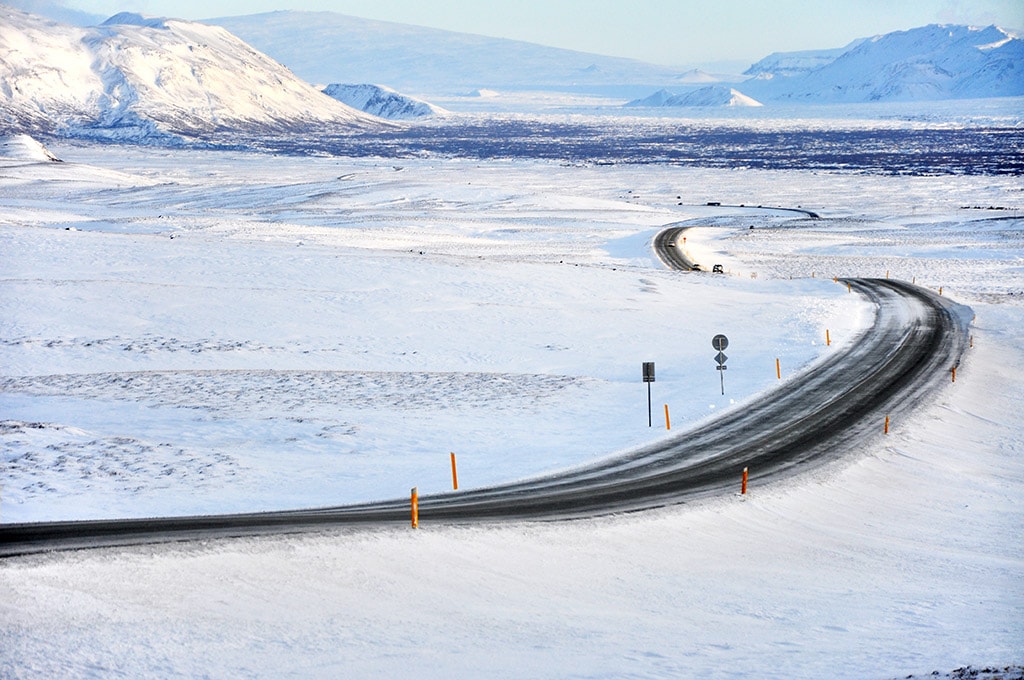
Iceland’s main Ring Road is easily navigated and in good condition. However, while it benefits from year-round maintenance, in winter, the weather conditions can change swiftly so that even that road can see closures for short spells. The smaller roads in fjord areas can be less well-maintained and tricky to drive on during that season.
It’s best to rent a four-wheel drive vehicle if choosing to explore North Iceland from November to April (or any time of year if approaching the region from the Highlands). If you’re not experienced in driving through the wintry conditions you might encounter during that period, it’s safest and best to join a guided tour instead. But you don’t have to worry about that during the summer months: driving around North Iceland in any kind of vehicle should be a breeze, provided that you stick to paved roads.
Average temperatures in the north are slightly cooler than in southern and western parts of the country, its proximity to the Arctic Circle sometimes feeling quite evident. Winter arrives sooner, and spring arrives later there than in Reykjavík.

Winter nights in the north are long and extra-dark, the daytime lasting as little as three hours. This makes the region the most statistically-probable place for clear winter skies. So if the aurora borealis, or northern lights, are what you’re after, North Iceland is your dream destination.
You’ll be pleased to hear that statistically, North Iceland is also the driest and sunniest part of the country. Somewhat lower precipitation and fewer clouds make it a bit more pleasant than the rest of the country. Though even the summer months are slightly cooler than elsewhere, the sunnier weather and longer days make it glorious. Unlike in the southerly regions, you may even be able to see the midnight sun: a true Arctic Circle experience.
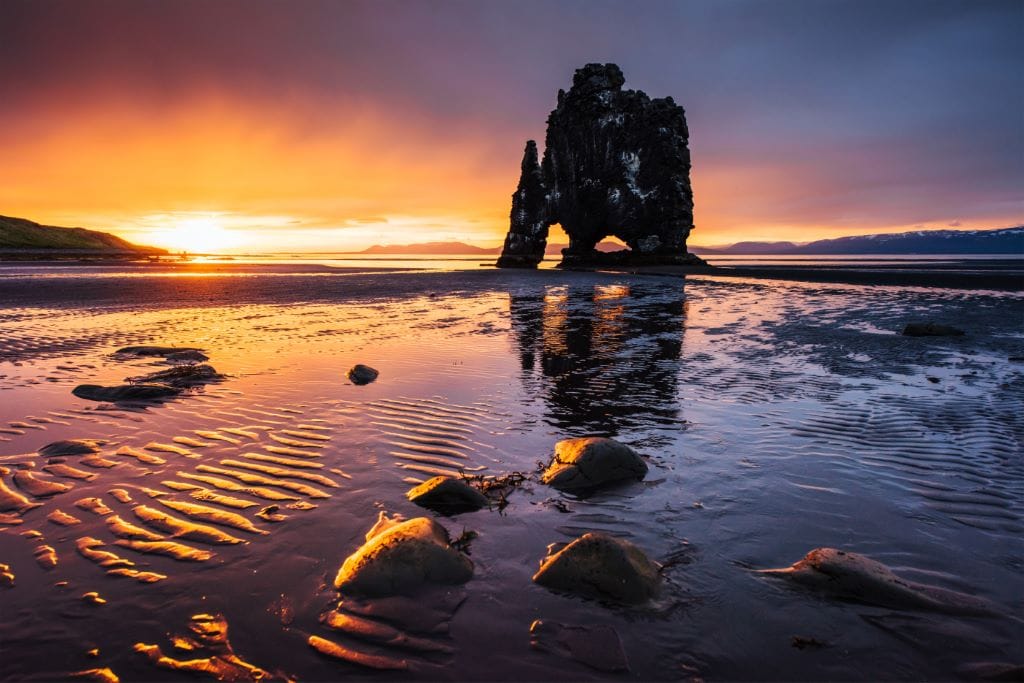
Iceland is a latecomer to Europe, forming over 100 million years later than the continent, about 26-44 million years ago. The entire country lies directly on top of a geological hotspot; hence it is well-known for geothermal heat and volcanic activity.
North Iceland is divided in two by an active volcanic zone, a fissure in the Myvatn area, which runs from north to south and is part of the Mid-Atlantic Ridge. This accounts for the volcanic system of the region. It includes two central volcanoes, Askja in the eastern Highlands and Krafla in the North, associated eruptions, high-temperature geothermal fields, lava flows, and rhyolite and silicic rocks. So the dramatic and unusual landscape was formed by that very Krafla-Námafjall fissure, which has erupted many times for centuries.
The most famous eruption in the area is known as the Mývatn Fires, which occurred from 1724-1729. Many different fissure vents opened simultaneously, creating a lava flow that destroyed farms near Reykjahlíð, thankfully with no fatalities. The event caused lava fountains to be observed from the country’s south.

In December 1975, one of the largest modern Icelandic eruptions began, lasting almost nine years. The “Fires of Krafla” as it is known, saw the eponymous volcano erupt nine times over that period, taking a break now and then in between. By the time it was finished, a lava field measuring 36 square kilometers, or 13.9 square miles, had been formed.
There have been no further eruptions since 1984; nonetheless, a hot geothermal field remains inside Krafla’s crater, and the area continues to be replete with powerful volcanic activity. This is very useful for nearby communities that harvest geothermal power for electricity and hot water for their homes and swimming pools.
The famous Blue Lagoon in the south is matched by the northern Myvatn Nature Baths, a gift from all the geothermal activity to balance the risks. Lake Mývatn is part of the system and is surrounded by many great geological beauties, such as picturesque lava fields and pseudo-craters.
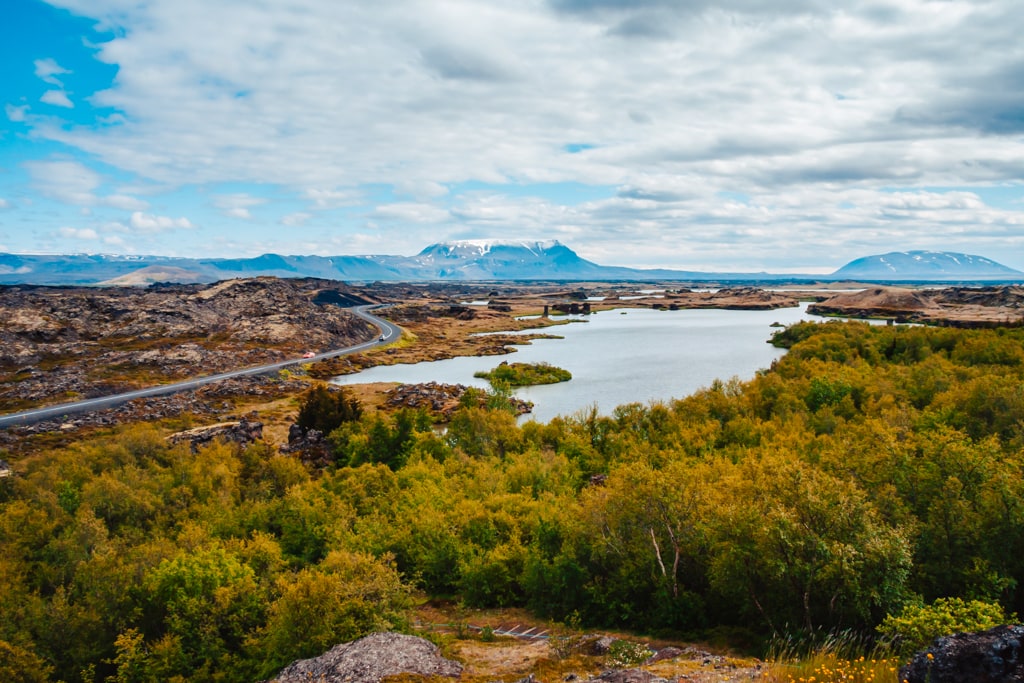
But the region offers more than ‘just’ volcanoes and volcanic offspring. It also contains incredible mountains, some snow-capped throughout the year, with the mountainous Highlands of central North Iceland hosting small cirque and rock glaciers. You can find those tall mountains on the Tröllaskagi Peninsula, which is an essential destination in summer or winter if you love hiking or skiing.
The incredibly varied and fascinating geological features of North Iceland are born of a complex interaction between fluctuating sea levels, glacial rivers, glaciers, lakes, and volcanic activity. It is, therefore unique, not just in the world but even in comparison to the landscape you’ll find in the east, south, or Westfjords of Iceland. And in addition to all of that, you can observe the boundaries between the Eurasian and North American tectonic plates. There’s nowhere else like it.

Things to Do in North Iceland
With so many astonishing sights and exhilarating activities in this most unique of countries, taking your time to travel extensively will make the most of it and leave you with far more memories and experiences than a flying visit. Exploring North Iceland thoroughly, whether self-driving or touring, is something you’ll never regret.
Start road-tripping by following the Ring Road northwards out of Reykjavík, but take detours as you go to explore the peninsulas we’ve described above. In a city, a detour is often a negative experience caused by roadworks; the opposite is true here.
Stop at every village possible for a coffee, which is a very important beverage in Iceland. Explore each place and enjoy what’s there, whether strolling in a harbor, chatting with local people, learning from a historical site, or trying a local specialty. Even the smallest and most remote villages are prepared for visitors, and you can expect warm welcomes.
We listed North Iceland’s must-visit attractions in this separate article .
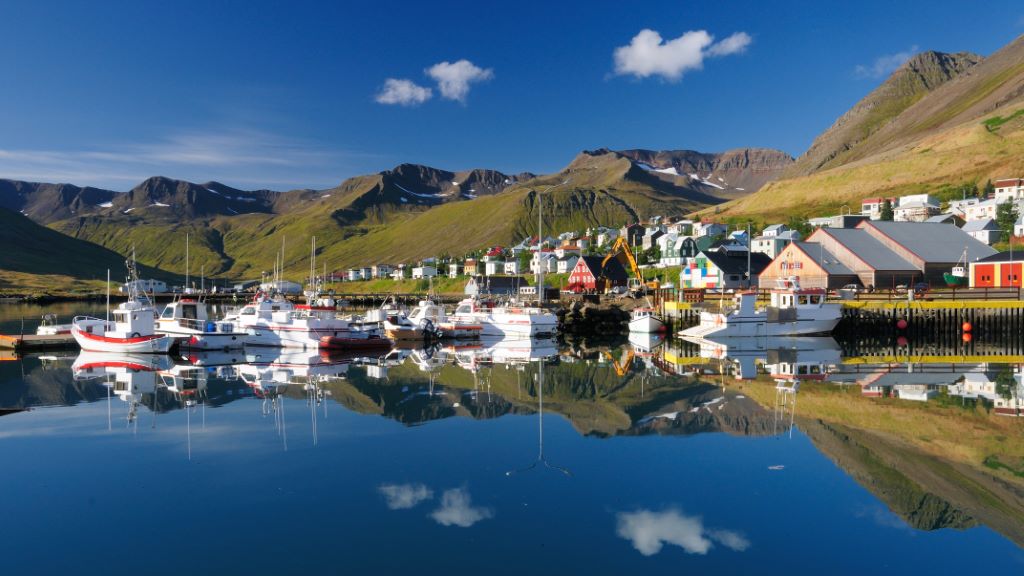
You don’t have to feel rushed or regimented. Remember to breathe deeply in the crisp air, listen to the birdsong, watch the skies change, and relax as you soak in the plethora of geothermal pools.
If you’re touring in winter, be sure to have a suitable vehicle, and check weather and driving conditions frequently. Remember that if you don’t have winter driving experience, it’s easy to book a guided tour and put yourself in the safe hands of a local who knows the roads and meteorology.
The Ring Road is closed only occasionally when the weather is truly bad and rarely for longer than a few hours. While smaller roads may be difficult to drive or entirely inaccessible in winter, it’s always possible to get to Akureyri as long as the Ring Road is passable. In summer, however, it’s safe and simple to drive in North Iceland, though do consider a four-wheel drive vehicle if traversing the Highlands.

North Iceland is a paradise for people who love hiking in nature. Great trails can be found in the mountains near Akureyri, in the areas of Myvatn and Krafla, and on the peninsulas with their fascinating cliffs. But the best destination for hiking is probably Ásbyrgi Canyon because it is so unique in Iceland and the world.
Different paths crisscross the small but dense forest between the massive canyon walls. The trails end at an impressive wall 100 meters (328 feet) high, at the foot of which is a small turquoise and green pond, sometimes with birds floating calmly on it. It’s like stumbling across a colorful jewel at the foot of a castle. The most appealing thing about that place is the acoustics, which magnifies sounds. The ducks still quack away, but human visitors find themselves whispering, so they don’t disturb the peace or perhaps to avoid disturbing any ‘little people.

The fjord waters of North Iceland are generally safe and calm to paddle around, especially for experienced kayakers, so exploring and viewing the landscape from the water is highly recommended. If you have little or no experience with paddling or sea travel, you can gain some by booking a guided boat or kayak tour available in many villages. Some boat tours even give you the option of traveling to more remote islands and within the Arctic Circle, which also provides the bonus of possibly spotting such sealife as dolphins, seals, and even whales.

No matter what time of year you visit Iceland, heading north gives you the best chance of experiencing the unforgettable phenomena known as the northern lights and the midnight sun.
The northern lights can be seen between late August and late March. North Iceland is the ideal location to gasp and gaze at them due to its longer nights and clearer and less cloudy skies than the south. To maximize your chances, use apps and websites to track predictions of aurora activity and weather conditions, avoid city lights and a full moon, stay up late (there is statistically more activity from midnight onwards), look to the northern horizon, and look out for them on more than one night.
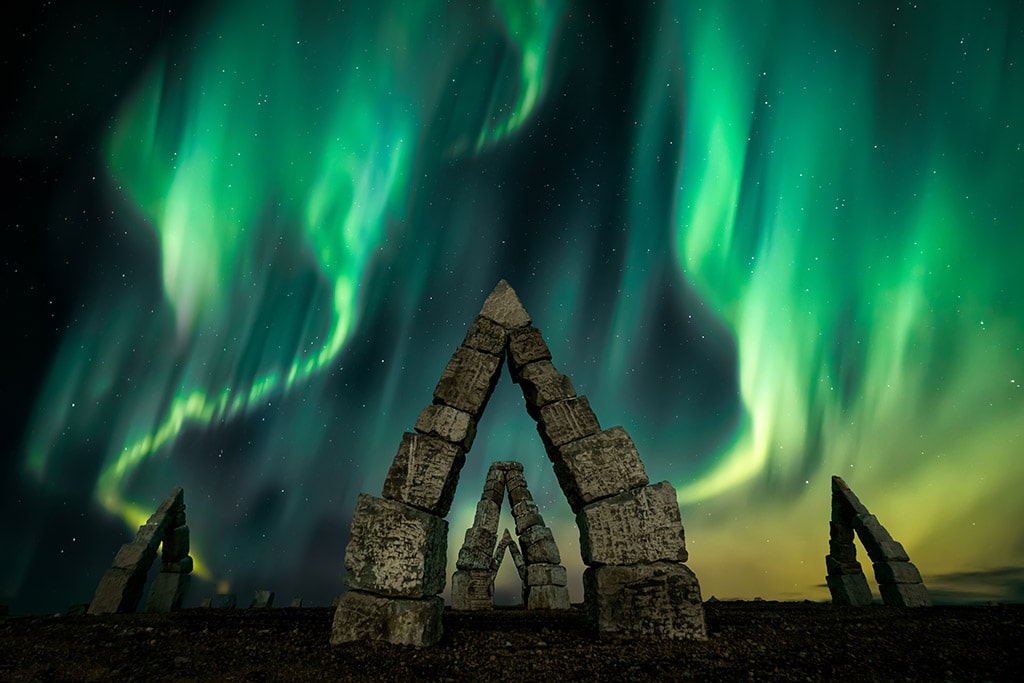
Northern Iceland is also best for seeing the midnight sun due to its proximity to the Arctic Circle. This unending sunset can be observed in June and July and only from a few places up north. So don’t try it from Reykjavik, and plan.
The GeoSea Baths mentioned above, set on a high cliff in Húsavík, have an idyllic viewpoint over the North Atlantic and opening times that make it possible to bathe and relax while witnessing the northern lights or the midnight sun as well as taking in the landscape.

It would be hard to find a more scenic spot to enjoy geothermal pools than this North Icelandic heaven. Having said that, the pool in Hosfós has just as beautiful a view, though it is perhaps a little less luxurious. Try them both and see which one is the favorite to which you’ll long to return.
The Mývatn Nature Baths are often referred to as the northern counterpart of the world-famous Blue Lagoon Spa. Its water has very similar characteristics to the Blue Lagoon. However, the facilities are less luxurious, but the entrance fee is also much cheaper. It’s the only pool of its size in the area and is ever-increasing in popularity.

As with sky watching, you’re better off dolphin, porpoise, and whale watching in North Iceland, as it’s the best part of the country for successful sightings of the marvelous creatures. You can take tours from the Snaefellsnes Peninsula and Reykjavík, but the success rate in North Iceland is nearly 100% in the summer months. The proof is that northern companies offer a free second trip or a guaranteed refund if you see no cetaceans.
Iceland’s waters are host to over 20 species of these incredible creatures, some seen more frequently than others. Tours in the north tend to light upon eight cetacean species in particular. Humpback whales are naturally curious and friendly, so there’s a good chance of seeing those, as well as harbor porpoises and white-beaked dolphins. Minke and pilot whales are seen less often but not uncommonly. While shyer, the stupendous blue whales are seen at least a few times each summer season. Why not try your luck?
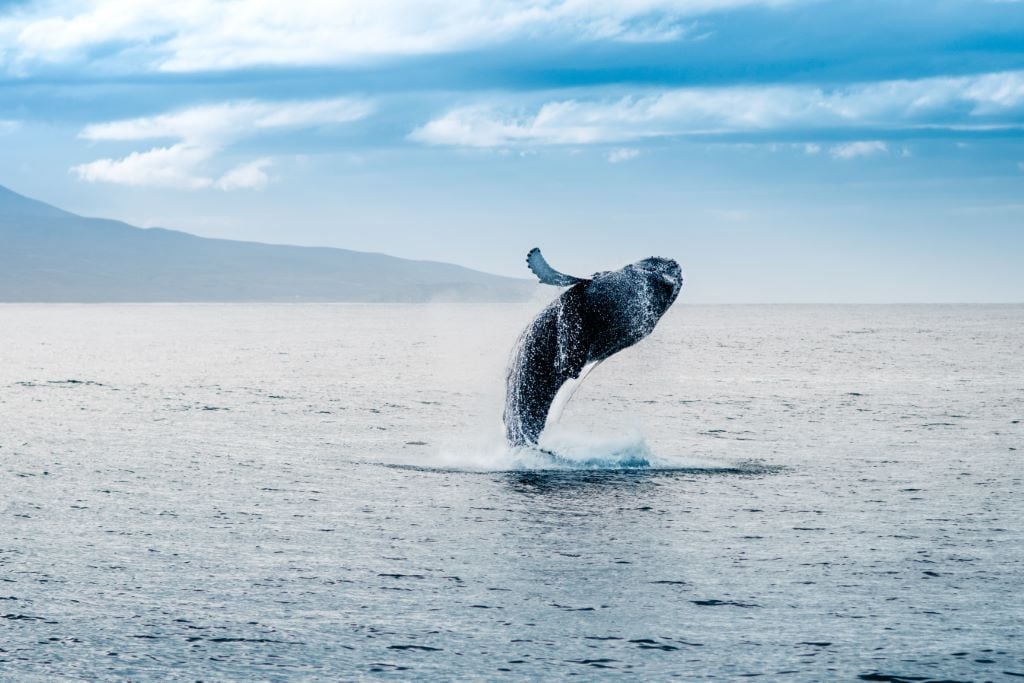
As for wintertime, there are still whale-watching tours in operation; it’s just that your chances of sightings are lower, at around 90–95% of North Iceland-based trips. But going whale watching at any time of year is more than just an adventure and often a delight. It also supports an economy that arose as an alternative to hunting and killing whales. For this reason, the Icelandic whale-watching industry motto is, “Meet us, don’t eat us!”
The ski areas in North Iceland offer especially breathtaking views and diverse landscapes. Seven well-equipped ski resorts in the region are open from mid-November to May. Offering ski rentals and ski schools for everyone, the slopes are suited to children and adults. Whether a beginner or an extreme skier, you’ll find what you’re looking for!
Experienced skiers can immerse themselves in backcountry skiing; the opportunities are endless. The most popular skiing destination is Troll Peninsula, where long runs can reach up to 1,500 meters (4 921 ft) vertical. With upwards of about 100 mountains to discover on the Troll Peninsula, there is an endless amount of untouched snow. The peninsula is surrounded by the Arctic Ocean, so you can ski down right to the coast. The terrain looks as if it had been specially created for ski touring, snowboarding, and heli-skiing, all of which are available activities for the avid skier.
Backcountry skiing on virgin slopes requires special snow conditions; therefore, the season differs from the regular ski season. In North Iceland, snow conditions usually remain favorable well into spring, the season lasting from mid-February to the end of June.

We’ve covered the most interesting facts and most exciting activities regarding North Iceland in our article. In this separate article , you can read about what to see in the region. Contact us for your tailor-made vacation package, and a local professional will personally help you to plan your perfect North Iceland holiday.
- Share on Facebook
- Send in Messenger
Related Posts
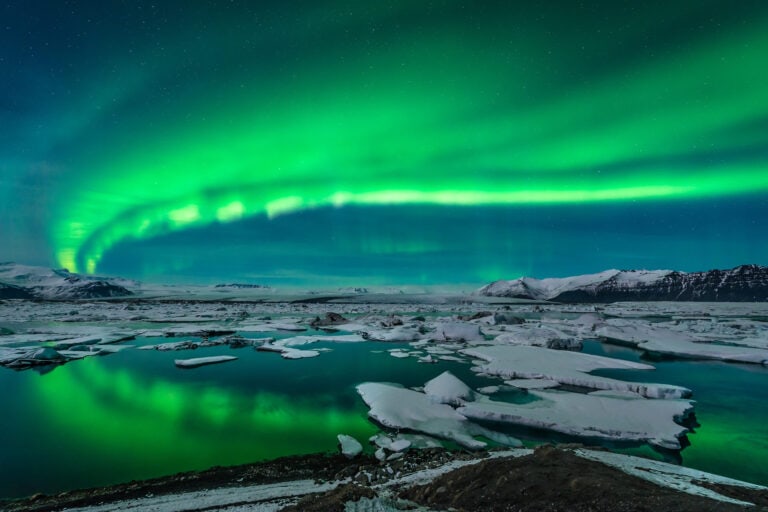
The Aurora Hunter’s Practical Guide to the Northern Lights in Iceland – 2024 Winter Edition
The Aurora Borealis is a magnificent natural phenomenon that lights up Iceland’s night skies for more than seven months of the year. The chance to

The Spa Lover’s Guide to Iceland: 9 Luxurious Geothermal Baths to Visit in 2024
Every visitor should add at least one geothermal spa to their itinerary. You can read below some of the best places to look at before deciding which one, or ones, are for you.
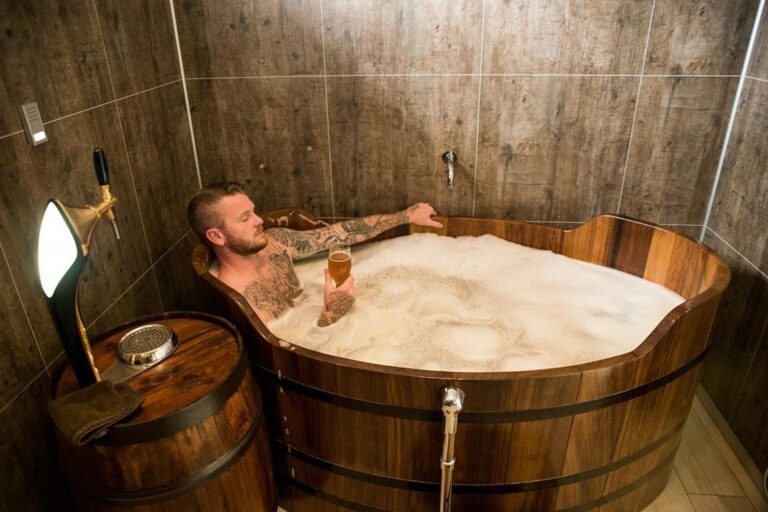
24 Unique Things to Try in Iceland in 2024
Iceland is considered by many to be the world’s most beautiful country. The wide variety of natural wonders available on a tiny island is unsurpassable.
Recent Blogs

13 Exciting Attractions to Visit on the Reykjanes Peninsula
Featured vacation packages, adventure-packed carbon neutral premium self-drive iceland tour – 8 day, sustainable iceland family adventure – 8-day co2 neutral self-drive tour, activity-filled co2 neutral self-drive tour – 5 days, action-filled luxury summer adventure, activity iceland by icelandia.
Authorized Tour Operator and Travel Agency certified by the Icelandic Tourist Board under the registered name Ferðaskrifstofa Kynnisferða, part of the Icelandia family .
- US/Canada: 1 (888) 642-8669
- International: (+354) 533 6003
- [email protected]
- Klettagarðar 12. 104 Reykjavík, Iceland
- Private Tours
- Vacation Packages
- Our Car Fleet
- Privacy Policy
- Terms & Conditions
- Environmental Policy
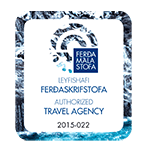
Tours offered on this website are sold under the license of Ferðaskrifstofa Kynnisferða.
© All rights reserved
Special offer
For a limited time on selected super jeep tours.

- Jul 7, 2023
Top 13 Things To Do in Northern Iceland: Full Itinerary + Map
Do you want to explore the stunning landscapes and vibrant culture of Northern Iceland ? Then look no further! Discover Northern Iceland's iconic attractions, such as the basalt columns at Dimmuborgir, or unearth hidden gems like Mývatn Nature Baths.
This guide unveils the best things to do in Northern Iceland . With a full itinerary and Map, all that's left is for you to pack your bags and start exploring this breathtaking region! So read on if you're looking for an unforgettable experience in one of Europe's most unique destinations.

The Best Things To Do in North Iceland
Iceland's north coast has plenty of hidden gems for outdoor adventurers and nature lovers. From glacier lagoons to thermal hot springs, the region offers an array of unique attractions and activities that will make your trip unforgettable.
Whether you are looking for a relaxing vacation or an action-packed getaway, Northern Iceland has something for everyone! From surfing and whale watching in northern Iceland to snowmobiling and dog sledding, here are some of the best north Iceland attractions.
1. Go Whale Watching in Northern Iceland
To experience the beauty of Iceland's animals , head out on a whale-watching tour . The waters around Northern Iceland are teeming with:
Humpback whales
From the comfort of a boat, you can watch these majestic creatures splash and play in the sea. Whale watching in northern Iceland is a one-of-a-kind experience and a must-do activity in the region.

2. Experience the Thrill of Extreme Sports
Experience the thrill of extreme sports in Northern Iceland , where the stunning landscapes offer endless possibilities for adventure. From glacier climbing to ice caving , these heart-pounding activities are among the top things to do in Northern Iceland. Push your limits and immerse yourself in the raw and captivating beauty of this remarkable region.

3. Observe Charming Puffins Up Close
If you're wondering what to see in northern Iceland, make sure to add puffins in Iceland to your list. These charming birds are a common sight along the north coast of Iceland. Visit one of the region's puffin colonies to see these feathered friends up close. It's a great chance to appreciate the wildlife of this remarkable country and snap some beautiful photos.

4. Enjoy Hiking in Northern Iceland
Discover the beauty of Northern Iceland through hiking. Explore diverse terrains, from cascading waterfalls to rugged lava fields. Hiking in Northern Iceland offers breathtaking landscapes and a sense of tranquility , rejuvenating the soul with every step taken in this outdoor paradise. Hiking in Iceland is an activity that should not be missed!

5. Catch the Waves and Surf in the North Atlantic
Engage in thrilling activities in North Iceland by catching the waves and experiencing the exhilaration of surfing in Iceland . With its wild coastline and challenging swells, North Iceland offers surfers an unforgettable experience. Whether you are a beginner or an expert surfer, surfing in northern Iceland is something you won't want to miss.

6. Take a Dog Sledding Tour in Iceland
One of the best things to do in northern Iceland is to take a dog sledding tour . The sleds are pulled by Siberian Huskies , whose friendly and cheerful personalities make the tour even more special. This traditional form of transportation offers a unique way to explore the icy terrain of Northern Iceland. Dog sledding in Iceland is the perfect tour for adventure seekers and dog lovers alike!

7. Speed Across Snowfields and Glaciers on a Snowmobile
Experience the excitement of snowmobiling in Iceland , where you can speed across snowfields and glaciers. It's one of the must-try things to do in north Iceland, providing thrilling adventure and stunning scenery.
Discover the beauty of this region on a snowmobile tour of Lake Mývatn and the surrounding area. The tour is very popular, and bookings are highly recommended.

8. Camp in Scenic Locations Amidst Iceland's Untouched Nature
Immerse yourself in the untouched nature of northern Iceland by camping amidst its scenic landscapes. It's a perfect choice when deciding what to do in northern Iceland, offering a unique connection with the environment.
Set up camp in picturesque locations such as the Dettifoss Waterfall or Lake Mývatn . Enjoy breathtaking views and peaceful tranquility in these awe-inspiring places. Camping in Iceland is a must-do activity for outdoor enthusiasts.

9. Take a Dip in Mývatn Nature Baths
Indulge in relaxation at Mývatn Nature Baths, a must-visit Iceland spa and one of the top places to visit in North Iceland. Immerse yourself in the soothing geothermal waters, surrounded by picturesque landscapes. This tranquil oasis offers a rejuvenating experience, providing the perfect escape amidst the natural wonders of the region.

10. Ski in Iceland's Mountainous Terrain
Experience the thrill of skiing in Northern Iceland, a paradise for winter sports enthusiasts. Hit the slopes of Mt. Akureyri and enjoy the adrenaline rush while surrounded by breathtaking northern Iceland attractions. Skiing in Iceland offers a unique combination of adventure and natural beauty, making it an unforgettable winter experience.

11. Enjoy Vibrant Music Festivals in Northern Iceland
Immerse yourself in the vibrant music scene of Northern Iceland by attending thrilling Iceland music festivals , one of the top things to do in Northern Iceland.
The Aldrei Fór Eg Suður Rock Music Festival is held annually in Ísafjörður, a town located in the Westfjords region of Northern Iceland. This festival celebrates Icelandic rock music and has been running since 2004.

12. Fish in Abundant Rivers and Lakes in Northern Iceland
Enjoy the thrill of fishing in Northern Iceland's abundant rivers and lakes, regardless of the weather in Northern Iceland. With its pristine waterways, the region offers a haven for anglers. Cast your line amidst stunning landscapes and embrace the tranquility of nature while indulging in the rewarding experience of fishing in Iceland .

13. Marvel at Basalt Columns in Iceland's Unique Geological Formations
The basalt columns in northern Iceland are among the most fascinating things to see in northern Iceland. These unique geological formations , formed by lava cooling and hardening into hexagonal shapes, can be found throughout the region. From the iconic Dimmuborgir to the dramatic Godafoss waterfall, visitors can marvel at these natural wonders.

Northern Iceland Itinerary: Experience the Best of Northern Iceland in 5 Days
If you're looking for things to see in north Iceland, this 5-day northern Iceland itinerary is perfect for exploring the best of this captivating region. Not only will you experience the best of Iceland's wonders, but you will also take part in thrilling activities and embrace the culture of this unique area. So if you're ready, here is what you can explore in North Iceland!
Day 1: Go Whale Watching off the Coast of North Iceland
Start your journey in Husavik, one of the best towns to visit in northern Iceland. Husavik is a seaside town known as the whale-watching capital of Iceland.
Take a whale-watching tour and see these majestic creatures up close. Whale watching in northern Iceland is an activity you won't want to miss! In the afternoon, head to Dettifoss Waterfall for an incredible view of the largest waterfall in Europe.
End your day by camping near the picturesque Mývatn Nature Baths. We also recommend sleeping at Húsavík Green Hostel , one of the best hostels in this part of Iceland.
Driving Distance: 147 km/91 mi
Travel Time: 2 Hours
Day 2: Explore the Lake Mývatn Region and Take a Dog Sledding Tour
Spend your second day in the Mývatn area, one of the top places to visit in North Iceland. Start by taking a dog sledding tour and exploring the icy terrain.
In the afternoon, visit Dimmuborgir and marvel at its impressive basalt columns. This is a north Iceland must-see and the perfect place to take photos. Then, head to Námafjall, known for its bubbling mud pools and steaming fumaroles.
Afterward, relax in the Mývatn Nature Baths and enjoy its therapeutic waters. For accommodation, we recommend staying at one of the hotels in Akureyri or one of the cottages near Lake Mývatn.
Driving Distance: 114 km/71 mi
Travel Time: 1 Hour 40 Minutes
Day 3: Go Snowmobiling on Glaciers and Skiing in Mt. Akureyri
Explore the snow-covered terrain of northern Iceland and go snowmobiling on the glaciers. Spend your afternoon skiing in Mt. Súlur and take breathtaking views of the surrounding area.
Next, head to the capital of north Iceland, Akureyri. This charming town is known for its quaint buildings and vibrant music scene. Before you end your day, make sure to visit the Akureyri Church and explore its vibrant artwork.
Stay at one of the hotels in Akureyri or book a camping spot at Hlíð Camping and Guesthouse near Lake Mývatn on the Icelandic ring road .
Driving Distance: 27 km/17 mi
Travel Time: 31 Minutes
Day 4: Fish in Abundant Rivers and Lakes and Visit the Akureyri Botanical Garden
Spend the day fishing for salmon and sea trout in the Húseyjarkvísl River or the plentiful lakes of North Iceland. Take in the peaceful atmosphere and admire the stunning views.
In the afternoon, visit Akureyri Botanical Garden and marvel at its exotic plants. This lush oasis, located in the heart of Akureyri, is a great place to take a leisurely stroll and admire the colorful flowers.
For accommodation, we recommend staying at Hótel Akureyri or one of the hotels in Akureyri.
Driving Distance: 95 km/59 mi
Travel Time: 1 Hour 10 Minutes
Day 5: Visit the Westfjords and Attend A Music Festival
On your last day, drive to the Westfjords region and experience the beauty of this isolated part of Iceland. If you're going to Iceland during Easter, make sure to attend the Aldrei Fór Eg Suður Music Festival in Ísafjörður, a town located in the middle of the Westfjords. This festival celebrates Icelandic rock music and has been running since 2004.
In the afternoon, explore Latrabjarg Bird Cliffs , located on Iceland's westernmost tip. This is one of the best north Iceland attractions and a great place to view puffins and other seabirds. Afterward, relax at the Gjögur swimming pool and enjoy its natural hot springs.
We recommend staying at one of the hostels in Ísafjörður or opting for a cabin in Isafjordur, which is close to the festival.
Driving Distance: 389 km/241 mi
Travel Time: 6 Hours

A Captivating Escape: Discover the Beauty of Northern Iceland
Northern Iceland offers a captivating escape where natural beauty reigns supreme. From stunning waterfalls and geothermal hot springs to otherworldly landscapes and charming coastal towns, this region is a paradise for adventurers and nature enthusiasts alike.
To make the most of your journey and explore the hidden gems that Northern Iceland has to offer, we highly recommend renting a car. With the freedom to chart your own course, you can effortlessly navigate the rugged terrain, discover remote locations, and immerse yourself in the untamed wilderness.
Renting a car in Iceland will unlock a world of possibilities, allowing you to create unforgettable memories as you uncover the breathtaking beauty of Northern Iceland.
Recent Posts
The Natural Wonder and Myths of Asbyrgi Canyon, Iceland
Are There Mosquitoes in Iceland?
Exploring Rauðisandur: Iceland's Hidden Pink Sand Beach
Thanks for visiting nordicvisitor.com! For the very best browsing experience on our website, we urge you to upgrade to the most recent version of your browser . Some of our site features may not function properly on older versions.
Iceland is open: volcano update
- Search Suggested Results View All Results
- EUR (€)
- GBP (£)
- Self-Drive i
- Privately Guided i
- Guided Small Groups i
- Multi-Day i
- Northern Lights i
- Honeymoon & Romance i
- Solo Travel i
- All Types & Themes
- All Iceland Tours
- Best Sellers
- Special Offers
- Book With Confidence i
- ICELAND IS OPEN i
- Iceland Volcano Update i
- Why book with us i
- Travel Update
- Booking Terms i
- Sustainability Policy i
- Iceland at a Glance i
- Useful Information i
- Iceland Attractions i
- Iceland Blog i
- Scandinavia
- Switzerland
- United Kingdom
- Manage Booking
- Privacy policy
Iceland Bíldshöfði 20 110 Reykjavík +354 578 20 80 View Map
Sweden Scotland View Details
North Iceland
North Iceland is home to many natural and cultural wonders, many of which are tied to Norse mythology and fascinating tidbits from Iceland’s rich history.
Most popular
Top attractions in North Iceland
Akureyri, the largest town outside of the greater Reykjavik area, is situated in...
Lake Mývatn
Mývatn is a shallow eutrophic lake situated in an area of active volcanism in the north...
The lush Ásbyrgi canyon is more than one kilometre wide and over three kilometres long,...
Goðafoss, ("Waterfall of the Gods“) is among the most beautiful falls in the country....
Mývatn Nature Baths
The North’s answer to the Blue Lagoon, the Mývatn Nature Baths are an ideal spot to stop...
Dimmuborgir
The natural stone labyrinth of Dimmuborgir is located to the east of Lake Mývatn. It is...
The most powerful waterfall in all of Europe, you’ll hear Dettifoss’ mighty rumble long...
If you like whales, Húsavík is the place to be. This fishing village of 2,300...
More attractions
Other attractions in North Iceland
Hljóðaklettar
The ‘echo rocks’ or Hljóðaklettar, are a collection of basalt columns lying in every...
The 10 km in diameter Krafla caldera is located along a 90 km long fissure zone in the...
The enormous tephra crater Hverfjall was formed in an explosive eruption some 2,500...
Skútustaðir
The Skútustaðagígar pseudo-craters are located in the Lake Mývatn area. The craters...
The Herring Era Museum
The award-winning museum delivers visitors back to the times when a booming fishing...
Skagafjörður
Skagafjörður is one of the most historically famous districts in Iceland. Sometimes...
Glaumbær Folk Museum
Within Skagafjörður is the folk museum at Glaumbær, situated in an old traditional turf...
Grimsey is the northernmost inhabited part of Iceland, located forty kilometres north of...
Other regions
Explore other parts of Iceland
South Iceland
Reykjavik capital area, east iceland, west iceland, the westfjords, reykjanes peninsula, central highlands of iceland.
Whether you have a single question or a special request, we're here for you.


What to see and do in northern Iceland
Many visitors to Iceland fly into Reykjavik, do the Golden Circle tour and stick around the southwestern corner of the country. And, indeed if you’re only here for a few days, there’s more than enough to see and do in this region to fill a short trip. But, if you do have a little longer, you may well want to venture further afield than the capital and its surroundings and head out into the wilds to explore the little-visited region of northern Iceland.
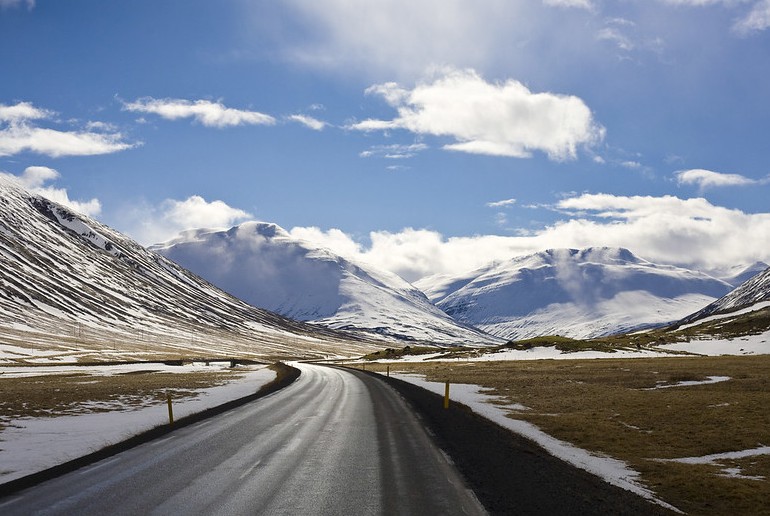
So, first things first: is northern Iceland worth visiting? Well, if you like snow-capped mountains, fjords dotted with tiny fishing villages, gushing waterfalls, thermal hot pools, great hikes and miles and miles of awe-inspiring scenery – then yes, it certainly is.
With its indented coastline, undulating rural landscapes, lakes, gorges and volcanic craters, many people consider the north to be the most beautiful part of Iceland.
It’s also the closest part of the country to the Arctic Circle – and with a very small population and few settlements to cause light pollution, northern Iceland is a great place to see the northern lights. From late-September to late-March, you’ve got a good chance of catching this amazing light show in the north.
There’s no shortage of nature and history to explore in this beautiful region, so we’ve picked some of the best things to see and do in northern Iceland.
Check out the waterfalls
Claiming to be Europe’s most powerful waterfall, Dettisfoss certainly is an impressive sight, with 500 cubic metres of water plunging over its edge every second. Fed by meltwater from Europe’s largest glacier, it’s about 100m wide and the water thunders down some 50m when it’s in full spate.
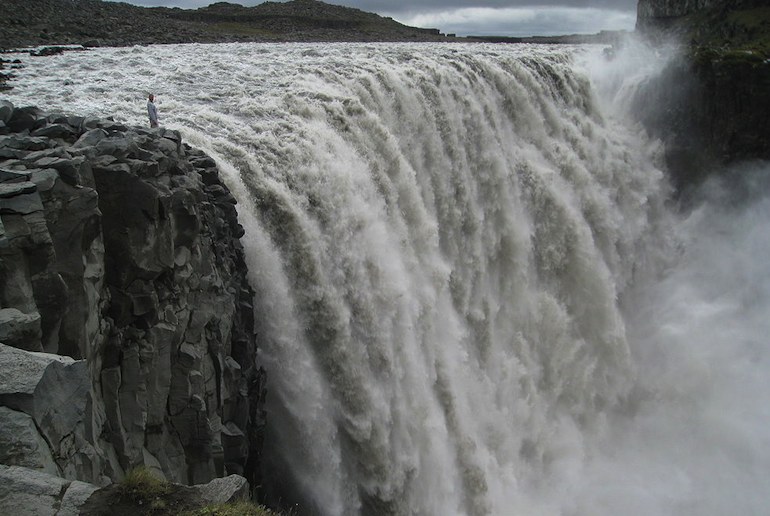
You can get there along a beautiful 34km hiking path which runs alongside a canyon in the Vatnajökull National Park – or, if you’re visiting in summer, simply drive there. In winter the road is often unpassable, though, and you’ll definitely need a 4WD.
And if that’s not enough thundering water for you, Goðafoss (meaning “waterfall of the Gods”) is another spectacular horseshoe-shaped waterfall in northern Iceland. Fed by Iceland’s fourth largest river, Goðafoss is easily visited all year-round – though again you’ll need a 4WD in winter.
If you don’t like the idea of driving yourself, there’s the option of a private jeep tour that will take you to both Dettifoss and Goðafoss waterfalls.
Visit the hot pots at Hverir
The Hverir geothermal area is an other-worldly region of bubbling mud pots and steaming fumaroles. Cracks and fissures criss-cross the orangey-red landscape, belching out steam and a potent smell of sulphur. Watch where you step – and be prepared for the smell!
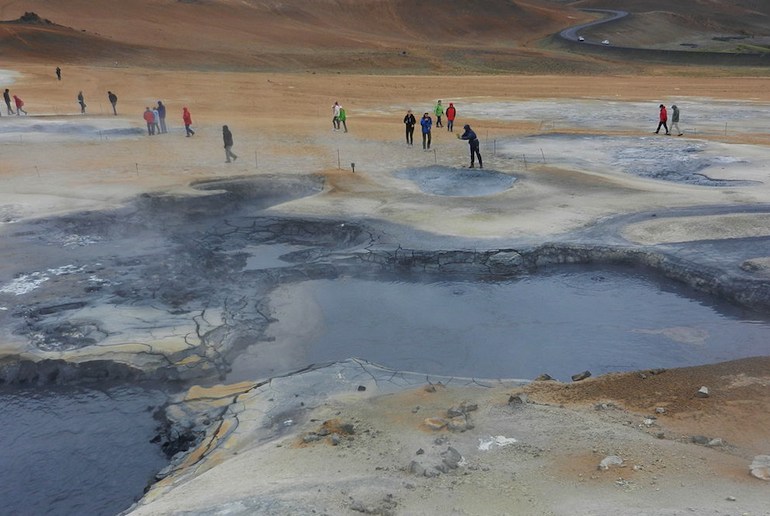
Drive the Arctic Coast Way
One of the best ways of exploring northern Iceland is to drive the Arctic Coast Way . This 900km route winds along the fjords of the northern coast from Hvammstangi to Bakkafjörður, passing pretty fishing villages, sandy beaches, craggy inlets and dramatic basalt rock formations.
You can stop off en route to go hiking, seal-spotting, whale-watching, horse-riding, bathing in hot pools and even Arctic surfing. And because the route is so close to the Arctic Circle, you get great views of the midnight sun in summer and the northern lights in winter.
Enjoy the bright lights of Akureyi
And if all this wilderness and nature is getting to you, you may want to explore the town of Akureyi, which sits in a picturesque location at the bottom of the Eyjafjörður, one of Iceland’s longest fjords.
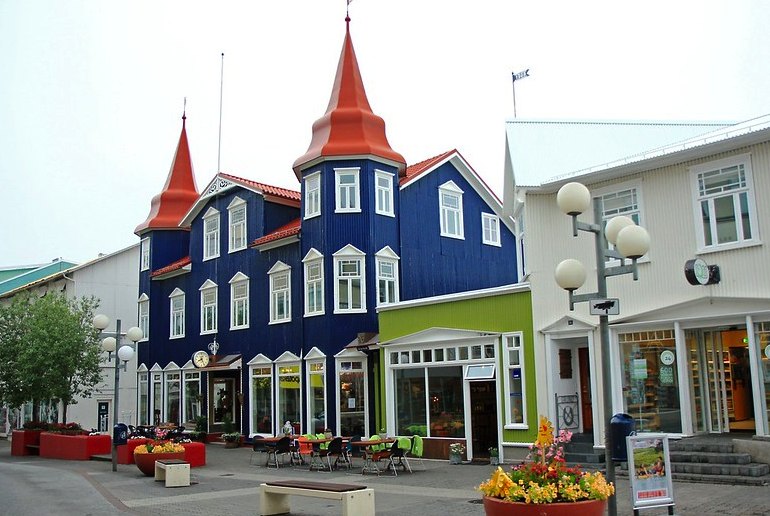
It may be Iceland’s second largest city, but with a population of just 20,000 it’s a laid-back, low-key place that makes a good base from which to explore the rest of northern Iceland. It’s a five-hour drive from Reykjavik, with direct international flights from some European cities, including London, at certain times of the year.
Visit the volcanic Lake Mývatn
Check out the beautiful Lake Mývatn surrounded by volcanic landscapes and home to a huge variety of birdlife, including geese, owls, ptarmigan, gulls, ducks and snipe. Look out over the lake from the Mývatn Nature baths, where you can swim in natural mineral-rich waters of around 36–40C – or simply lie back in the warmth and admire the views.
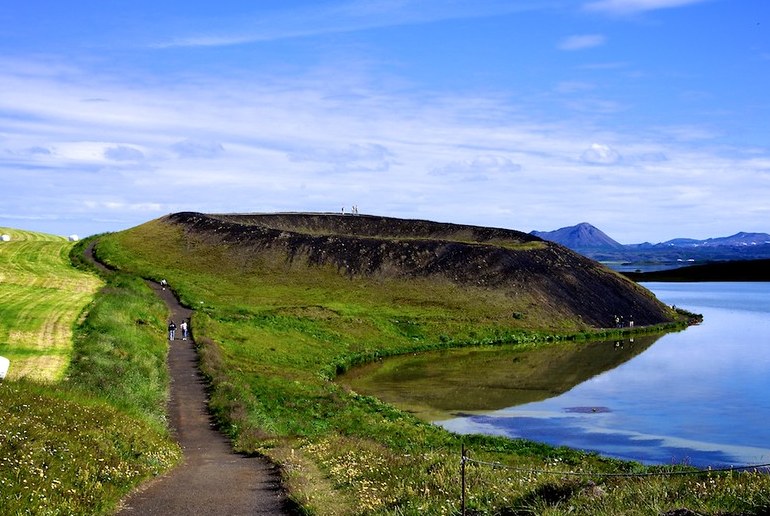
Have a beer spa
If it’s not enough to bathe in natural mineral waters, Bjórböðin , on the western side of the Eyjafjörður, has wooden tubs where you can lie back in a bath filled with beer. The mixture of beer, yeast, hops and water is rich in vitamin B and antioxidants, and relaxing in it is supposed to be good for the skin and hair.
You can’t drink the bath water, but each tub comes with own private draught beer pump, where you can help yourself to a brew. And, you can always take a dip in the outside hot tubs afterwards – though these are just filled with plain water!
Go whale-watching in Husavik
The north coast town of Husavik is known as Europe’s whale-watching capital – and indeed, there are plenty of boat trips leaving from here on whale safaris.
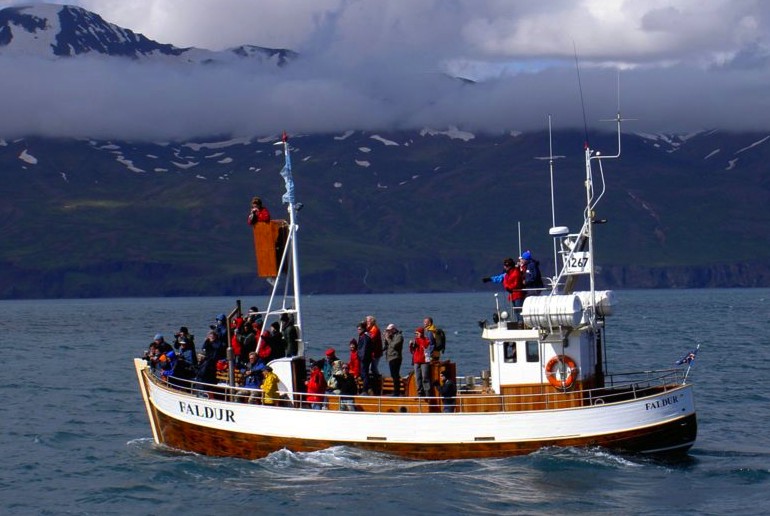
The waters around Husavik are rich in sea mammals, with minke whales, harbour porpoises and dolphins often seen, while migrating humpback whales visit these waters too at certain times of the year. This whale safari cruises round Skjálfandi Bay on a traditional wooden Icelandic fishing boat in search of whales, dolphins and sea birds.
Get “Trapped” in Siglufjörður
Fans of Icelandic crime drama Trapped will want to visit the pretty coastal town of Siglufjörður, tucked alongside a long fjord overlooked by glowering mountains. You can even stay here in the upmarket Siglo Hotel , which featured prominently in scenes from the drama.
See also: The best boat tours and cruises from Reykjavik 10 of the best Airbnbs in Iceland Alternatives to the Blue Lagoon in Iceland
TOURS AND ACTIVITIES IN REYKJAVIK MORE TOURS

Whale watching in Norway: when, where and how
You may also like.
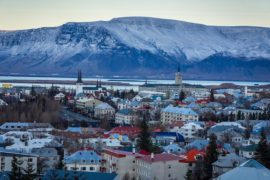
40 free and cheap things to do in Reykjavík
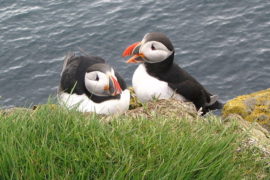
Where and when to see puffins in Iceland
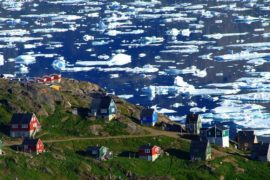
Greenland vs Iceland: which one is best?
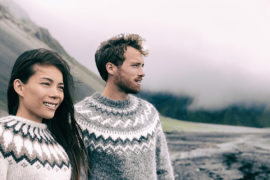
Icelandic last names: how do they work?

The Yule Lads: all you need to know about Iceland’s version of Santa
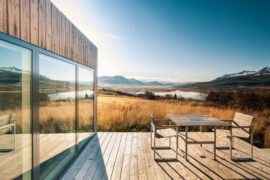
10 of the best Airbnbs in Iceland
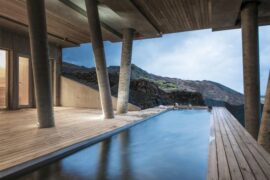
7 of the best hot spring hotels in Iceland
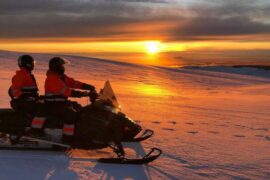
5 of the best snowmobile tours in Iceland
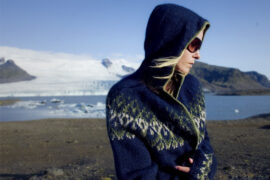
Traditional Icelandic sweaters: what to know before you buy
Get the Routes North newsletter delivered once a month. No spam.

23 Top-Rated Tourist Attractions in Iceland
Written by Anietra Hamper Updated Mar 14, 2023
Author Anietra Hamper has traveled throughout Iceland tackling outdoor adventures, from four-wheel driving over lava fields and fishing to taking in the waterfalls, hiking trails, and scenic drives.
Iceland, the island of fire and ice, has become one of the world's top travel destinations , not only for thrill-seeking adventurers but also for nature lovers looking for something different.
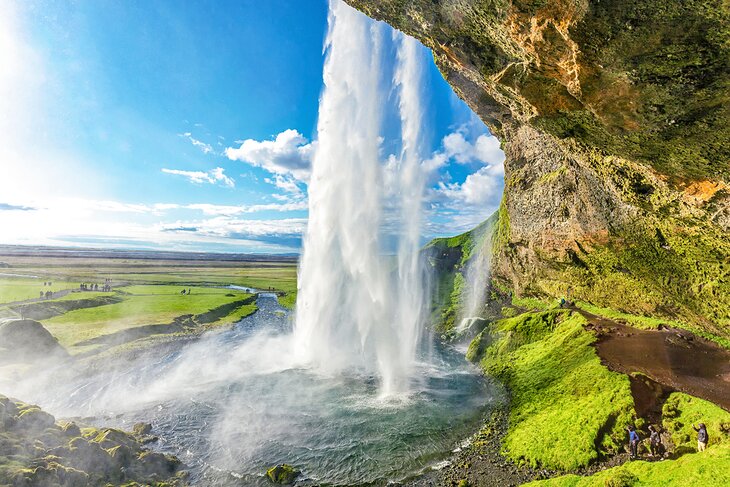
Here, you'll discover active volcanoes, geysers, hot springs, glaciers, ice fields, and fjords, for this sparsely populated country, resting at the edge of the Arctic Circle, sits atop one of the world's most volcanically active areas.
One way to explore Iceland is on your own with a rental car, from several days to a week, including a trip along the Ring Road that runs in a complete circle around the country.
Another way to plot your adventure in Iceland is with tours that can take you to the best options to see the northern lights; ATV trekking; and on day trips from Reykjavik to see some of Iceland's most stunning natural beauty, like the Blue Lagoon and waterfalls.
Find out more about the best places to visit with our list of the top attractions and things to do in Iceland.
1. Explore Reykjavik by Foot
2. ride to the top of hallgrímskirkja, 3. soak in the blue lagoon, grindavík, 4. gullfoss waterfall, 5. spot whales out of reykjavik, 6. watch spectacular geysers, 7. take in the northern lights, aurora borealis, 8. hike in landmannalaugar nature reserve, 9. maelifell volcano & myrdalsjökull glacier park, 10. attend a concert at harpa, 11. explore the skaftafell ice cave, vatnajökull national park, 12. visit an active volcano at askja caldera, 13. feel the spray of dettifoss waterfall, 14. kirkjufell mountain, grundarfjördur, 15. hiking at mount esja, 16. walk the town of akureyri, 17. bird-watching at lake myvatn & nature reserve, 18. the pearl observatory (perlan), 19. rev up adventure with an atv trek, 20. float along a glacial lagoon, 21. reynisfjara black sand beach, 22. tour the raufarhólshellir lava tunnel, 23. visit iceland's quirky museums, best time to visit iceland.
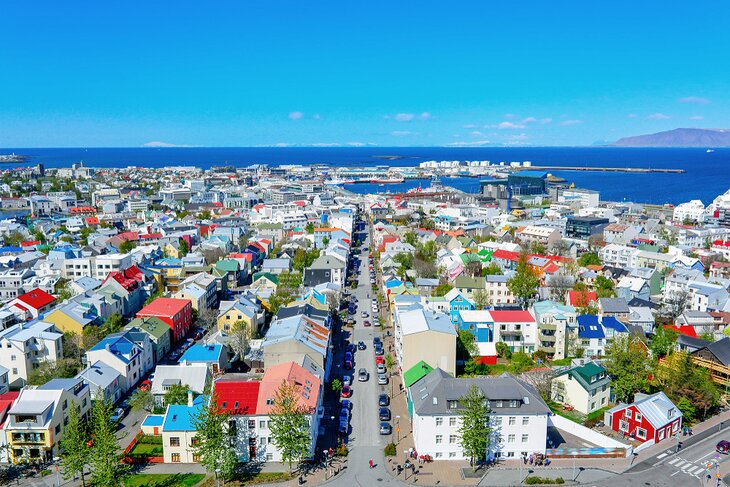
The best way to start your trip to Iceland is by sightseeing in the capital city of Reykjavik . This is a walkable city with many museums, restaurants, attractions, public art, and entertainment.
Take a stroll to see some of the iconic locations in the city, like Hallgrimskirkja church and the Sun Voyager sculpture, or relax in one of Reykjavik's 17 thermal pools. You will enjoy walking up and down the city streets and perhaps stop into one of the many artsy and boutique shops to buy a wool sweater or lava pottery.
You can also book a Reykjavik Food Walk Tour and nibble your way through Reykjavik's food scene enjoying local cheeses, or try an authentic Icelandic hot dog.
Some of the best resorts in Iceland are in Reykjavik, so you can base yourself in the city and take day trips. An extremely popular way to visit nearby areas is on a South Coast Full Day Tour by Minibus from Reykjavik.
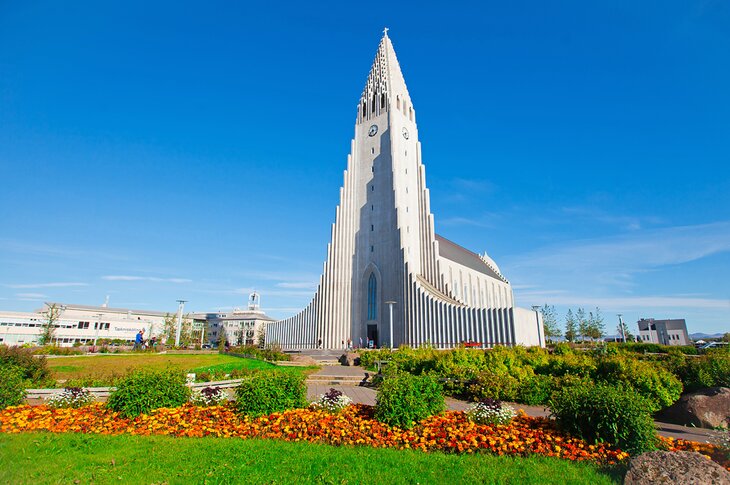
A Reykjavik modernist icon, this visually striking church is one of the city's top attractions, and when you see it, you'll understand why. Hallgrimskirkja is the tallest and most recognizable building in the country .
The Black Falls (a basalt rock formation), which is one of Iceland's natural wonders, inspired the architectural design. A climb to the top of the 73-meter-high tower is particularly rewarding. Here, you'll be treated to spectacular views across the city and surrounding landscape. At the front of the church is a statue of Icelander Leifur Eiriksson ("Leif the Lucky"), the first European to discover America around 1,000 CE. It seems he beat Christopher Columbus by around 500 years or so. For a small fee, you can take the elevator to the top and get the best panoramic view of Reykjavik.
Address: Hallgrímstorg 1 101, Reykjavik
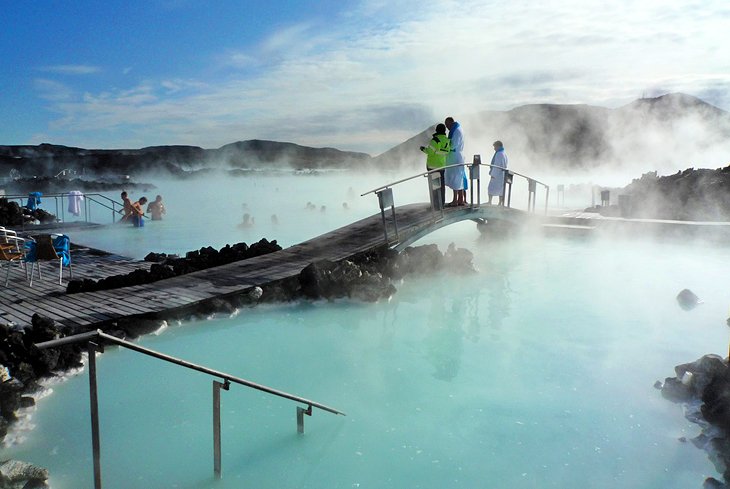
Just 40 minutes' drive from Reykjavík, the Blue Lagoon , the most iconic of geothermal spas, is a must-see tourist attraction. Here, you'll find natural bathing in pale blue water in the shadow of a power station.
An entire Blue Lagoon industry has grown around this attraction since it first became a hit with locals in 1976. The water from the underground hot springs reaches 37-39 degrees Celsius and is said to be highly beneficial for both health and skin. If the die-hard Icelanders are anything to go by, don't knock the theory. Aside from bathing in a unique setting, there's a shop selling skincare products, a range of spa treatments, and places to eat and drink. Don't visit Iceland without coming here.
Rub on a mask of natural mud in minerals from one of the tubs located on the edges of the lagoon. For the ultimate relaxing visit, you can stay at one of the two hotels at the Blue Lagoon and add on a day at the Retreat Spa.
It is easy to book a bus trip to the Blue Lagoon from Reykjavik, but if you want to add an extra element of Iceland adventure, you can book a day trip on an ATV that will have you drive there over lava rock paths and take you back by coach to your hotel.
Address: Norðurljósavegur 9, 240 Grindavík
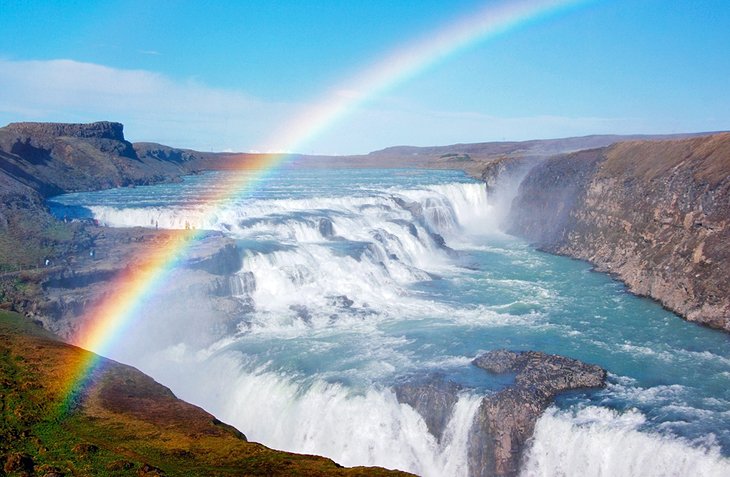
Magnificent Gullfoss Waterfall lies around 90 minutes west of Reykjavik and is one of the best waterfalls in Iceland . The river Hvítá plummets into a canyon, which forms three-step terraces, creating a powerful torrent. Gullfoss encompasses two cascades; the upper one drops 11 meters, while the lower one cascades about 21 meters.
Torrents of water flow over Gullfoss at an average rate of 109 cubic meters per second, although heavy floods have recorded an astonishing rate of nearly twenty times that. A word of warning: there are no rails or barriers, just a spine-tingling spectacle to enjoy amid surroundings as nature intended.
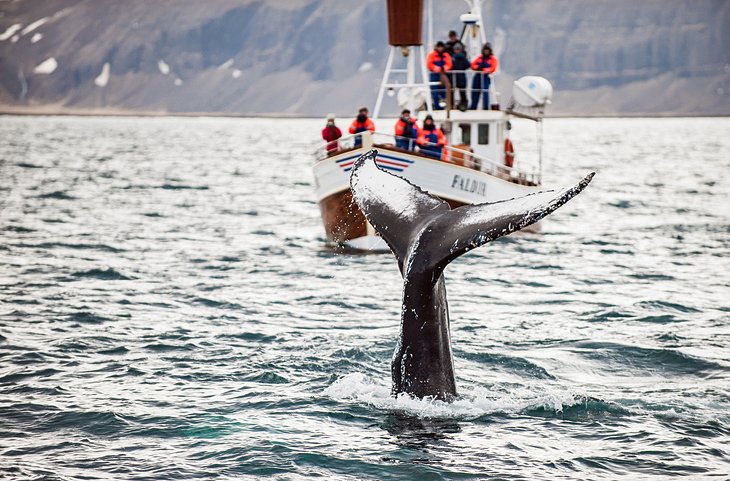
No matter what time of year you plan to travel to Iceland, whale watching happens year-round, although summer is the most popular time to see these gentle giants. During the warmer months, trips run day and night, including whale watching in the midnight sun.
Tour operators say there's an 80-95 percent chance of seeing these magnificent creatures, depending on the time of year. Best of all, surfacing often happens right near the boats, so you may well enjoy a ringside seat for one of nature's most awe-inspiring spectacles.
Other ocean-going tours are also available, such as bird-watching and island visits. Tours are convenient since there are several types available, and they depart from Reykjavik's Old Harbor. Stop for a dinner of fresh cod after you return in one of the many small, rustic restaurants located in the harbor area.
Address: Ægisgardur 5, Reykjavik's Old Harbor
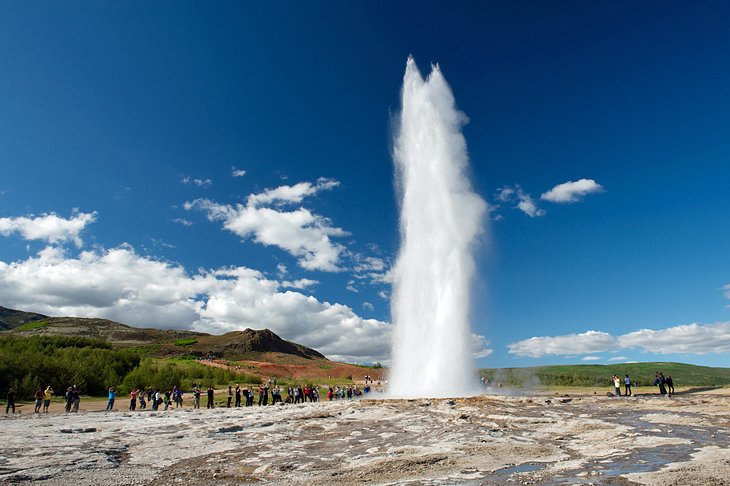
An easy 50-minute drive from Reykjavik , Strokkur Geysir (after which all geysers are named) is the most popular fountain geyser in the country and is famed throughout the world. This highly active hot spring area lies in the southwest of Iceland beside the Hvítá River and is a favorite stop along what's known as the Golden Circle.
Boiling mud pits and around 100 other smaller exploding geysers are waiting to be explored here. Every few minutes, Strokkur shoots water 30 meters into the air. Visit the Geysir Center for exhibits and informative presentations year-round.
A memorable experience is digging up Geysir or "hot spring" bread, rye bread that has been baking underground for 24 hours. Visitors can also help a chef boil eggs in a hot spring to accompany the bread. One popular day tour to the area is the Golden Circle Classic Day Trip from Reykjavik, which has several stops and can ensure you get the iconic geyser photo from your trip.
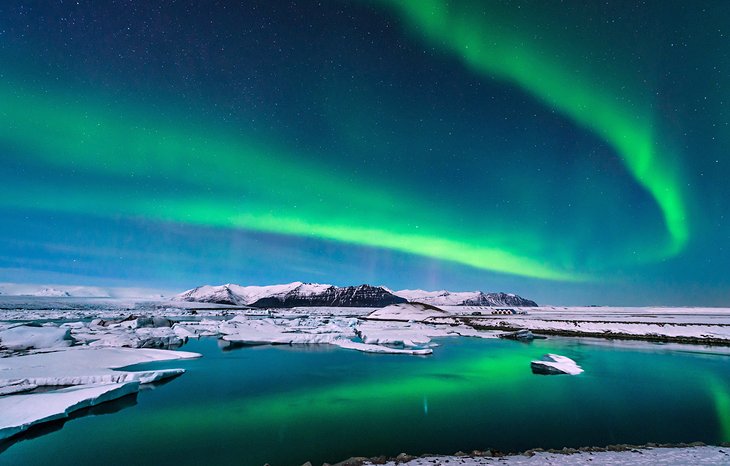
The northern lights, or Aurora Borealis, are among the most popular tourist attractions in Iceland. This is one of the best places in the world to see the northern lights .
Auroras are linked to solar wind, a flow of ions radiating from the sun. These particles become ensnared in the earth's magnetic field and collide with atmospheric molecules, causing bursts of energy, which appear as large circles around the poles. This spectacular natural light show is best admired in remote places and is particularly impressive at times of increased solar activity. Since the appearance of the northern lights is unpredictable, most hotels and lodging operators can provide you with nightly predictions before you go to bed and add you to an overnight call list.
They will call your room if the lights appear, as they may only be visible for a short window of time. For one of the most optimal opportunities to experience the northern lights, you can take a tour like the Northern Lights Night Tour from Reykjavik, which takes you to the remote countryside for the best chance to see this natural wonder.
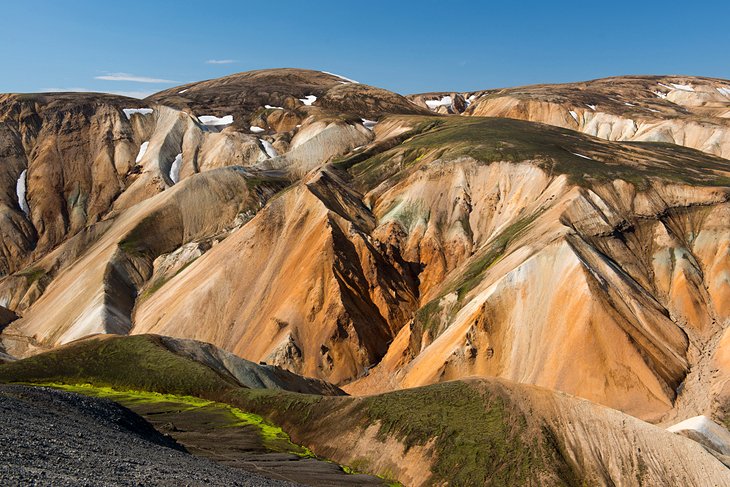
In the south of Iceland, 180 kilometers from Reykjavik, is Landmannalaugar National Park, one of Iceland's most popular tourist destinations. The main features of this mystical landscape are the multi-hued rhyolite mountains, Hekla volcano , and extensive lava fields.
Hiking and horse riding are popular things to do here, and hikes range from a couple of hours to several days. You can visit from June to late September, after which the road is closed. A mountain lodge ( Landmannalaugar Hut ) with basic facilities accommodates 75 people. Expect raw nature, rugged scenery, and utterly spectacular views.
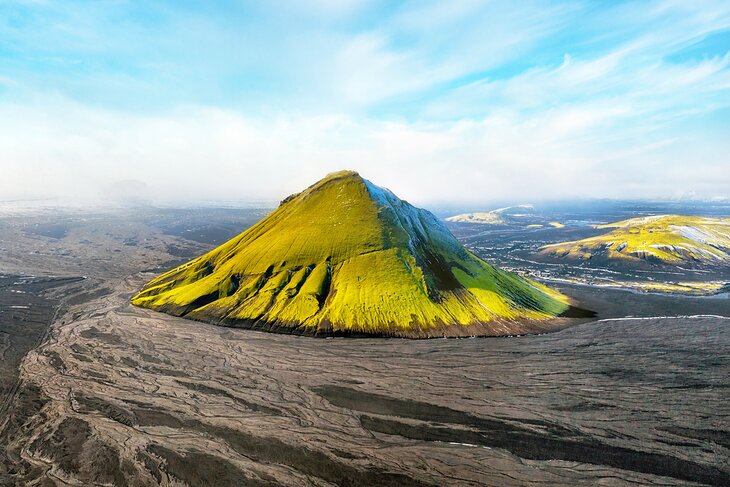
South of Landmannalaugar lies Myrdalsjökull Glacier Park, which for safety reasons can only be visited during summer. Large amounts of rain soak the area, particularly in winter, when roads can be severely damaged. Maelifell volcano is the undisputed jewel-in-the-crown of this wild, rugged glacial landscape.
The perfect cone shape gives Maelifell the look of a classic volcano, however during the warm season, a lavish green covering of moss gives it a surreal, otherworldly appearance. The park is full of volcanoes, hot springs , and other remarkable sites. To the west of Myrdalsjökull is a smaller glacier, Eyjafjallajökull (Island Mountain Glacier). A popular and thrilling way to explore is by snowmobile.
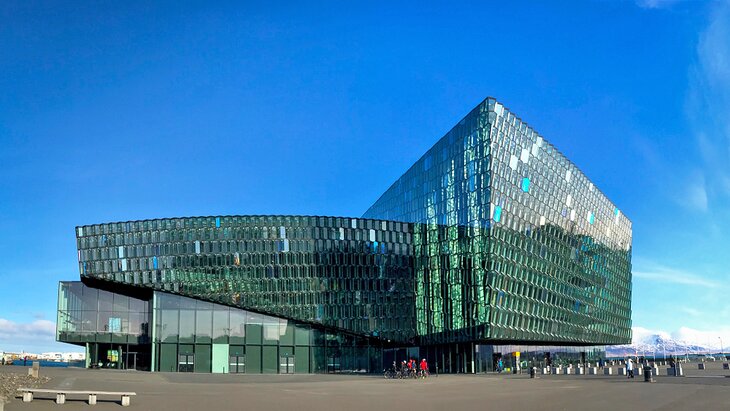
As you plan your time in Iceland, set aside an evening for a concert at the magnificent Harpa , Reykjavik's premier concert hall. If time or performance schedules do not fit your schedule, plan to at least stop by to admire the award-winning architecture of the building. Nighttime is one of the best times to see the array of colorful lights emanating from this honeycomb-shaped structure.
Harpa is a treasured landmark in Iceland, attracting international performances ranging from violinists and classical music to performing arts.
This venue makes for a great night out in the heart of the city. Enjoy dinner at one of Harpa's two restaurants and go for a stroll outside along the waterfront after the performance. The gift shop is a great place to pick up unique souvenirs, many made by local artists.
Address: Austurbakki 2, 101 Reykjavik
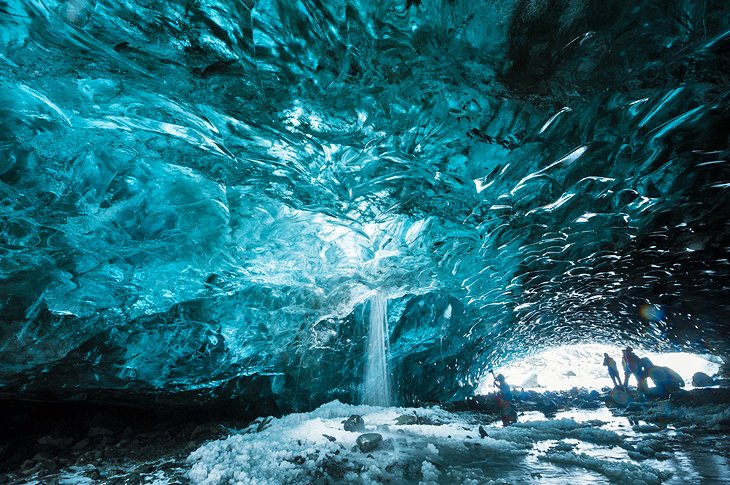
In the south of the country, Vatnajökull National Park is a land of glaciers and magnificent ice caves that attracts adventurers from across the globe. This vast national park (one of three in Iceland) is divided into four sections and consists of Vatnajökull glacier and its surroundings.
You'll find a number of visitor centers; those in Skaftafell Ice Cave and Höfn are open year-round, while Skriðuklaustur and Jökulsárgljúfur are closed in winter. The best time to visit Skaftafell Ice Cave is during winter after heavy rain has washed the top layer of the glacier away.
If seen at the right time, the cave is bathed in spectacular blue light. Group visits to all areas can be arranged off-season. If you are in good shape, you might consider doing a glacial trek with an experienced guide. The treks get you on the ice for an unforgettable experience to see glacial cracks and caves and even drink fresh water from small pools on the surface.
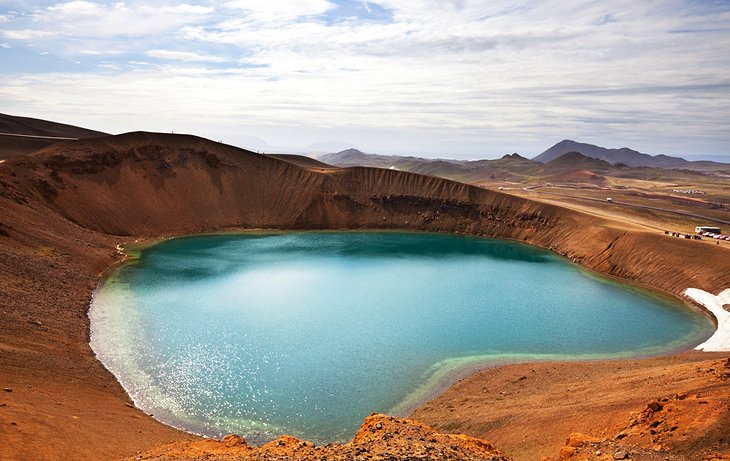
In the northern region of Vatnajökull National Park, the Askja caldera and the geothermal pool in the Dyngjufjöll Mountains are not for the faint-hearted. However, if you'd like to say you've taken a dip in a live volcano, then this is for you.
Askja is an impressive 50 square kilometers in size. The surrounding mountain range was formed during volcanic activity, and Askja was partly created by an eruption of burning ash that collapsed the roof of the central volcano's magma chamber.
The water in Viti , the geothermal pool and volcanic crater, is generally around 30 degrees Celsius. A word of warning, the banks can be very slippery, particularly in wet weather.
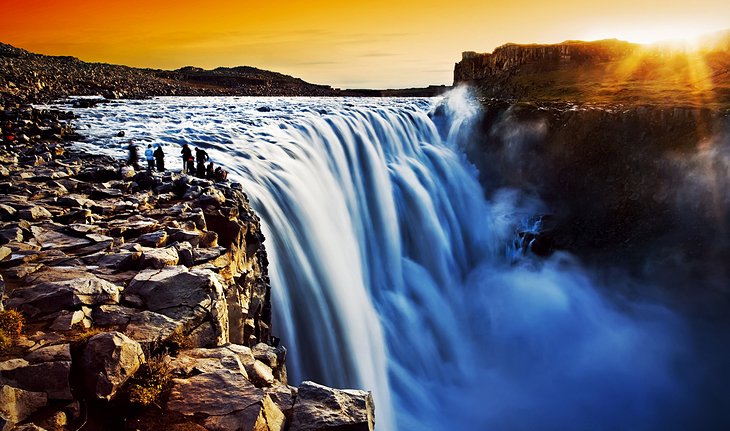
Dettifoss, in the north of Vatnajökull National Park, truly is a breathtaking example of the raw power of nature. Plunging 45 meters and with a width of 100 meters, it's said to be the most powerful waterfall in Europe.
Generally, it's best to approach on the east side of the River Jökulsa, where the road is better. Along easy paths from Dettifoss, Selfoss is a smaller waterfall around one kilometer upstream with a drop of around 10 meters. Below Dettifoss, the Hafragilsfoss waterfall tumbles 27 meters into a steep canyon. It's more advisable to drive than walk to Hafragilsfoss.
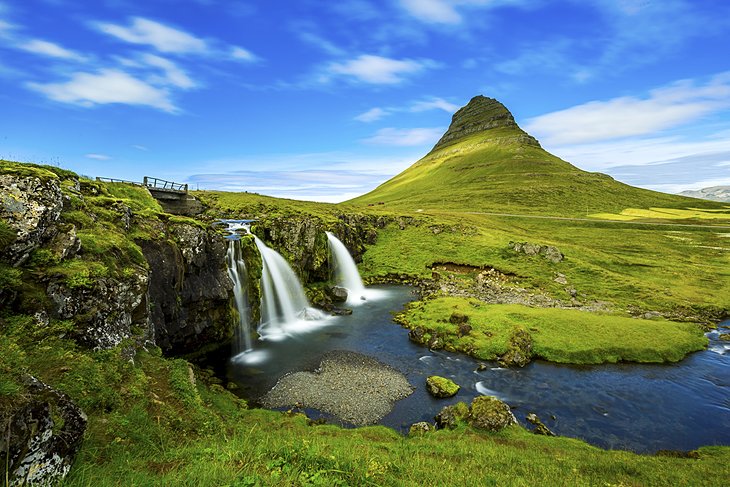
Around 2.5 hours' drive northwest of Reykjavik is the small town of Grundarfjördur, a charming fishing village centrally located on the north coast of the Snaefellsnes peninsula. The town lies in a picturesque fjord, surrounded by mountains, with Mt. Kirkjufell looming as a striking landmark.
Dotted about the surroundings, you'll discover small streams and waterfalls. During winter, Kirkjufell is a great place to watch the awe-inspiring northern lights . Eyrbyggja Heritage Centre holds exhibitions on Grundarfjördur's seafaring history and is the information center for the whole peninsula.
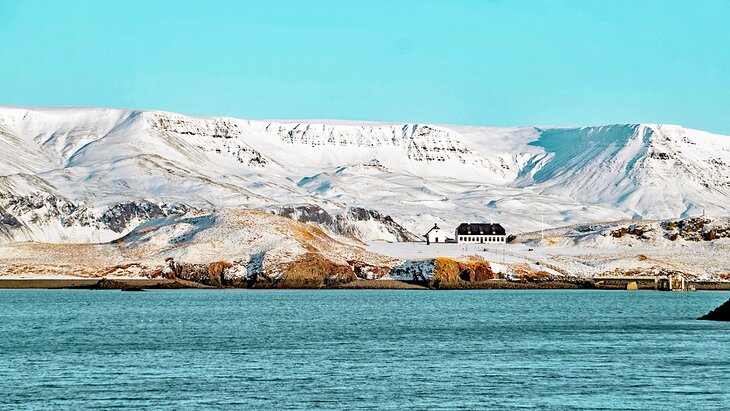
A 30-minute easterly drive from Reykjavik brings you to Mount Esja in Kjalarnes. The mountain is 914 meters high and very popular with hikers. Even for the inexperienced climber, it's a relatively easy hike. There are terrific views of Reykjavik and the surrounding landscape and ocean.
You can take several routes to the summit depending on your energy levels and how much time you have. You can get to the main starting point at Mount Esja by a 10-minute bus ride on public transportation that leaves out of the Hlemmur main station towards Artun. Check bus schedules and times before your visit.
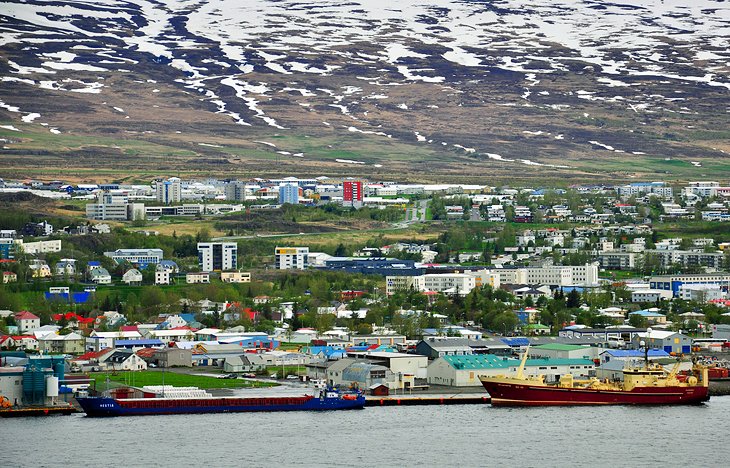
In the north of the country, Akureyri lies amid mountains on the longest fjord in Iceland about 40 kilometers south of the Arctic Circle. With a population of around 18,000, Akureyri's landscape and culture make it one of the best cities in Iceland . Summer days occasionally reach 25 degrees Celsius, and although winters bring heavy snowfall and cold weather, calm and still weather generally prevails.
Despite the town's isolation, cultural life and entertainment flourish here, and a wide range of shops offer brand-name products. The skiing area is the best in the country. Points of interest include the Akureyri Museum and the impressive Aviation Museum at Akureyri Airport .
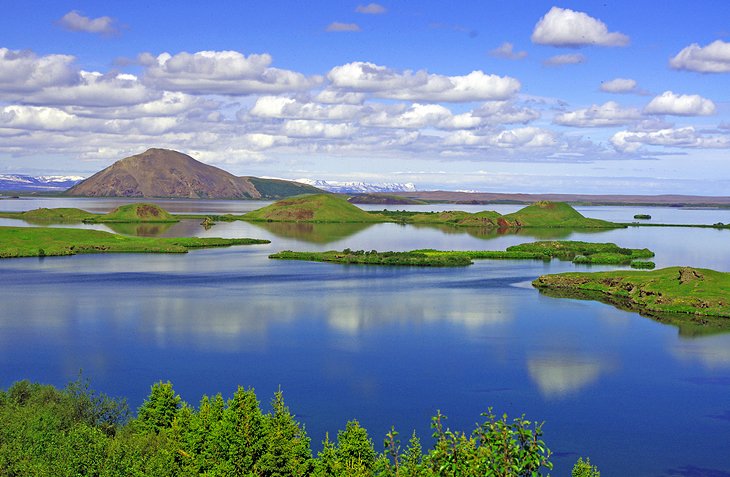
A little over an hour's easterly drive from Akureyri is Myvatn in northern Iceland. It is a lake district famous for its wealth of birdlife, rich fauna, and large shallow body of water. It's estimated that the area was formed around 2,500 years ago by a gigantic lava eruption.
Today, the surroundings are volcanically active, with an eruption occurring as recently as the mid-1980s. Bubbling clay pits, sulphuric fumes, and lava formations all form part of this unique landscape, which is still in flux.
One of the most interesting scenic features of Myvatn is the rootless vents formed by the volcanic eruption. While the landforms resemble craters, they did not have a lava flow, but the volcanic activity still resulted in their creation, adding to a stunning and unique appearance around the lake.
The name Myvatn literally means "midge-water," a reference to the prolific midges here, especially during summer, so be sure to pack some insect repellent. The area is also a bird-watcher's paradise.
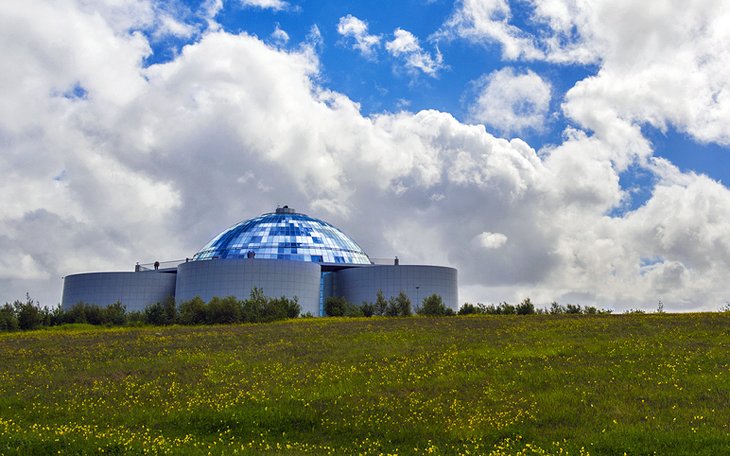
Originally the site of the city's gigantic thermal water tanks, " Perlan ," as it's known locally, is one of Reykjavik's landmark buildings. It occupies an enviable location on Öskjuhlíð hill, where there are in excess of 176,000 trees.
The hill is particularly pleasant, with bicycle trails and footpaths zigzagging up and down. The observatory affords stunning views over the city. Also on-site is a revolving restaurant , as well as gourmet and souvenir shops.
In addition, Perlan regularly hosts concerts and exhibitions in the Winter Garden. The observation deck is a real treat. The new planetarium is spectacular with a virtual trip of Iceland featuring the country's natural elements.
Address: Varmahlíð 1, 105 Reykjavík
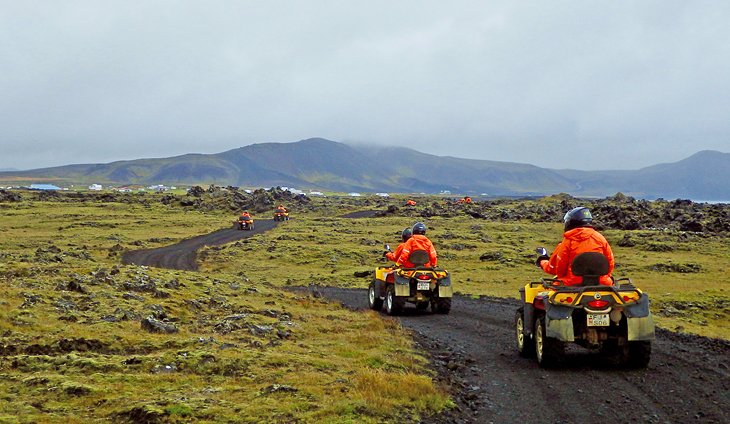
A popular thing to do and one of the most adventurous ways to experience Iceland is on the back of an ATV, trekking across rugged lava fields, riding up dormant volcanos, and passing pastures with roaming wild Icelandic ponies.
These are views of Iceland that you will never forget and one of the best ways to get up close to the country's most scenic natural environment. Tours like the two-Hour ATV Quad Tour from Reykjavik lets you experience ATV off-road adventure without a huge time commitment. Many tours depart from Reykjavik but they are available in most regions of the country.
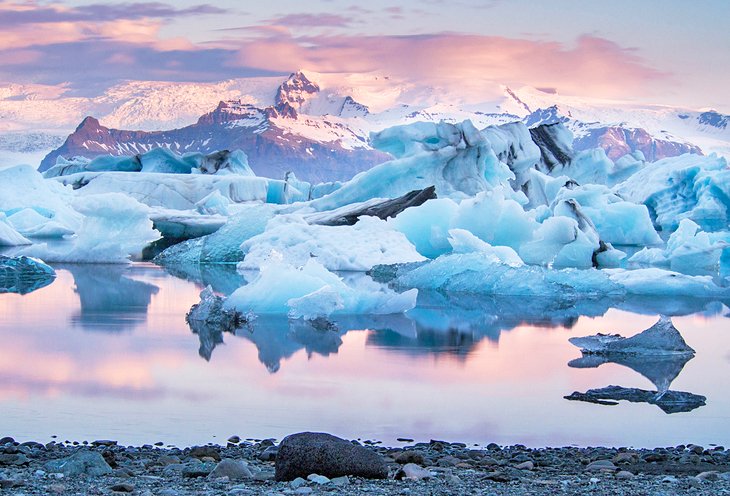
While Iceland is full of natural wonders, one of the most spectacular is the Jökulsárlón Glacier Lagoon. You will ride in a boat through large chunks of ice that have separated from the glacier.
The floating ice in the lagoon ranges from the size of small pebbles to the size of cars, but since you are floating in the lagoon with them, they are close enough to touch. Witness the blue hue of glacial cave formations and birds flying above in this natural environment.
The South Coast and Jökulsárlón Glacier Lagoon Day Tour from Reykjavik is a popular tour for visitors who want to set up a home base for their visit to Reykjavik and do a day trip to this top attraction. The tour also includes visits to two beautiful waterfalls and spectacular views of mountains and glacial rivers along the south coast.
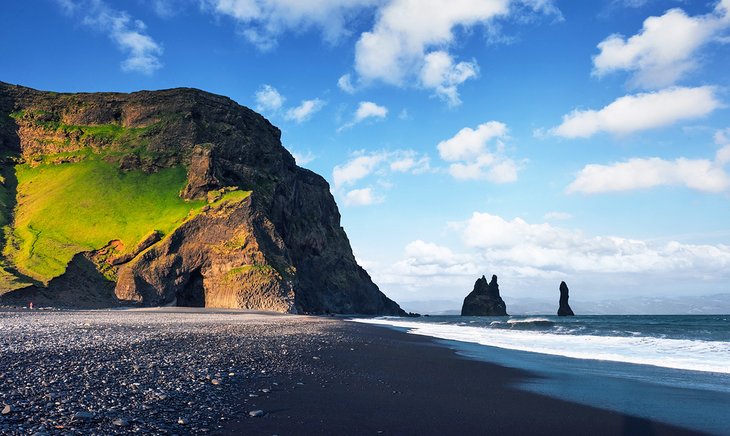
While Iceland has some stunning beaches, the Reynisfjara black-sand beach on the country's southern coast has an other-worldly appearance. This unique beach is known for its black sand and rocky sea stacks that protrude from the oftentimes ferocious waves coming in from the Atlantic Ocean.
The eerie yet stunning landscape of natural beauty at Reynisfjara beach is one of the reasons it was selected as a filming location for films like Star Wars. The lighting at this beach adds to its contrasting allure, which is why it is a must-visit for anyone who enjoys photography.
As with many natural locations in Iceland, Reynisfjara black-sand beach has dark folklore associated with it. Iceland legend says that the rocky basalt sea stacks were once trolls pulling seafaring ships to shore in the night, and they turned to stone during sunrise.
You are not likely to see any trolls during your visit, but you might see some of the thousands of seabirds, like puffins, guillemots, and fulmars, that nest in the columns.
The 2.5-hour drive to the beach is easy from Reykjavik, or you can take a guided trip along the southern coast that includes this as a stop if you want to spend more time at some of the other features on that side of the island.
Read More: Best Black Sand Beaches in the World
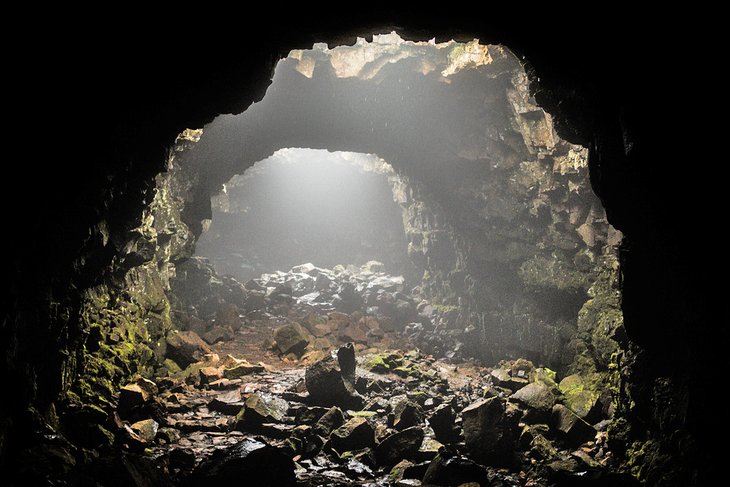
The land of fire and ice has so many intriguing natural elements that visiting is an exciting science lesson into how volcanos work. One way to find out is by visiting the Raufarhólshellir lava tunnel in southwest Iceland.
At 4,461 feet, it is one of the longest lava tubes in the country. You can take a guided tour through the cave to get up close to the stunning lava rock formations and colorful walls that have formed below the earth.
A tour through the tunnel will walk you through the path where lava flowed during a volcanic eruption of the Bláfjöll Mountain Range more than 5,000 years ago. These tunnels were formed as flowing magma hardened and thickened, creating a crust roof resulting in a lava tube.
Outside the lava tube, you will see stunning green moss covering lava rock and craters formed from the eruption. It is only about a half hour from Reykjavik, and you can visit year-round. If you visit in the winter, plan on wearing extra layers and sturdy boots for icy and wet conditions.
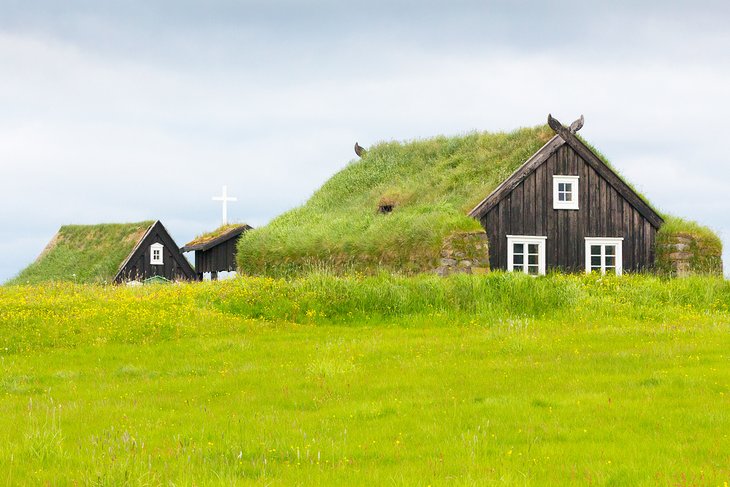
Iceland has an intriguing history of Vikings that settled on the island and folklore involving trolls and other creatures that still influence the culture today. One of the most interesting ways to learn about the varied tentacles of Icelandic culture is by visiting some of its museums. Some of them are seemingly mainstream, while others, sometimes found off the beaten path, explore some rather unusual finds.
In Reykjavik, the National Museum of Iceland is a good place to visit to explore Icelandic history and settlement. The Saga Museum also gives insight into the Viking heritage, with life-sized replicas of early settlers, offering a nice history lesson before you venture into some of the other types of museums.
Start your quirky museum visit with The Punk Museum on the back street of Reykjavik, which delves into Iceland's punk music scene that emerged in the 1970s. The Árbær Open Air Museum (within the Reykjavik City Museum) is another experience worth trying as you see more than 20 buildings that form a small early settlement village.
Not far from Reykjavik in Njarðvík is the Viking World Museum , which has an exact replica of a Viking ship that was discovered in Norway in the late 1800s and exhibitions detailing the Norse settlement.
One of the more unique museums in Iceland is the Sigurgeir's Bird Museum at Mývatn . The tiny museum features a collection of more than 300 preserved bird specimens representing over 180 species and an extensive collection of eggs.
The Library of Water in Stykkishólmur will give you insight into Iceland's natural environment, with dozens of columns holding water from ice caps. The Nonsense Museum in the Westfjords is a quirky stop to enjoy a large collection of random items, from sugar cubes to police hats that came from forces around the world.
For those who are interested in a deep dive into the history of Iceland's folklore, you should visit The Museum of Icelandic Witchcraft and Sorcery in the Westfjords in Hólmavík village. This museum gives insight into some of the tales and history on which Icelandic beliefs are based. This can be a tough visit for some, and parents should give it a preview before taking their children inside.
When it comes to Iceland, the scenery is naturally stunning year-round, but certain times of the year are better than others to catch some of its most sought-after attributes.
For most visitors, the best time to visit Iceland is in the summer . But, the best time can also depend on what you want to experience. Do you want to catch a glimpse of the northern lights, visit when there is the most hours of daylight, or navigate the Ring Road with no snow? Or, do you want to travel during the low season to get the best rates on hotels and airfare? All of these factors matter when determining the best time to go to Iceland for your specific travel priorities.
Each season in Iceland comes with unique opportunities for exploration and the natural experiences that the island is famous for, like the midnight sun, aurora borealis, and hot springs.
Summer : Summer is hands down one of the best times to go to Iceland. It is the season with the best weather conditions, comfortable temperatures, the best opportunities for sightseeing, and when the roads and hiking trails are open and dry.
You get a front-row seat to the midnight sun. From May through August there is complete sunlight at midnight . While 24 hours of daylight makes it tough to sleep during your trip, it gives you more time to experience all that there is to see and do in Iceland. Summer is a great time to see minke whales out of Reykjavik.
Fall: The fall season is a lovely time to visit Iceland, when temperatures are slightly cooler, the summer tourists are gone, and the weather conditions are still favorable to do things like trekking on a glacier and riding an ATV over lava fields.
Fall colors on the trees are pretty, especially if you are horseback riding or hiking on one of the mountain trails. As fall dips into November, your chances of seeing the northern lights increase, and roads may start to close due to weather conditions. It is also a nice time to visit the Blue Lagoon when there are not so many tourists.
Winter: Winter days in Iceland can have almost 19 hours of darkness. It has the most inclement weather, but the top reason for visiting in the winter months is the chance to see the elusive northern lights. Prices will be cheaper for accommodations, and you will have plenty of availability on tours since it is the off-season.
Winter is a great time to take advantage of the snowfall in Iceland, with excursions like exploring ice caves and snowmobiling. It can be a fun time to visit the Blue Lagoon and the local hot springs where you can warm up – that is, until you get out.
Spring: Early spring in Iceland may still have snow-covered roads, but the days are starting to get longer. You also still have a chance to catch the northern lights during your visit. This shoulder season may limit some winter activities as they come to an end, and some summer excursions may not be available yet.
Spring is a great time to go whale watching, with many kinds of tours available out of Reykjavik. Spring is when you can catch a glimpse of another of Iceland's famous animal residents, the puffin, the unusual-looking bird that is more active in the spring.

More on Iceland
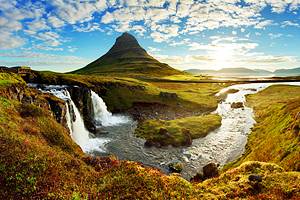
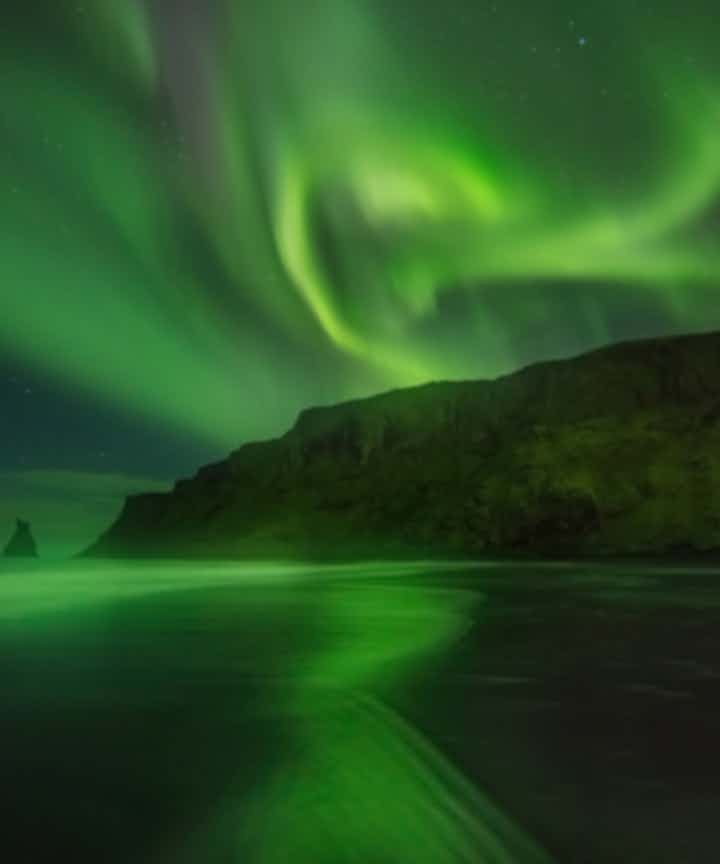
Welcome to Iceland
Select starting location
Select dates
Add travelers
Top things to do in Iceland
Book your complete trip with the best companies only

Explore an Ice Cave

Visit a Live Volcano

Find the Northern Lights

Visit the Blue Lagoon

Go on a Road Trip

Do the Golden Circle

See the Glacier Lagoon

South Coast Tours
Best travel plans in iceland.
Book an optimized itinerary for a perfect vacation in Iceland
10-Day Self-Drive Tour of the Complete Ring Road of Iceland with Top Attractions & Snaefellsnes
9-day summer self-drive tour of the complete ring road of iceland with a focus on the south coast, epic 13-day self-drive tour of iceland's complete ring road with snaefellsnes peninsula & westfjords, 7-day self-drive tour of the complete ring road of iceland, top tours in iceland.
Discover all the best tours and tickets in Iceland
Best Ice Cave Tour in Vatnajokull Glacier Starting from Jokulsarlon Glacier Lagoon
Inside the volcano thrihnukagigur tour with transfer from reykjavik, the katla ice cave tour, skaftafell glacier hiking tour on vatnajokull, 1-hour zodiac boat tour of jokulsarlon glacier lagoon, snowmobile tour on langjokull glacier with transfer from gullfoss waterfall, blue lagoon comfort ticket, snorkeling tour between continents in silfra with free underwater photos & snacks, top attractions in iceland.
Explore all the places that you can visit in Iceland
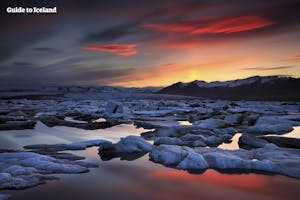
Jökulsárlón Glacier Lagoon

Seljalandsfoss
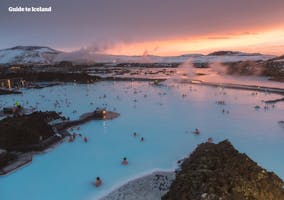
Blue Lagoon

Snæfellsnes

Best travel tips for Iceland
Find all your essential travel information for Iceland
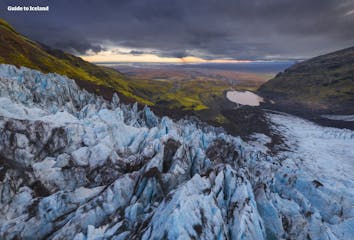
18 Things To Do & Places to Visit In Iceland

Best Attractions by the Ring Road of Iceland
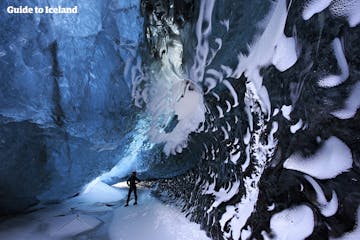
The Top 10 Best Tours in Iceland: Popular and Unique Excursions

The 30 Best Hot Springs and Geothermal Pools in Iceland

Northern Lights in Iceland - When & Where To See the Aurora

Waterfalls in Iceland
Travel community.
Join the largest travel community in Iceland
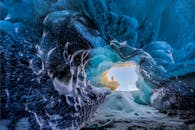
Local companies

Local specialists
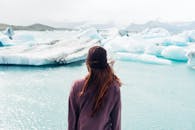
Local bloggers

Travel bloggers
Photos of iceland.
See Iceland through the eyes of Iurie Belegurschi
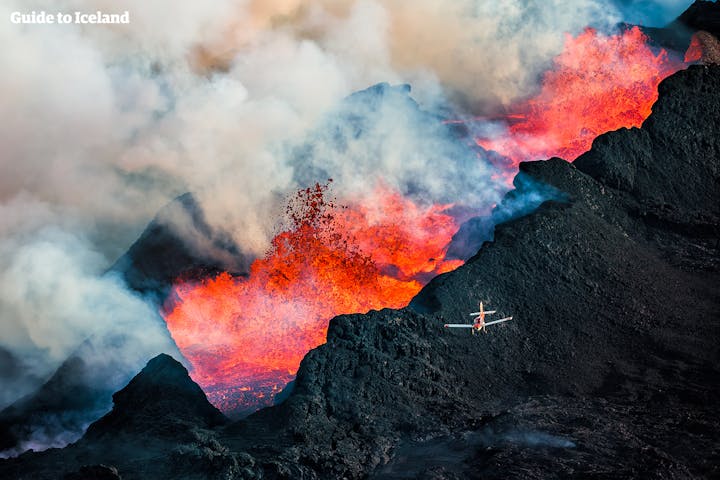
Download Iceland’s biggest travel marketplace to your phone to manage your entire trip in one place
Scan this QR code with your phone camera and press the link that appears to add Iceland’s biggest travel marketplace into your pocket. Enter your phone number or email address to receive an SMS or email with the download link.
- Share full article

Aurora Tourism in Iceland: You Can Seek, but You May Not Find
The country markets itself as a destination to see the northern lights — especially this year, which is a peak time for solar activity. But they can be elusive, as one writer recently found.
In Reykjavík, Iceland, aurora borealis tourism is a booming business. Hopeful tourists board buses to head out into the night in search of the northern lights. Credit... Sigga Ella for The New York Times
Supported by

By Amelia Nierenberg
Amelia Nierenberg spent four nights searching for the northern lights in Iceland.
- March 25, 2024
From the outside, it may seem like the northern lights dance across Iceland’s skies each night. On Icelandair ads, planes fly across shimmering curtains in the sky. On social media, travelers gaze at the green bands above them . The lights are even on some recycling bins in Reykjavík, the capital: “Keep Iceland Clean.”
In the past decade or so, an aurora borealis industrial complex has boomed in Iceland. Many rent a car and go out on their own, but there are northern lights big bus tours and northern lights minibus tours and northern lights Super Jeep tours . There are private guides and boat cruises . There’s an observatory base camp . There’s even a museum .

But the lights can be elusive.
“Tourists sometimes expect, like, ‘At what time do you turn them on?’” said Björn Saevar Einarsson, a forecaster at Iceland’s meteorological office , chuckling. “Like we have a switch in the back room.”
This year, the letdowns are especially intense.
The northern lights, which are also called the aurora borealis, are most visible when there are solar flares, which are big eruptions on the sun that send charged particles toward Earth. This year, the sun is approaching the peak of its 11-year cycle of activity , which some assume means that the displays could peak, too.
But the enhanced solar activity doesn’t necessarily mean the northern lights will be brighter or more frequent, scientists wearily explain. Instead, they mostly mean that the lights can be seen farther south than usual: In recent months, they have been visible in Arizona , Missouri and southern England .
That doesn’t mean much for Iceland.
In fact, Icelanders and scientists said, this winter is nothing special. Sometimes, the lights are there. Sometimes, they aren’t. Just like always.
Hunting the lights
But nothing special, with the northern lights, is still very special. And so tourists keep coming .
Last month, I joined the fray. For four nights, I looked for telltale sky shimmers in and around Reykjavík.
I booked my tickets riding high — this was the best year yet, right? But as I learned more, and as my flight neared, my hopes ebbed. Scientists and tour leaders gently told me that the skies were cloudy and the solar activity seemed quiet.
“Just to let you know the forecast doesn’t look too good” Inga Dís Richter, the chief commercial officer at Icelandia , a tourism agency, wrote in an email two days before I planned to take a minibus trip with Reykjavik Excursions , one of its tour operators.
“But,” she added, “this can change.”
To find the lights, guides and travelers often rely on aurora forecasts, which overlay cloud cover and solar activity. They check them constantly, like a bride with an outdoor wedding in mid-April.
Some of the forecasts are free, like the aurora forecast run by Iceland’s meteorological office or Iceland at Night , which includes space weather. (Some are not — Aurora Forecast , which costs $12.99 a year, sends alerts.) Many people also turn to Facebook pages , where enthusiasts hungrily swap sightings.
Luck, though, is everything.
“There’s only one thing less predictable with the northern lights, and that’s the Arctic weather,” said John Mason, a global expert on the northern lights. “An aurora forecast is barely worth the paper that it’s written on.”
The guides work hard to explain the science, and set expectations. Most companies offer a free rebooking option if the lights do not show.
On my first night of aurora stalking, despite Ms. Richter’s warnings, I joined an expectant group on the Reykjavík Excursions minibus. For $88, I got a seat on the 19-person bus, which left the city’s central bus station at 9:30 p.m.
Over the next three to four hours, we would drive through the Icelandic night together. I’d either see something astonishing with these strangers — the sky, banded with light — or shiver with them shoulder-to-shoulder, awkward in the cold.
As we pulled onto the road, Gudjon Gunnarsson, the guide, set the mood early. “We are going hunting for the lights,” he said, emphasizing the word “hunting,” “similar to going out fishing in a lake.”
He drove for about 45 minutes, letting Reykjavík’s glow fade behind us. The city has about 140,000 people, and no real skyscrapers, so there’s limited light pollution. Although the northern lights can appear over the city, it’s best to see them in total darkness.
Then he paused and consulted with another guide.
“It is too cloudy here,” he told his flock. “So we will keep driving.”
But as we kept driving, clouds turned to a dense fog, so thick that the moon all but disappeared.
Mr. Gunnarsson turned off the main highway about an hour after we left Reykjavík. He parked in a parking lot. Or maybe it was a side street? The darkness was so deep that I could only make out the moonlight on the ocean, and only then after my eyes adjusted.
We disembarked and stood dutifully beside him, staring up at the sky. Then, one woman pointed toward Reykjavík. Were those the lights? (No. That was light pollution.)
Christof Reinhard, 65, who owns a medical laser company and was visiting with his family from Paris, mused that our search was a little bit like a safari. Sure, the desert is amazing, but it’s much better with lions. Or, maybe, was this more like a whale watch?
“Instead of a boat,” he said, “you have a bus.”
Mr. Gunnarsson watched the group stomp their feet and bend into the wind. Fifteen minutes. Then, half an hour. The clouds hung thick above. “There’s nothing happening here, as you can see,” he finally said to relieved chuckles. “It’s one of those nights where you just have to give up.”
Tourists can get mad, Mr. Gunnarsson and other guides said. It’s rare, but it does happen.
“It’s the trip that has our worst reviews,” said Eric Larimer, the digital marketing manager for Gray Line Iceland , a day tour and airport transport company.
A wake-up call for the aurora
For some, the joy is in the search, even if there is no find. A few focus on astronomy, often opting to stay at Hotel Rangá , which is just off the main ring road (Route 1) near Iceland’s south coast.
The hotel looks unassuming — low-slung and wooden — but it’s one of the most famous in Iceland. (The Kardashians stayed there . So did the Real Housewives of Orange County .) A standard room costs more than $300, depending on the season.
But Rangá doesn’t just cater to celebrities. It also draws astronomy buffs, enticed by its “aurora wake-up call” service and its observatory, which has state-of-the-art telescopes.
“One thing is to sell them,” said Fridrik Pálsson, the hotel’s owner, speaking of the northern lights. “Another thing is to deliver them.”
About 20 years ago, before the northern lights industry took off, he delegated the night security guard to monitor the sky. The guard pokes his head out every few minutes to look for the telltale flicker. If he sees the lights, he alerts the guests.
The service aims to address one of the main issues with hunting for the northern lights: They are usually only visible on winter nights, when it is very cold, very windy and very late.
“To be a good northern lights observer, you need the constitution of an insomniac polar bear,” Dr. Mason said.
My room phone, alas, stayed silent. But I did dream about the lights — great Wonka colors swirling, strangely, behind the Chrysler Building.
Mr. Pálsson built the observatory, too. Even if the lights didn’t show up, he figured, the stars are still magnificent — and, for city dwellers, also rare. The hotel contracts astronomers to work the telescopes and explain the stars to guests.On my second night in Iceland, as twilight slipped below happy-hour skies, I crunched across the snow to the observatory with Saevar Helgi Bragason, an Icelandic science communicator who leads the astronomy program.
He bent into a toddler-size telescope, focusing it on the moon’s craters. They looked clearer than the hotel, just a short walk away. It was too early for the lights, he said. And that evening seemed too cloudy (on Earth) and too quiet (on the sun).
Mr. Bragason joked that the lights can get in his way — they create a mist over the stars he really wants to see. But tourists often come specifically to see them. And sometimes, he said, as they wait impatiently, they can miss the real wonder.
“You’re left with these beautiful skies above you,” he said. “Basically, literally, another universe opens up.”
Creating a lights season
Hotel Rangá was a pioneer in Iceland’s northern lights tourism industry: About two decades ago, people came to Iceland for the long summer days, and left as daylight slipped farther south.
“I found it rather stupid in the beginning,” admitted Mr. Pálsson, the owner of Rangá, speaking of northern lights tourism.
But spreading tourism throughout the year made sense. Partly, that was an environmental concern. The tourists would crowd the country’s extraordinary natural sites over just a few months. It was also economic. When the visitors left Iceland, tourism jobs would ebb with the sunlight.
So the northern lights, which are reliably visible from September to March, became the backbone of the country’s winter branding, said Sveinn Birkir Björnsson, the marketing and communications director at Business Iceland , which promotes the country.
“To be able to sell this product of cold and darkness, you have to have something to offer,” he said.
Now, even though June, July and August are the busiest months, tourism has evened out over the seasons. In 2023, there were about 1.1 million international visitors to Iceland during the aurora months, based on departures from Keflavík Airport, according to data from Iceland’s tourist board . From April to August, there were about 1.1 million, too.
About a decade earlier , when tourism overall to Iceland was lower, there were about 336,000 departures from the main airport in colder months, and about 446,000 in the spring and summer.
The winter travelers are drawn by the lights — and the hot springs, glaciers and icy waterfalls. It’s also cheaper than the summer season.
Some try to visit volcanoes , but the country recently warned tourists to avoid the lava flows — Iceland is living in an unusually active period of seismic activity . In January, lava flowed into a small town and last week a volcano erupted with just 40 minutes’ notice near the Blue Lagoon thermal springs, one of the country’s biggest attractions.
The final attempts
Near midnight on my last night, a Sunday, I drove to the Grótta Lighthouse , a popular spot on the outskirts of Reykjavík.
A few die-hard experts had warned me off — many tourists go there because it’s darker than most of Reykjavík, but then don’t think to turn off their headlights. It was also raining, greatly diminishing my chances of seeing the lights.
But I only had three hours before I had to leave to make my predawn flight. I felt a little desperate, a little dazed. I parked, and approached two people who were sitting in the rain on a wet wall, looking at the water in the darkness. I climbed over seaweed, and introduced myself. What would it mean to them, I asked, if the lights suddenly appeared?
“It’d be a little bit like the cherry on top,” said Catherine Norburn, 29, who was visiting from England.
She and her husband were set to fly out the next morning. They had not yet seen the lights.
“We don’t have high hopes,” said her husband, Reece Norburn, 29, “but it’s now or never.”
We didn’t see the lights. And I didn’t see them later, even after pulling off the highway halfway between Reykjavík and the airport at 3:30 a.m., half convinced by a shimmery cloud.
But I did spend more time looking up at the sky. And it’s a marvel.
In New York City, where I live, the night sky blooms orange-mauve. In Iceland, the nighttime darkness is just that — darkness. Clouds roll, breaking the deep blue. Stars actually shine. Northern lights or no northern lights, it was still cosmically beautiful.
Amelia Nierenberg writes the Asia Pacific Morning Briefing , a global newsletter. More about Amelia Nierenberg
Open Up Your World
Considering a trip, or just some armchair traveling here are some ideas..
52 Places: Why do we travel? For food, culture, adventure, natural beauty? Our 2024 list has all those elements, and more .
Mumbai: Spend 36 hours in this fast-changing Indian city by exploring ancient caves, catching a concert in a former textile mill and feasting on mangoes.
Kyoto: The Japanese city’s dry gardens offer spots for quiet contemplation in an increasingly overtouristed destination.
Iceland: The country markets itself as a destination to see the northern lights. But they can be elusive, as one writer recently found .
Texas: Canoeing the Rio Grande near Big Bend National Park can be magical. But as the river dries, it’s getting harder to find where a boat will actually float .
Advertisement

IMAGES
VIDEO
COMMENTS
Situated in a narrow fjord, Siglufjordur is a small and picturesque Icelandic fishing town. Despite its relatively small size, it was once the main location for herring fishing in the North Atlantic. The population of the area expanded to 3,000 during the herring boom of the 1940s and 1950s, becoming the 5th largest town in Iceland, but has since declined due to the industry's decline.
4. The Husavik Whale Museum. The Húsavík Whale Museum is a non-profit organization established in 1997. The Húsavík Whale Museum is situated in Húsavík, a small town in north east Iceland, on the shores of Skjálfandi Bay, just below the Arctic Circle at 66° N.
Experience winter magic and fly directly to Akureyri in North Iceland with easyJet. North Iceland is the number one destination for winter activities, there are multiple attractions and tours available. Go skiing, off-piste or on groomed slopes and enjoy guided tours on Super jeeps, snowmobiles, snowshoes or dogsleds.
Kolugljufur Canyon. North Iceland is just the place to have a gorgeous canyon and waterfall right off the main road. Kolugljufur is home to a serene river that quickly falls off into Kolufoss. This waterfall is mesmerizing and unique due to the layers and ridges that make up the face of the falls.
3. Lake Mývatn. Lake Mývatn is one of the top North Iceland attractions you should visit, with fascinating volcanic geology to discover. If you take a Full Circle tour of the country, you can't miss this vast lake, situated close to the Ring Road. Mývatn is an ethereal expanse of shallow water that stretches over 37 square kilometres (14 square miles).
Where the Best North Iceland Attractions Can be Found: The Diamond Circle. Few visitors have heard of the Diamond Circle route, the northeastern counterpart to West Iceland's famous Golden Circle sightseeing route. Since most tourists tend to stay in the southern and western areas, the attractions of the Diamond Circle remain hidden secrets.
Things to Do in Northern Iceland & Places to Visit. 1. Dine, Drink, and Shop in Akureyri. f11photo / Adobe Stock. Address: Akureyri, Iceland. Located at the base of the Eyjafjörður Fjord, Akureyri is the largest town outside of the capital area, earning it the nickname "Capital of North Iceland.".
Visit Akureyri. Enjoy Godafoss waterfall. (head to Aldeyjarfoss if you have a 4WD) Sleep near Godafoss to see sunset - See photos and availability. Day 2. Head to Husavik - do a whale watching Tour. Visit the Whale Museum. Drive to Myvatn - 3 nights in Myvatn - Choose one of the lake Myvatn accommodations. Day 3 & 4.
Kálfshamarsvík. Kálfshamarsvík is a small cove with unusual, beautifully formed sea cliffs of columnar rock, created about 2 million years ago. It is located along the tourist route Arctic Coast Way. Places in North Iceland you don´t want to miss out visiting. Waterfalls, canyons, sea stacks, geothermal area, national parks, and lighthouses.
The most interesting of the artists' residences in Akureyri, Nonnahús was the childhood home of renowned children's writer Reverend Jón Sveinsson (1857…. 1. 2. Discover the best attractions in North Iceland including Drangey, Glaumbær, and Herring Era Museum.
Hofsós. The pool at Hofsós, with its idyllic views of the Skagfjordur Fjord, has put this small village on the map of tourist routes in northern Iceland. Discover what to see in Northern Iceland and the Trollaskagi Peninsula and plan your route around the most picturesque villages and natural attractions.
Europe. Iceland's mammoth and magnificent north is a geologist's heaven. A wonderland of moonlike lava fields, belching mudpots, epic waterfalls, snowcapped peaks and whale-filled bays - this is Iceland at its best. The region's top sights are variations on a couple of themes: the grumbling, volcanically active earth, and water and ice ...
2. Lake Mývatn. Close to the Krafla Volcano, Lake Mývatn is prized for its salmon and trout stocks, while the surrounding wetlands are protected as a natural park. The lake was created by an eruption 2,300 years ago and is embedded in a peculiar volcanic landscape of rootless vents and lava pillars.
North Iceland is a beautiful region, hosting some of the best attractions on the island. Explore North Iceland on one of these Akureyri tours or trips in the Myvatn area.. Home to the Lake Mývatn region, the town of Akureyri (otherwise known as the 'Capital of the North'), the whale-watching hot-spot of Húsavík and the northern parts of Vatnajökull National Park, the North attracts ...
A Geological Heaven. Two-day itinerary of Northern Iceland. Day one in Northern Iceland. Day 2 on Northern Iceland. Additional itinerary suggestions for Northern Iceland. 7 awesome things to do in Northern Iceland. 1. Go whale-watching in Húsavík. Other things to do in Húsavík.
Things to do in North Iceland. Go Whale Watching. Drive the Arctic Coast Way Rout. Take a ferry to the remote Grímsey. Taste a hot dog with fries. Try a full-throttle white water rafting tour. Go bathing in a beer bath. Drive the Diamond Circle. Bath in natural hot springs and spas.
Go off the beaten path and discover Iceland's hidden gems on a self-drive adventure of the Arctic Coast Way. The road takes you through 18 geothermal pools, 16 charming fishing villages, 6 islands, and many attractions unique to North Iceland. Visit the most remote areas in Northern Iceland and seek out wildlife that call the Arctic their home.
Incredible whale-watching tours depart regularly from Akureyri, Dalvik, and Húsavík. Being the largest northern city, Akureyri offers many day tours, as well as multi-day trekking tours into the stunning Highlands area. Guesthouses, tourist information centers, and most other tourism facilities can offer detailed information to help you choose.
Hit the slopes of Mt. Akureyri and enjoy the adrenaline rush while surrounded by breathtaking northern Iceland attractions. Skiing in Iceland offers a unique combination of adventure and natural beauty, making it an unforgettable winter experience. 11. Enjoy Vibrant Music Festivals in Northern Iceland.
List of places to visit in North Iceland. Attractions and sights in Northern area of Iceland, including Akureyri, Mývatn and Dimmuborgir.
This 900km route winds along the fjords of the northern coast from Hvammstangi to Bakkafjörður, passing pretty fishing villages, sandy beaches, craggy inlets and dramatic basalt rock formations. You can stop off en route to go hiking, seal-spotting, whale-watching, horse-riding, bathing in hot pools and even Arctic surfing.
Summertime brings long hours of daylight and midnight sun to North Iceland, and activities such as boat trips, hiking, horse-riding and whale-watching tours. The northern lights season is from September through April, while skiing is a magnet from December to around mid-April. Discover the Jökulsárgljúfur area of Vatnajökull National Park ...
22. Tour the Raufarhólshellir Lava Tunnel. 23. Visit Iceland's Quirky Museums. Best Time to Visit Iceland. 1. Explore Reykjavik by Foot. Colorful houses in Reykjavik. The best way to start your trip to Iceland is by sightseeing in the capital city of Reykjavik.
Your complete travel guide to Iceland. Find tips, book trips, affordable holidays or a self drive tour. ... 10-Day Self-Drive Tour of the Complete Ring Road of Iceland with Top Attractions & Snaefellsnes. ... Read our guide to the Northern Lights in Iceland. Find out what the aurora borealis are and the best places to see them, even in Reykjavik.
Whale watching is a major tourist attraction in Northern Iceland. getty. The most popular Icelandic cruise port is Reykjavik, followed by Akureyri in the north of the country, Isafjordur in the ...
Amelia Nierenberg spent four nights searching for the northern lights in Iceland. March 25, 2024. From the outside, it may seem like the northern lights dance across Iceland's skies each night ...